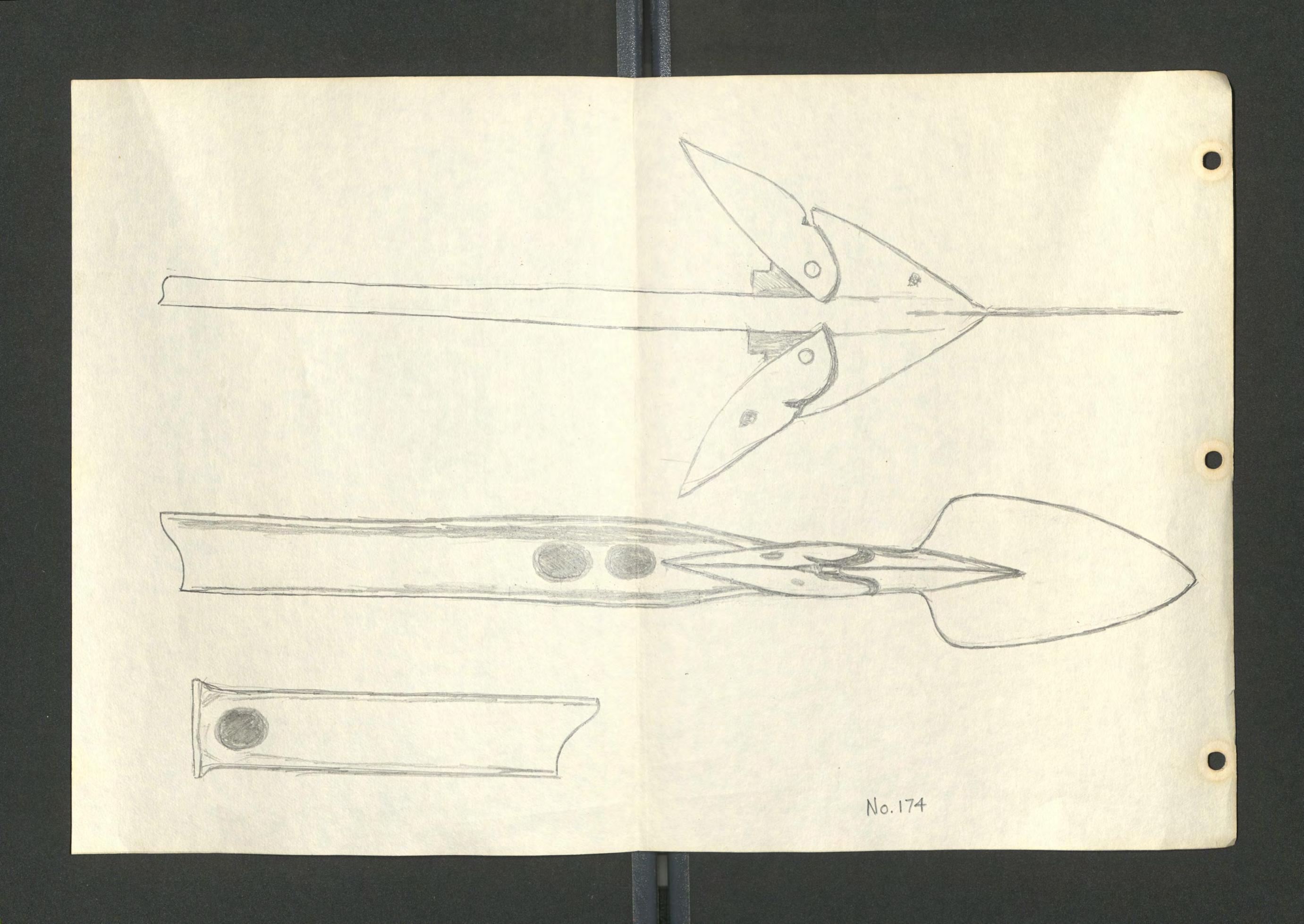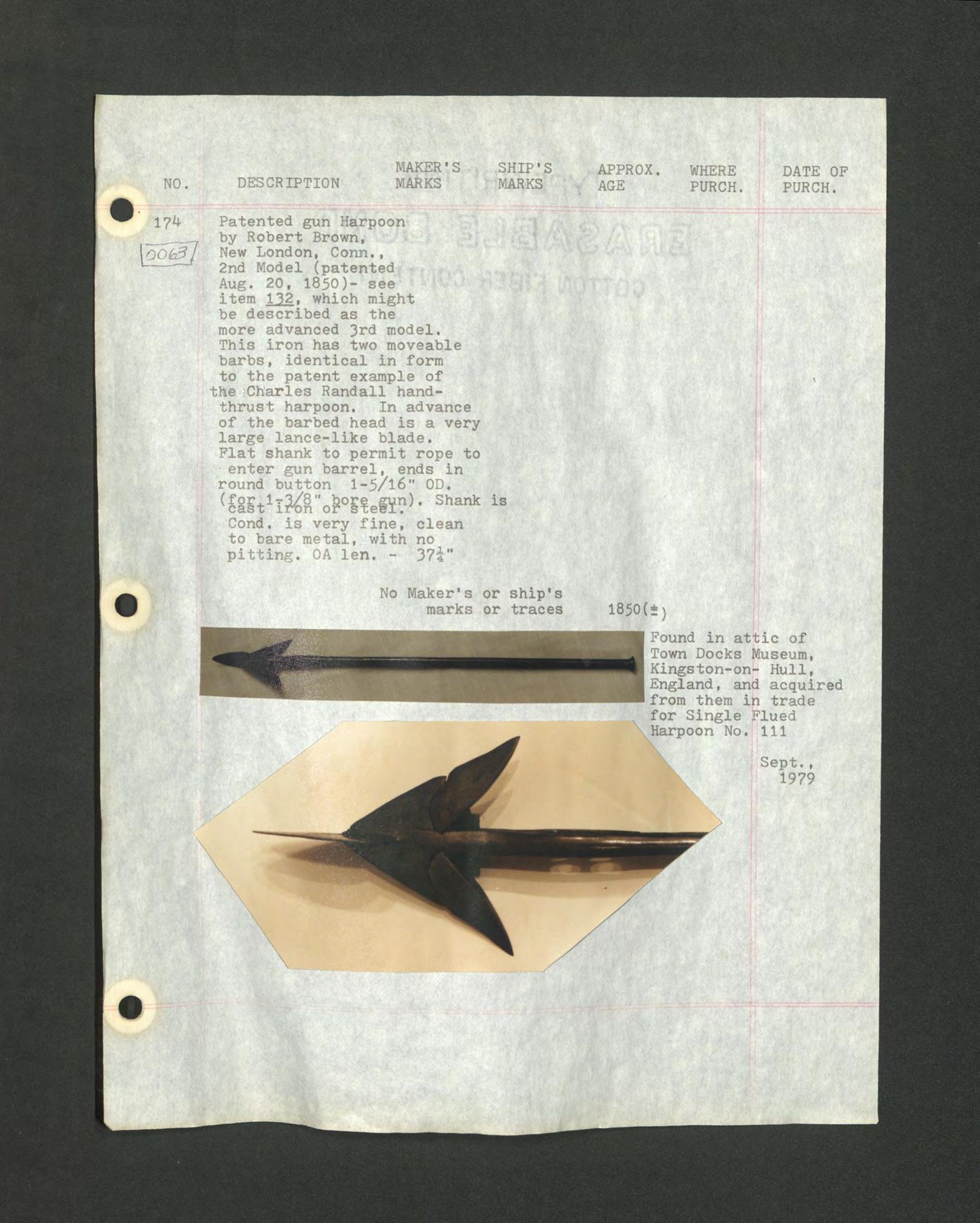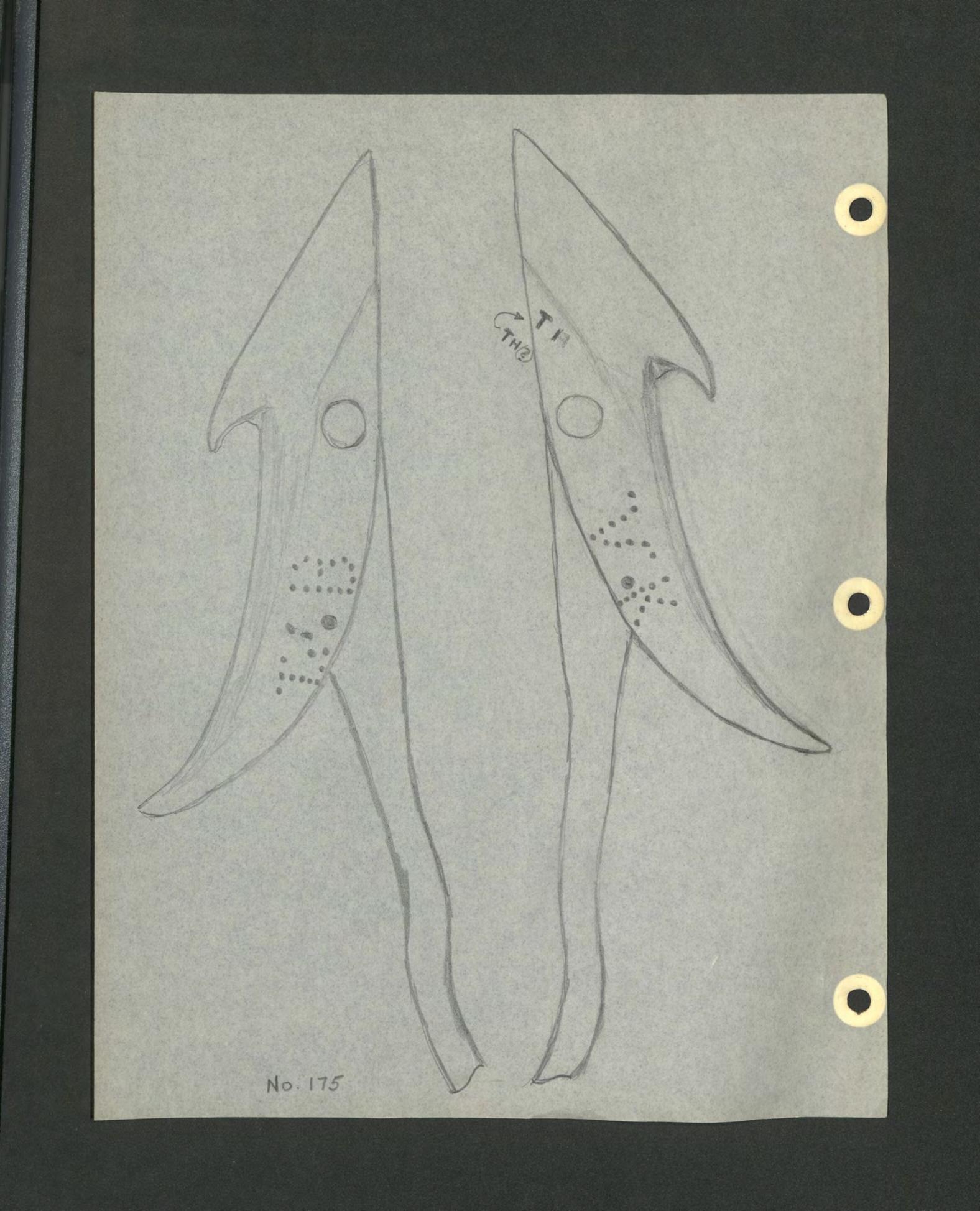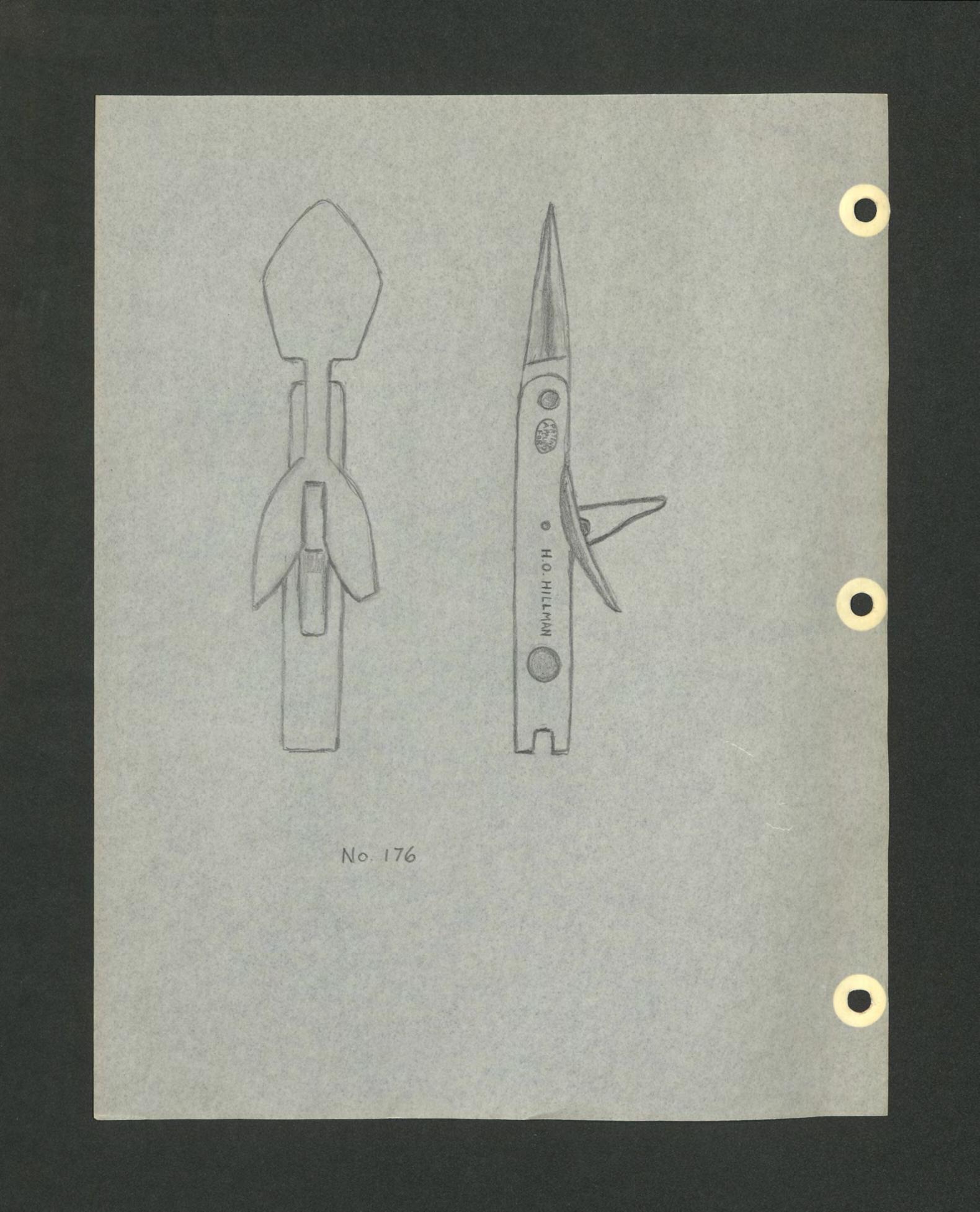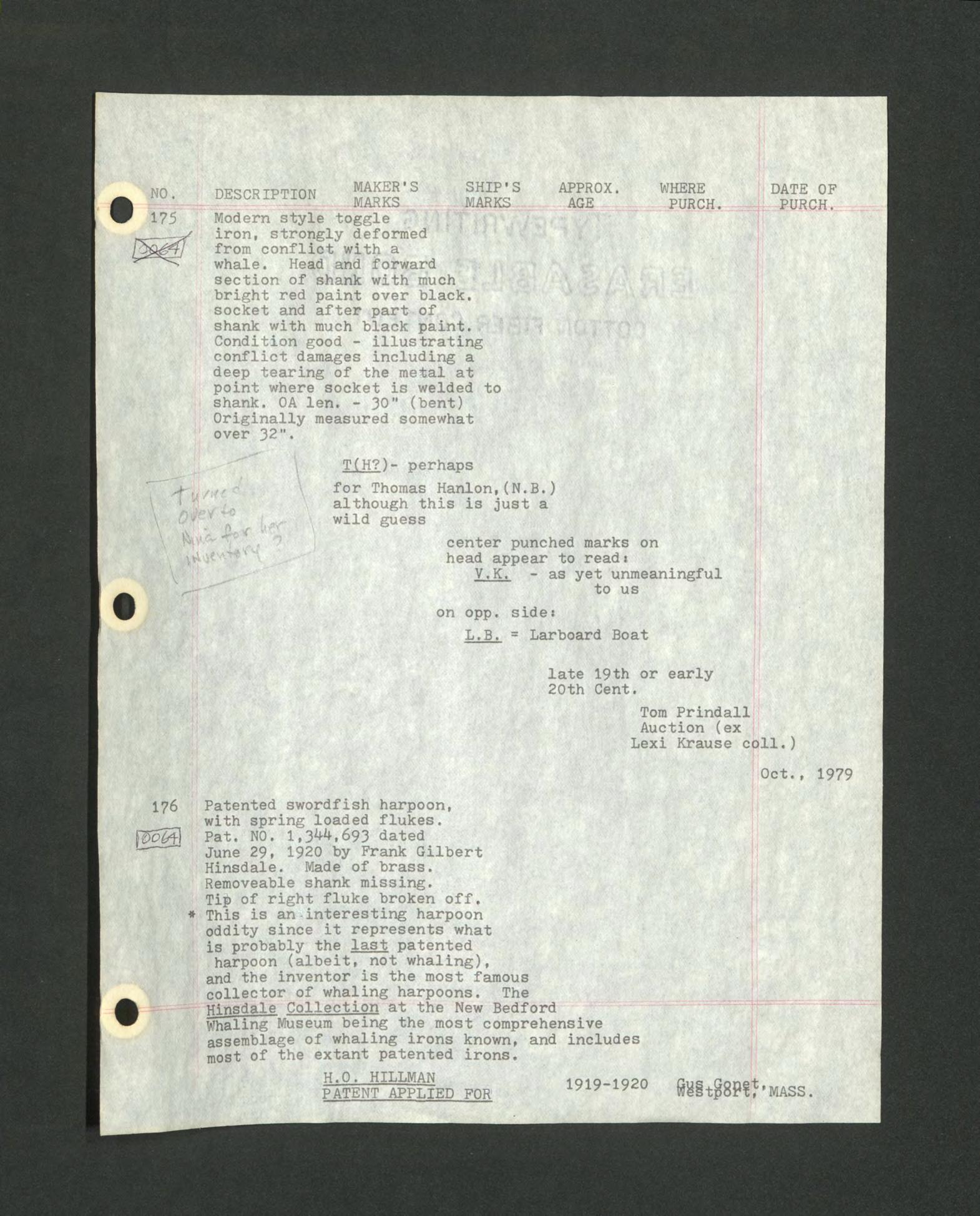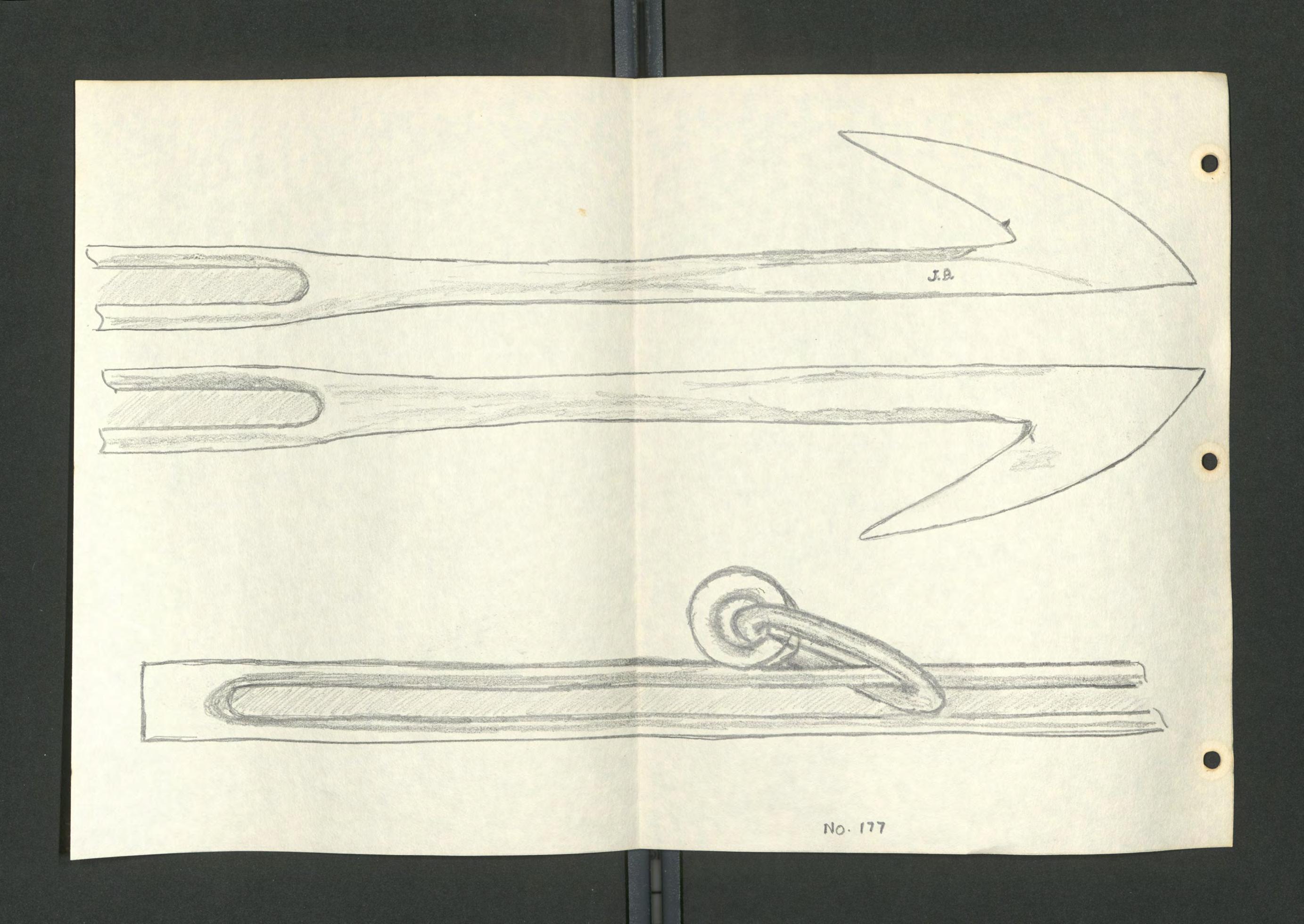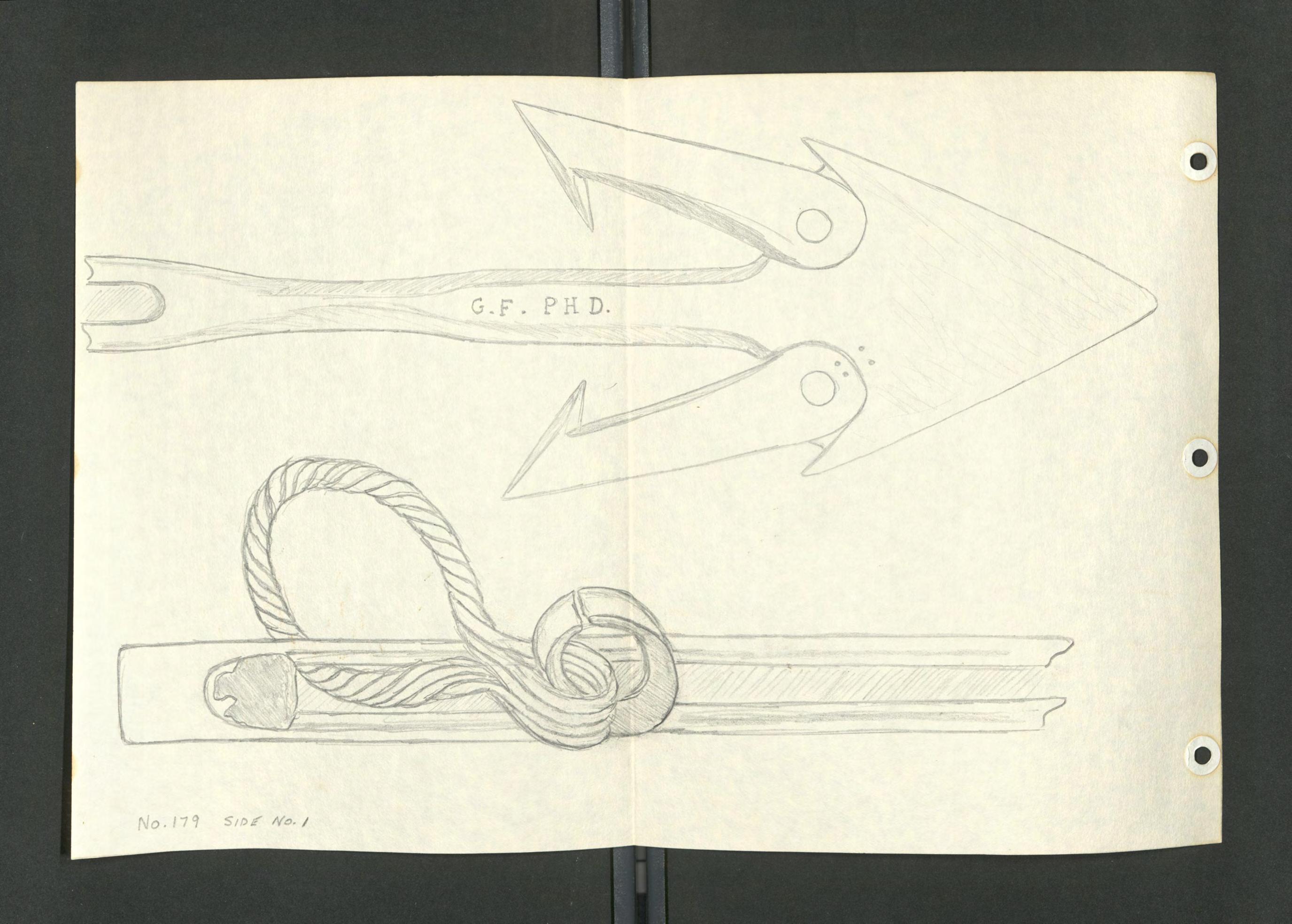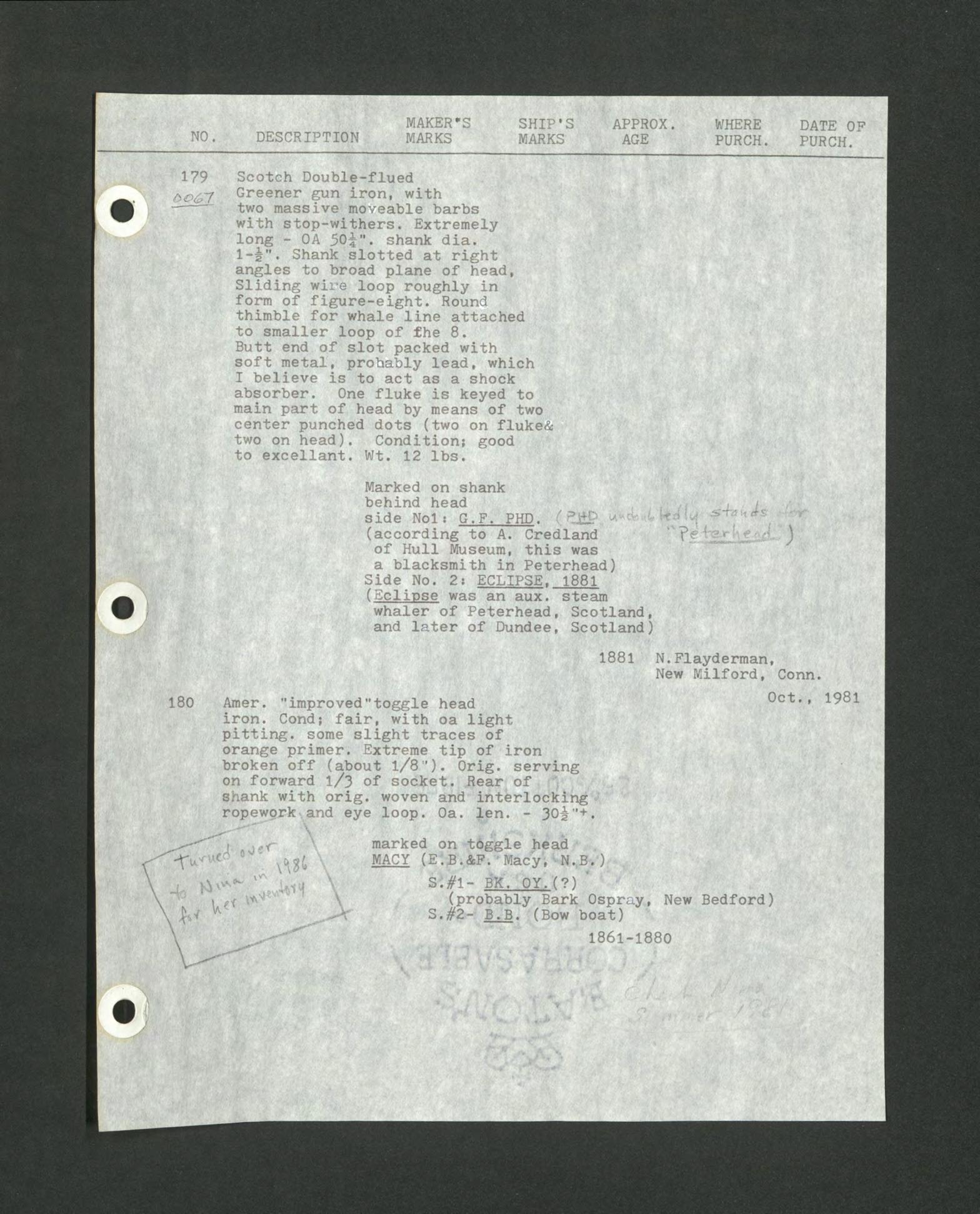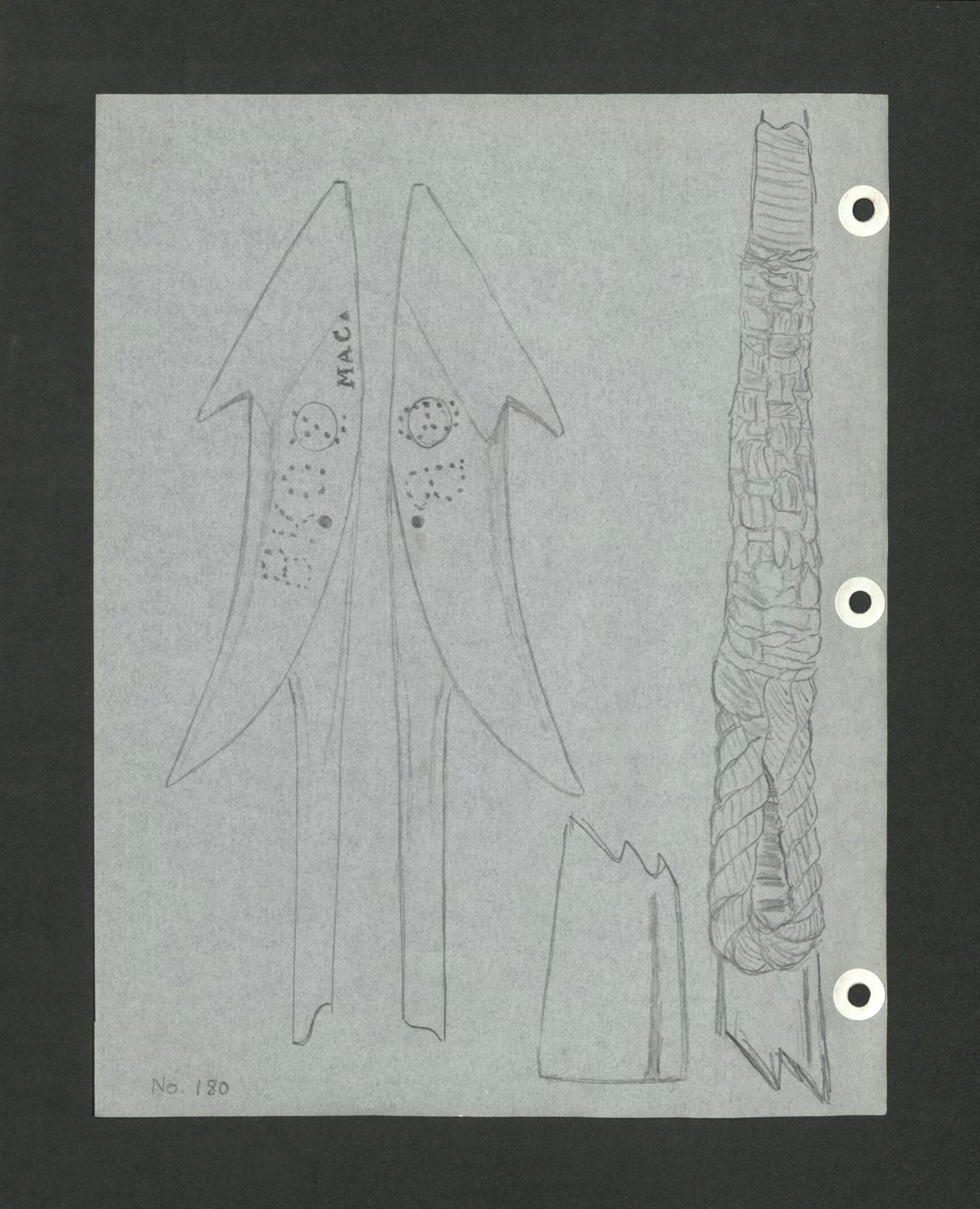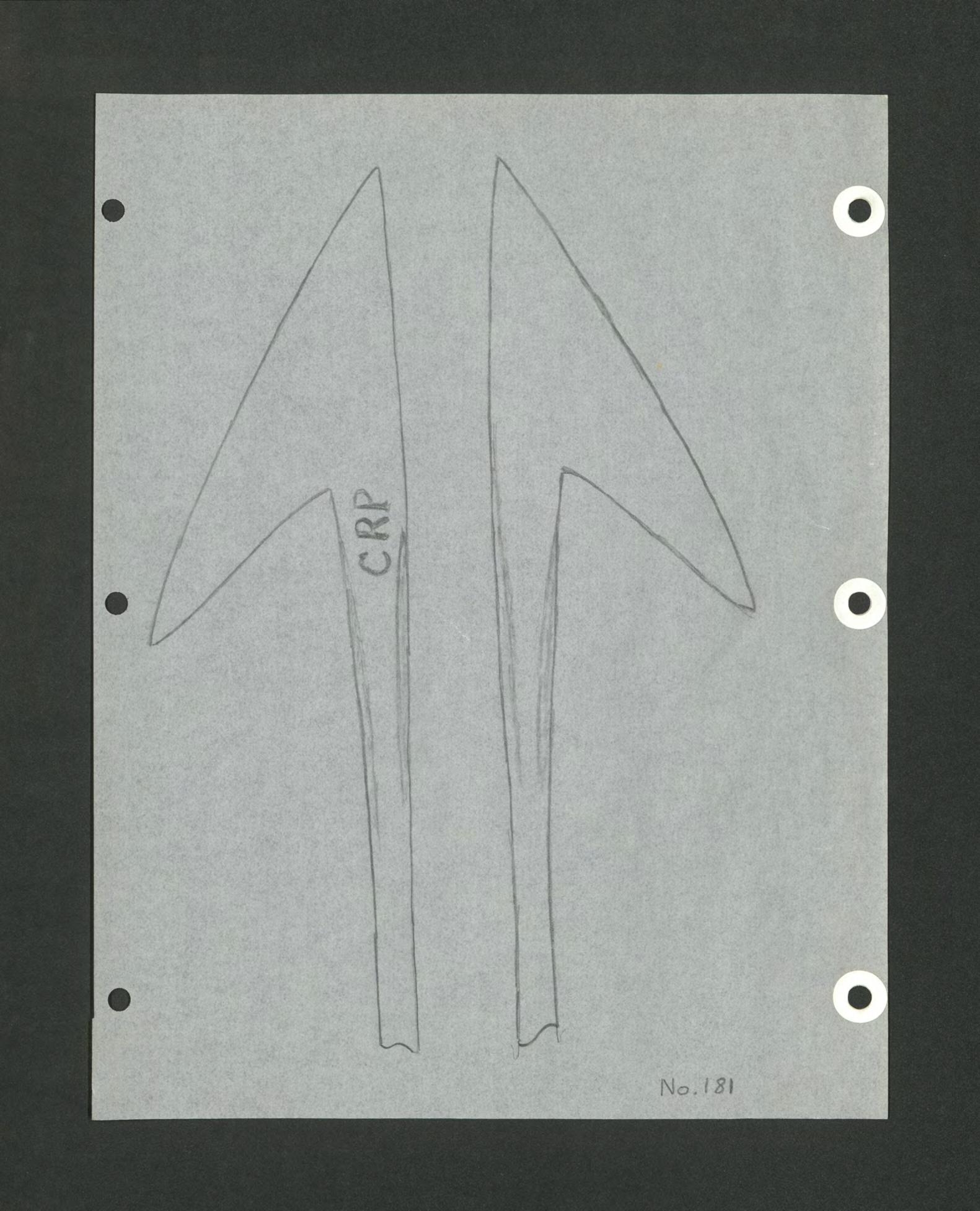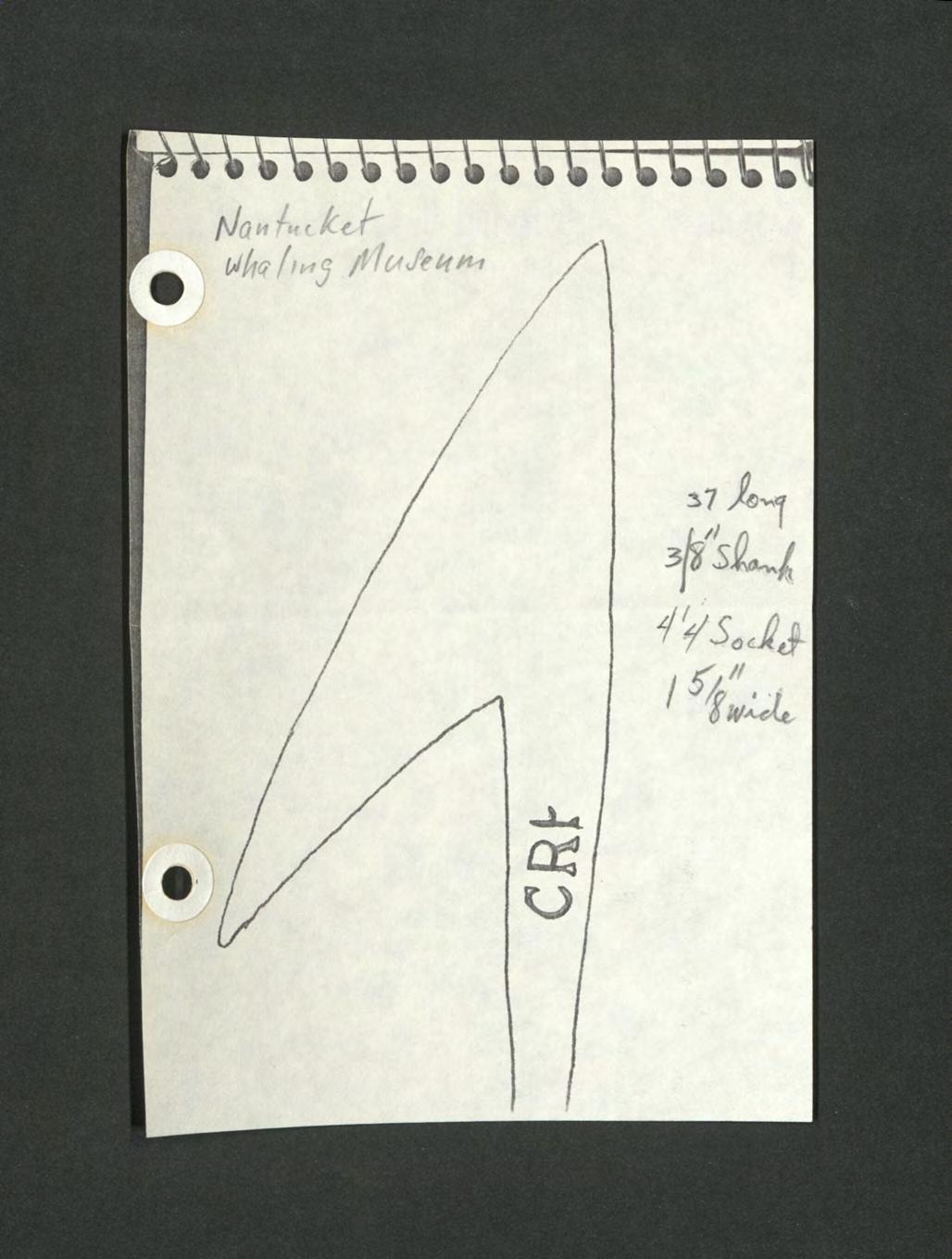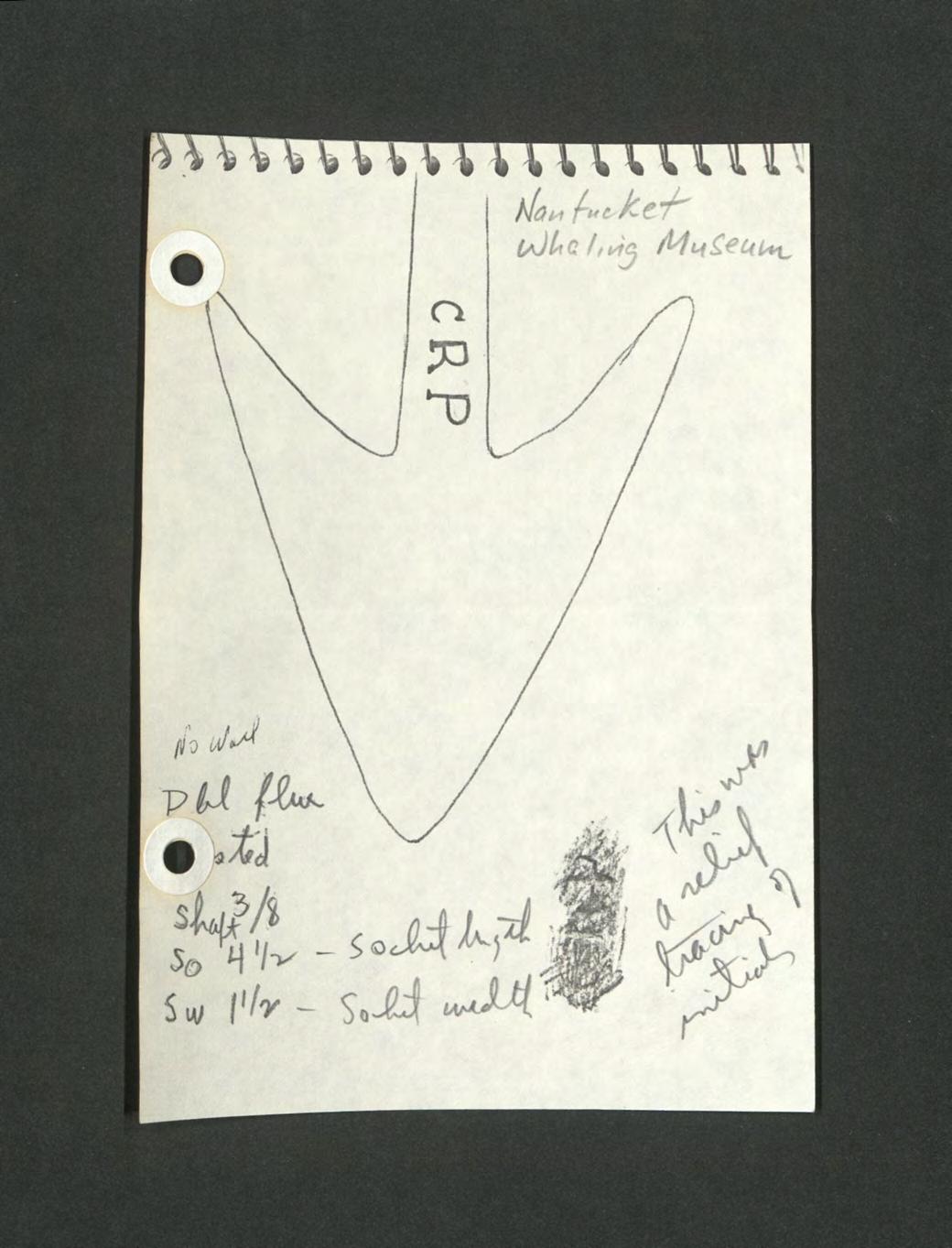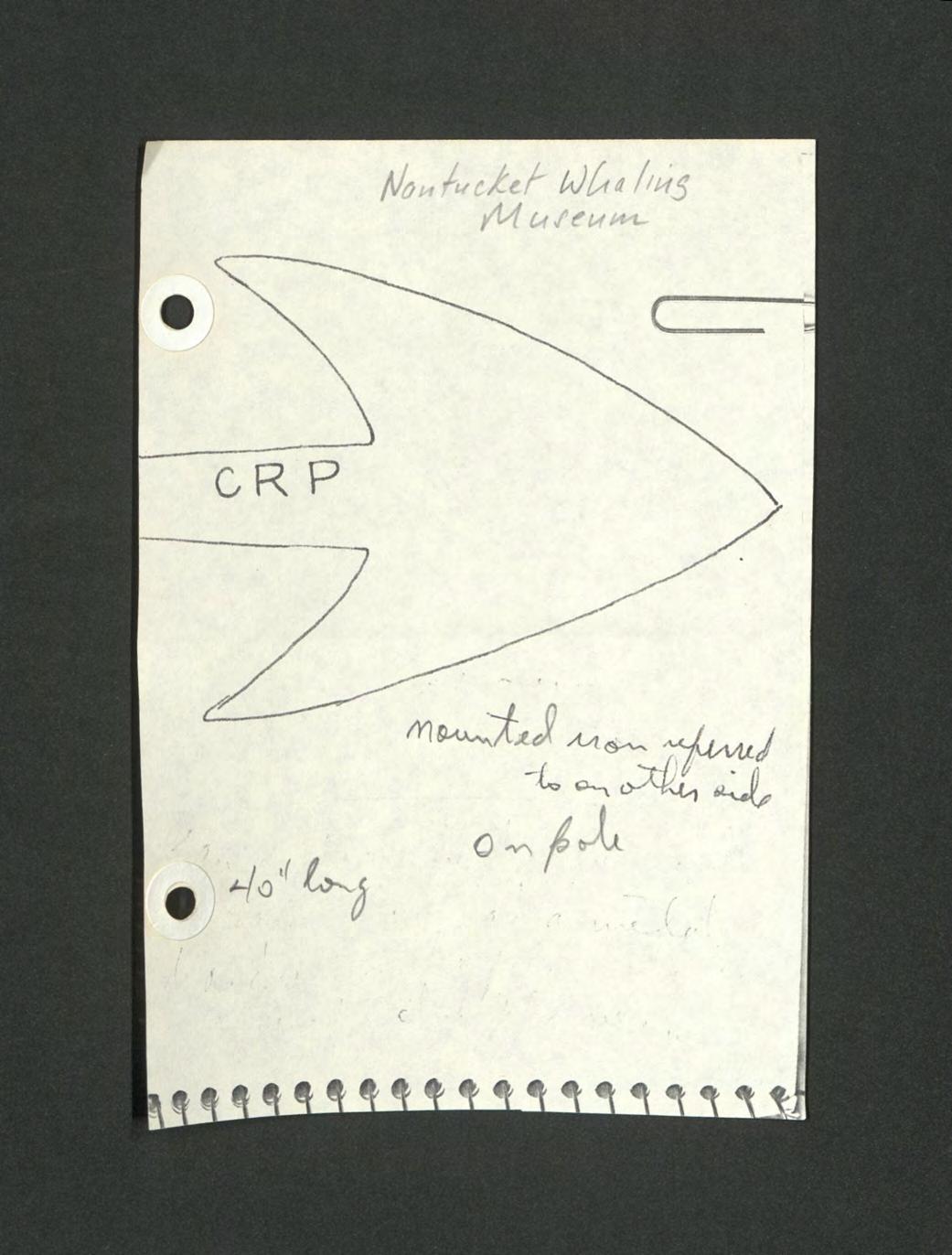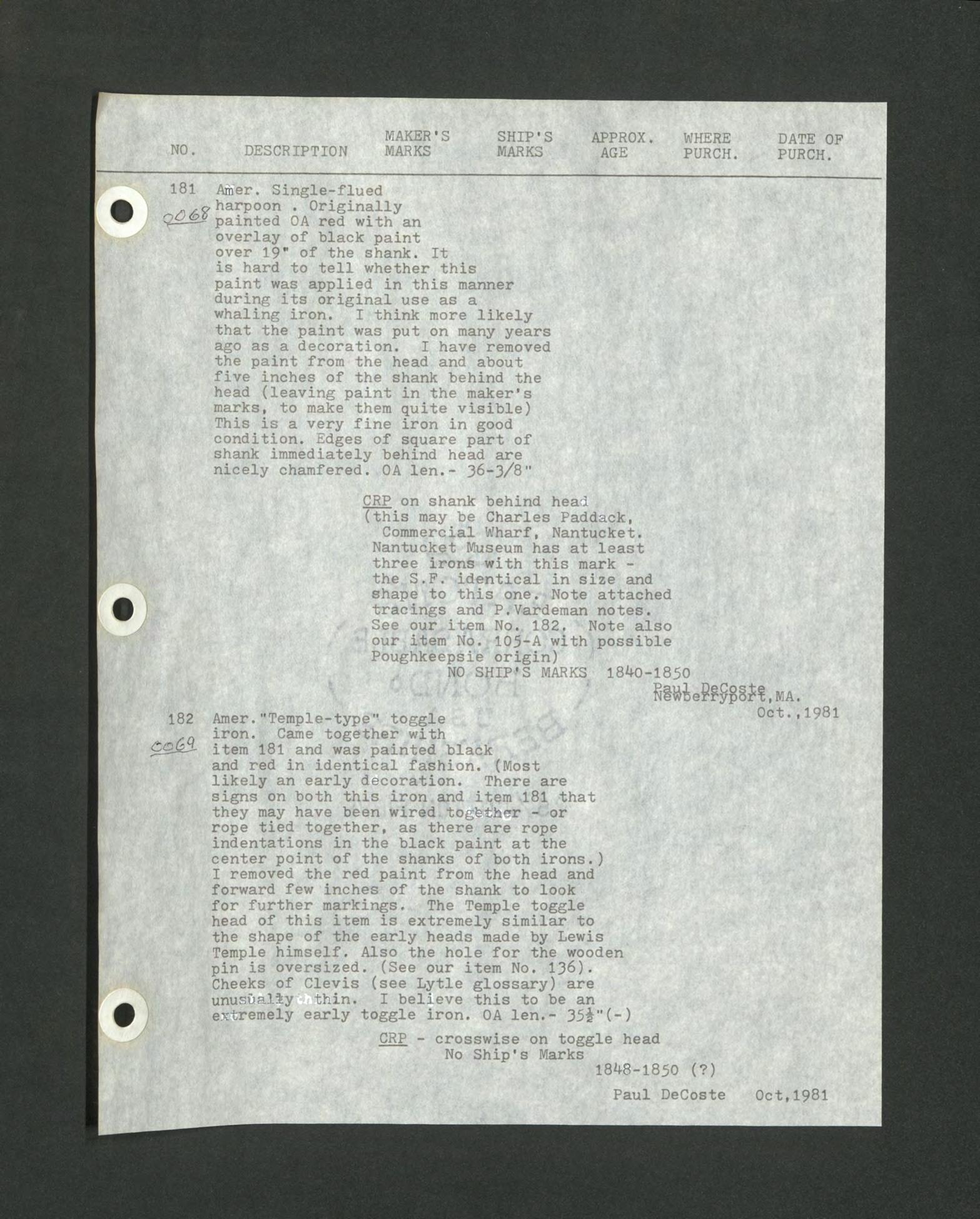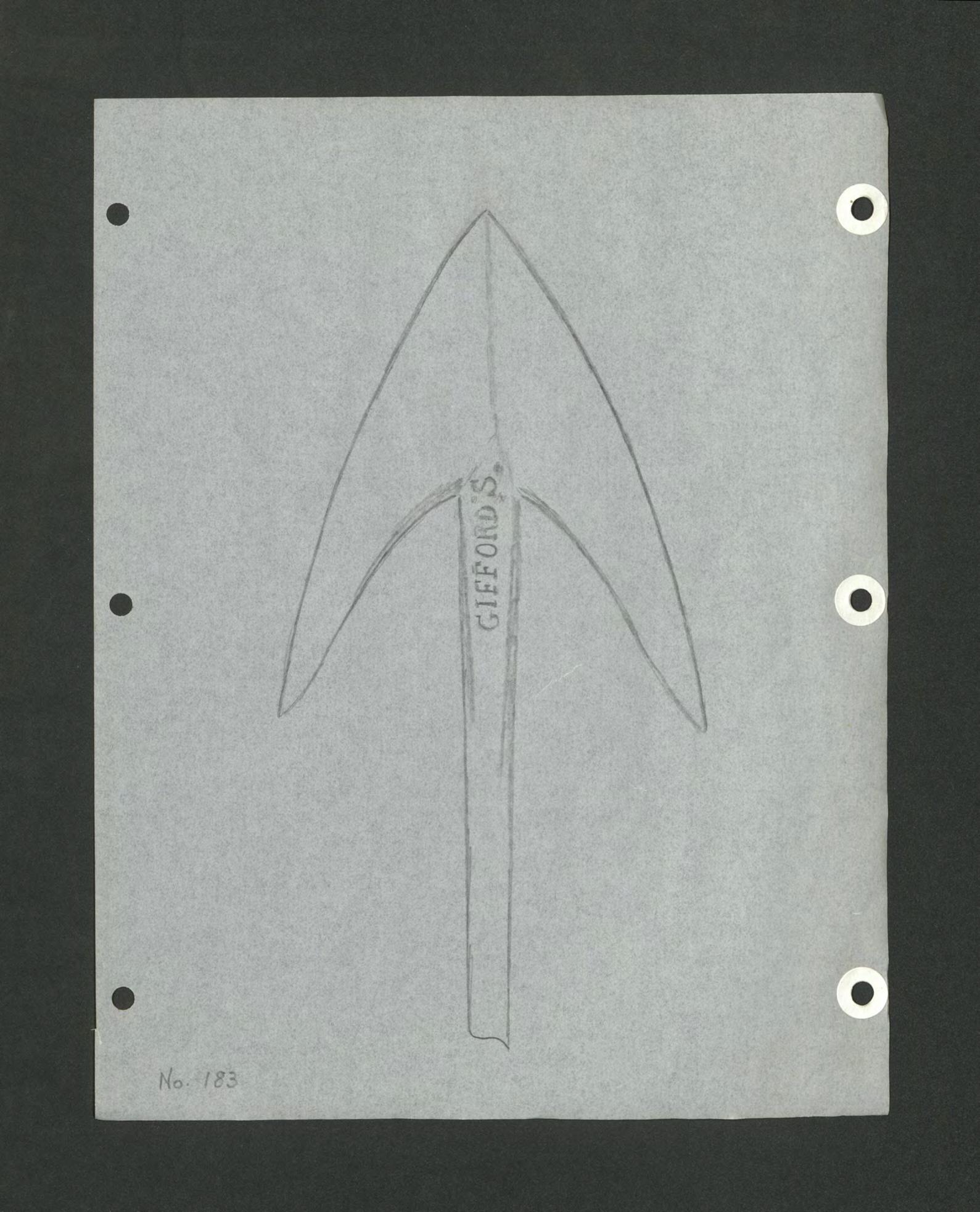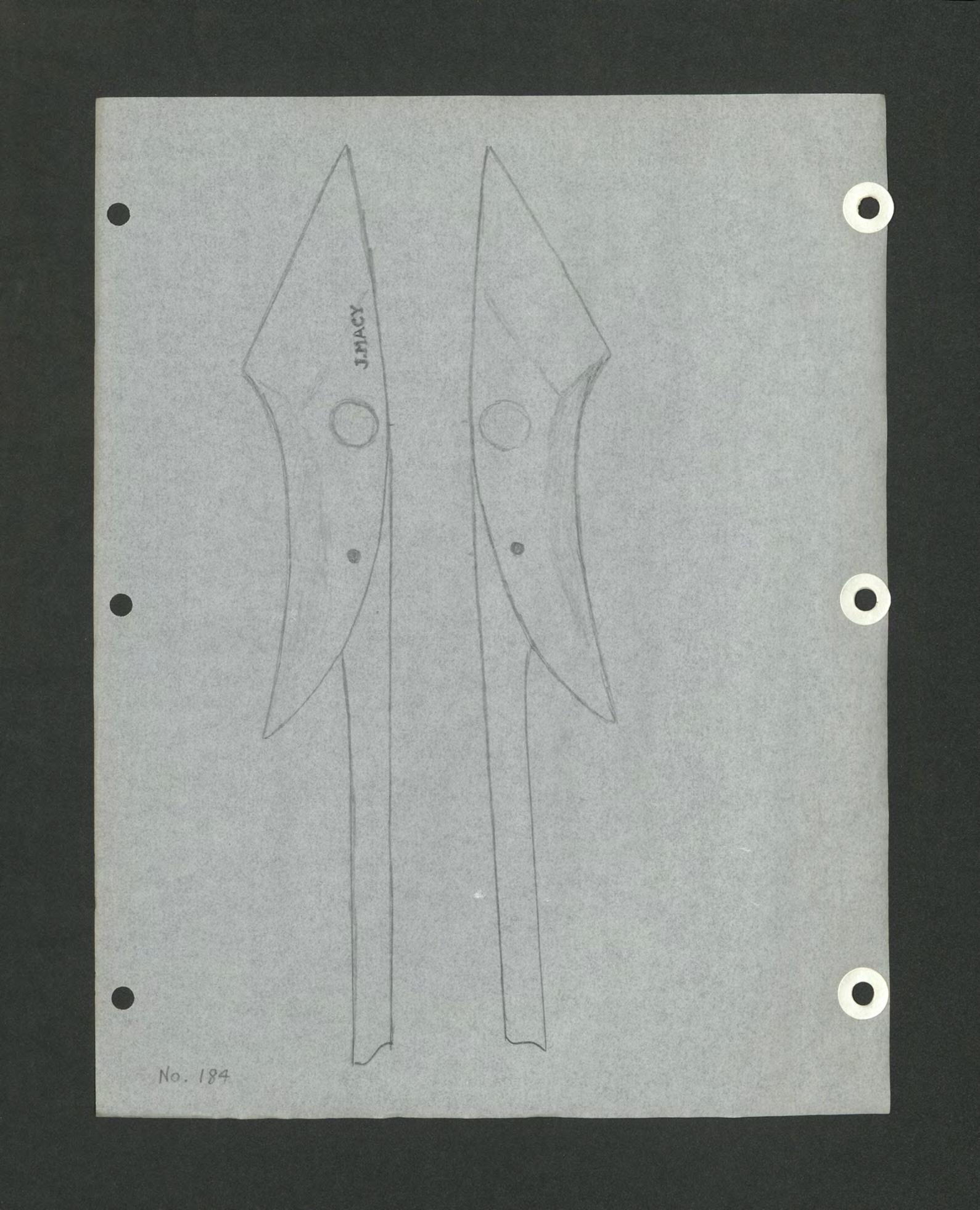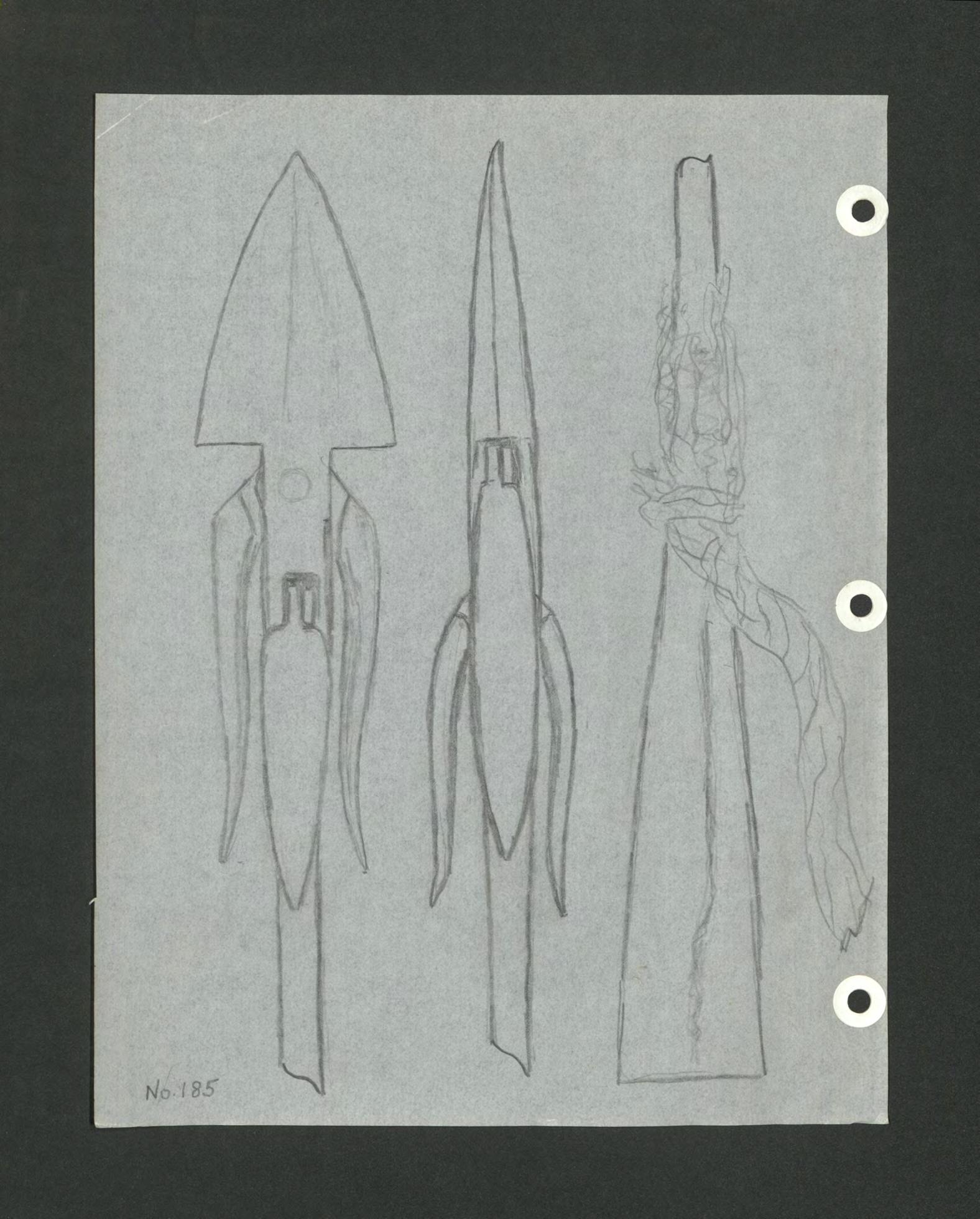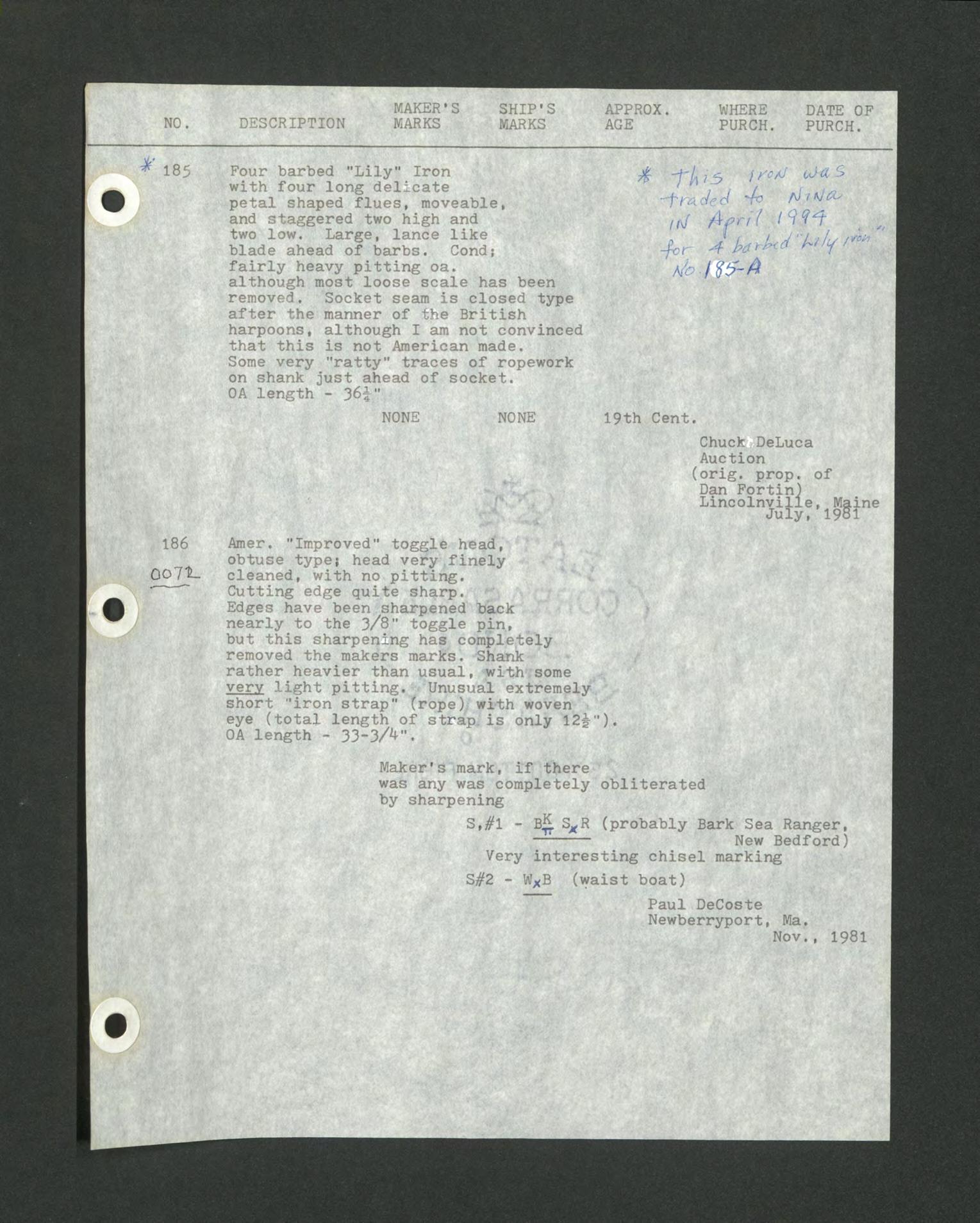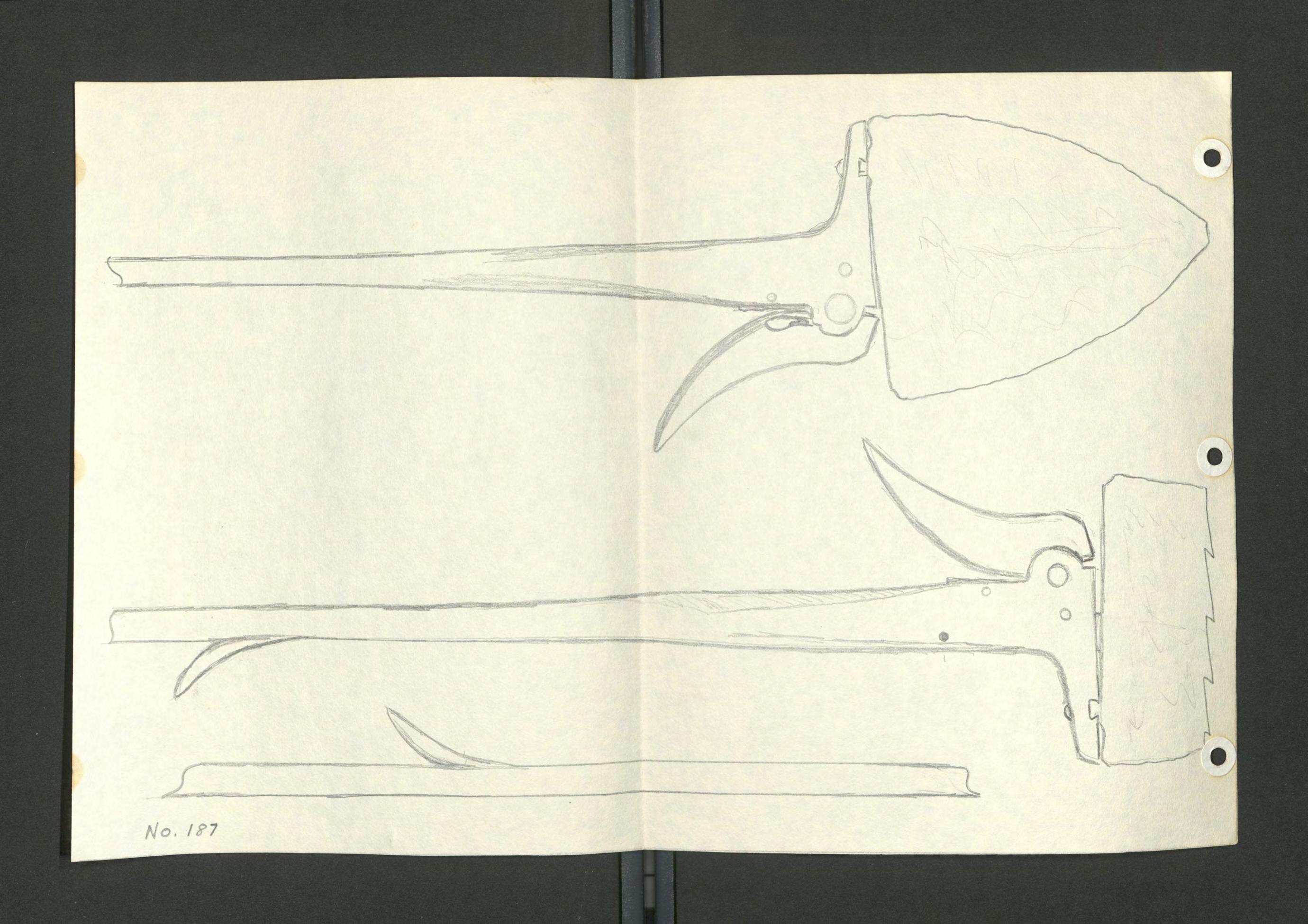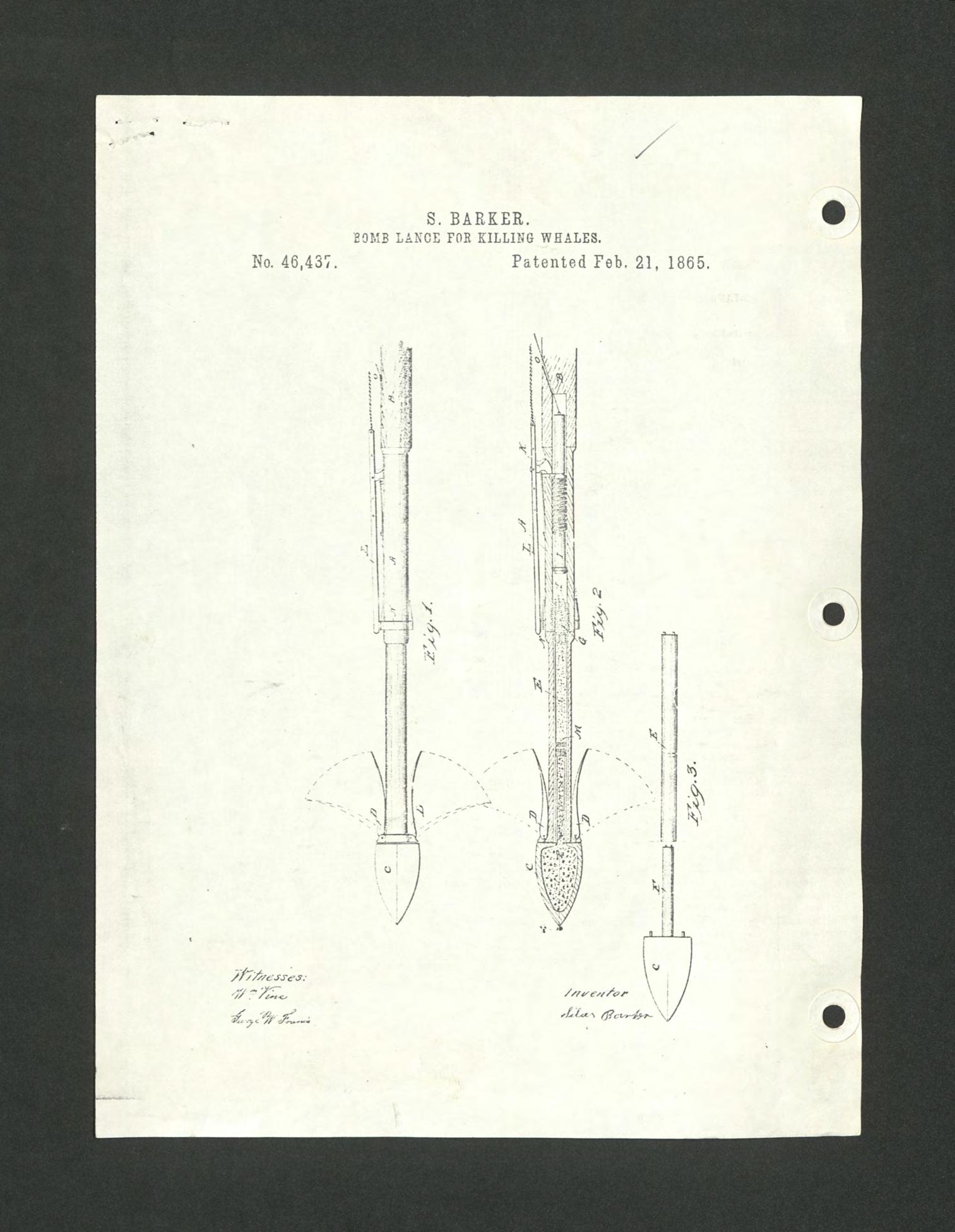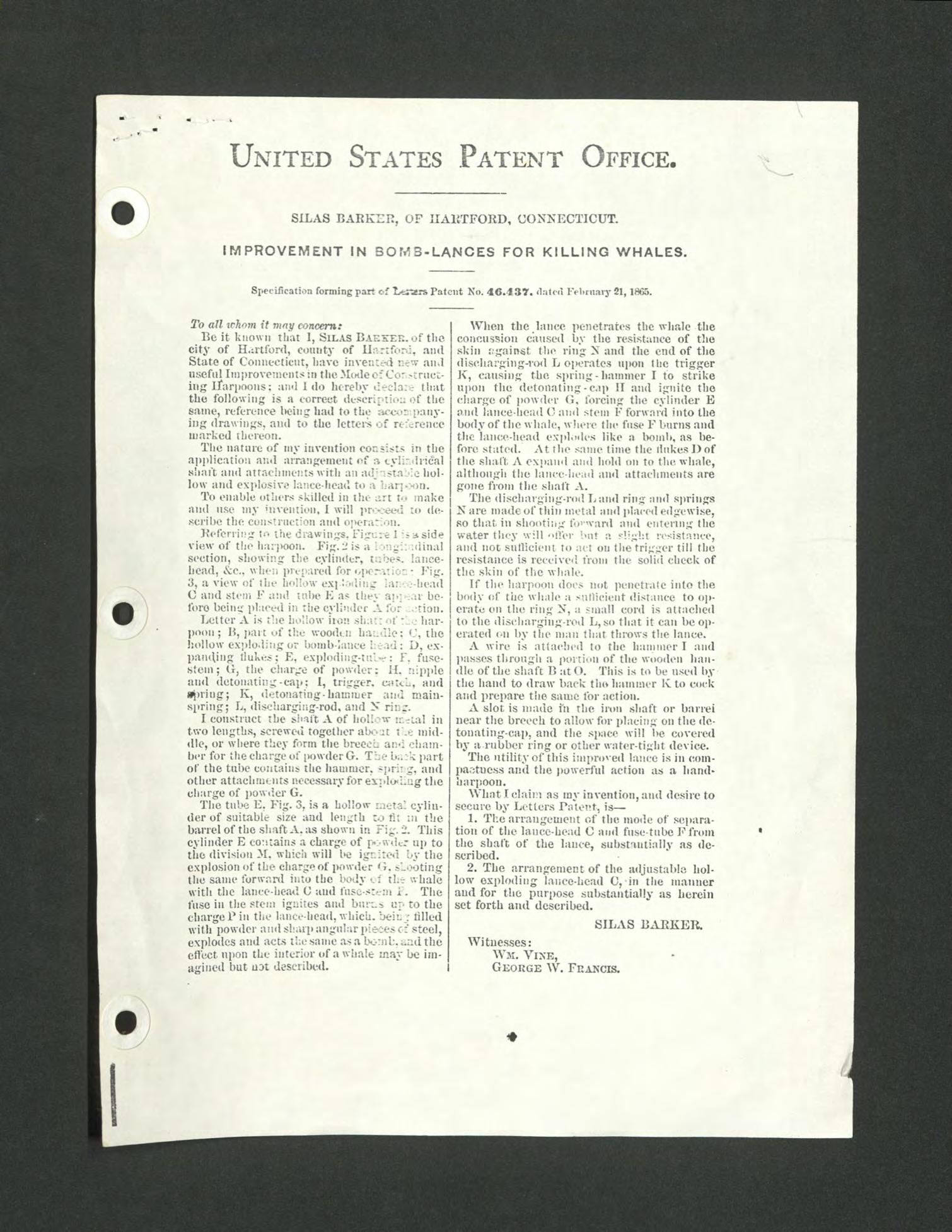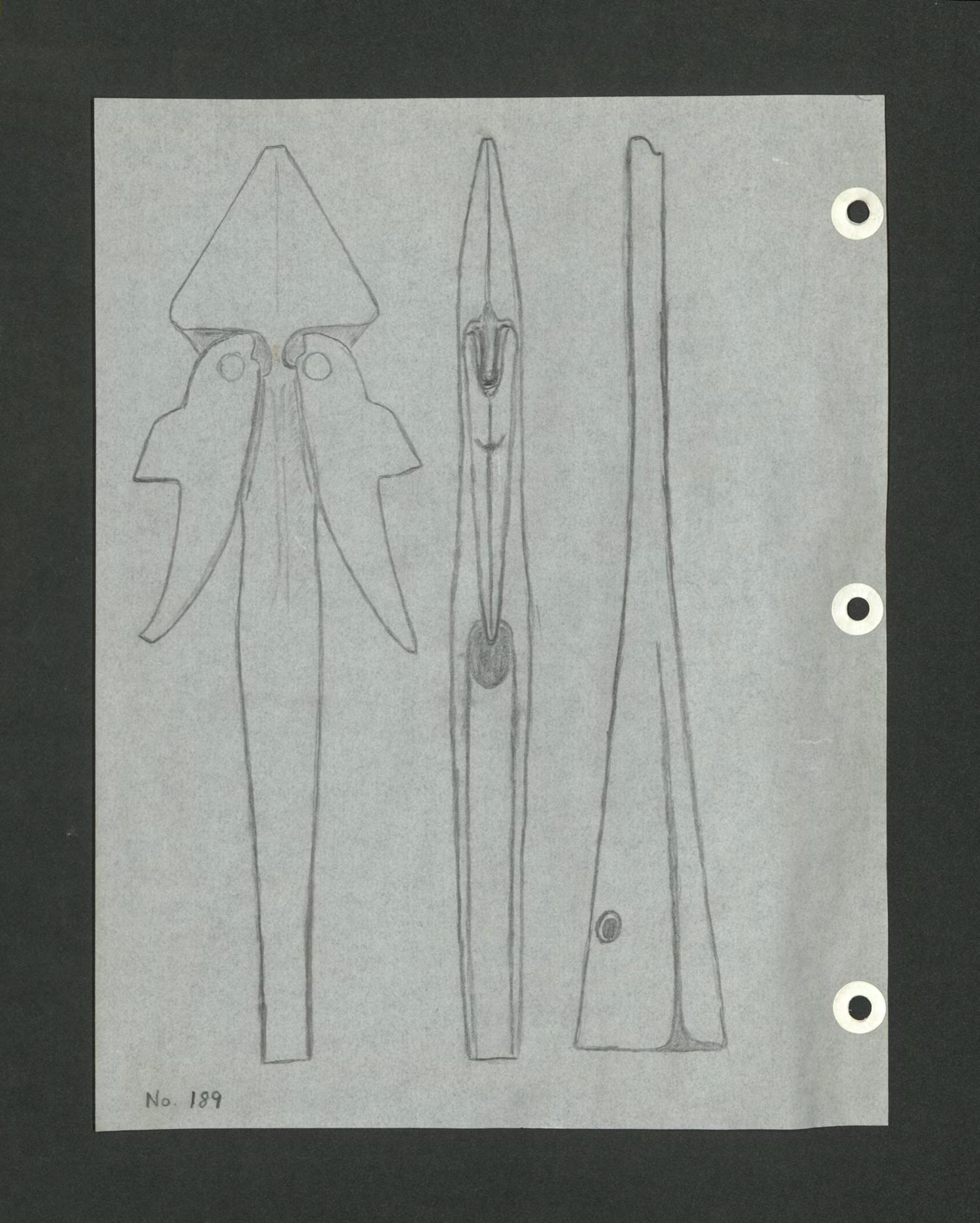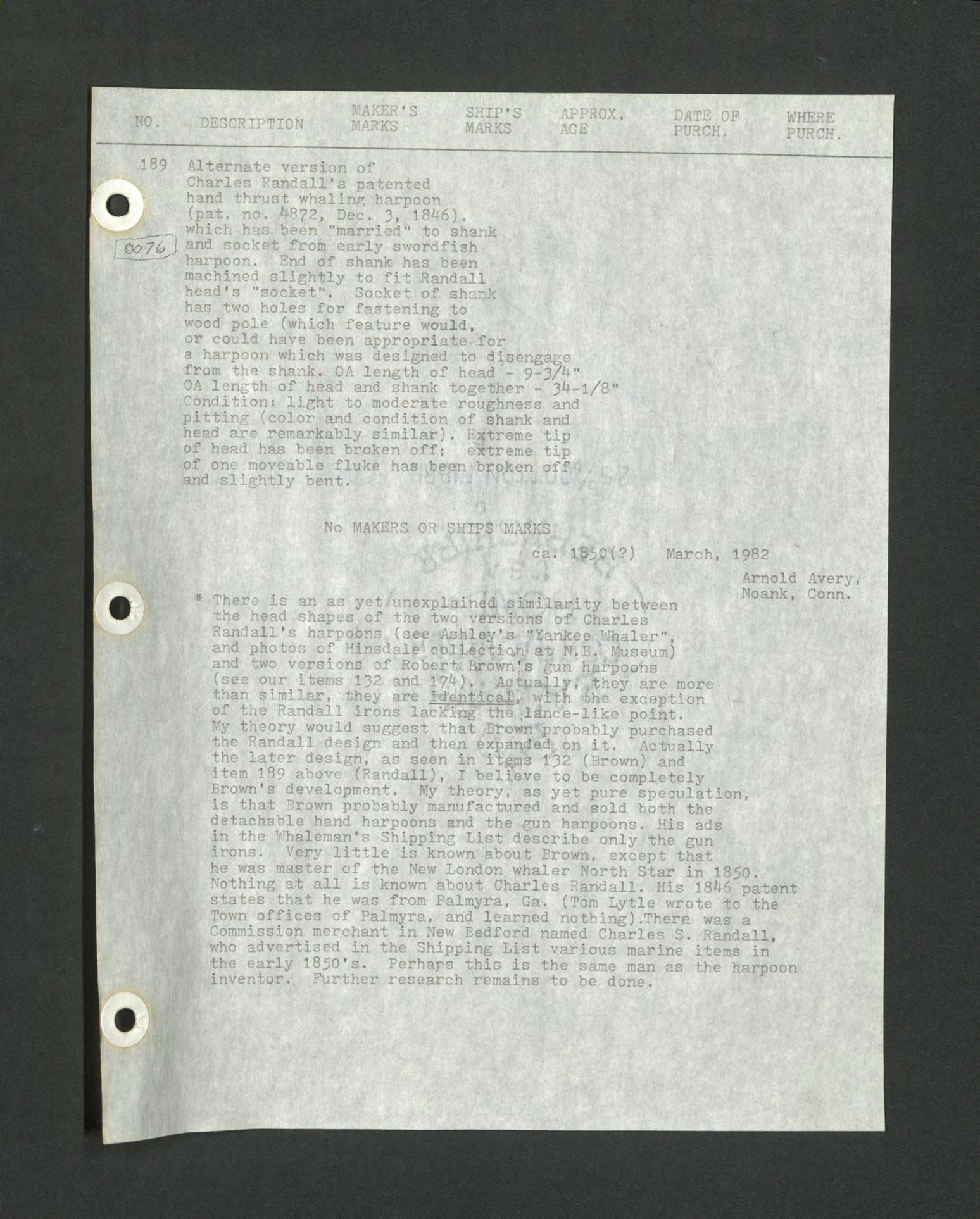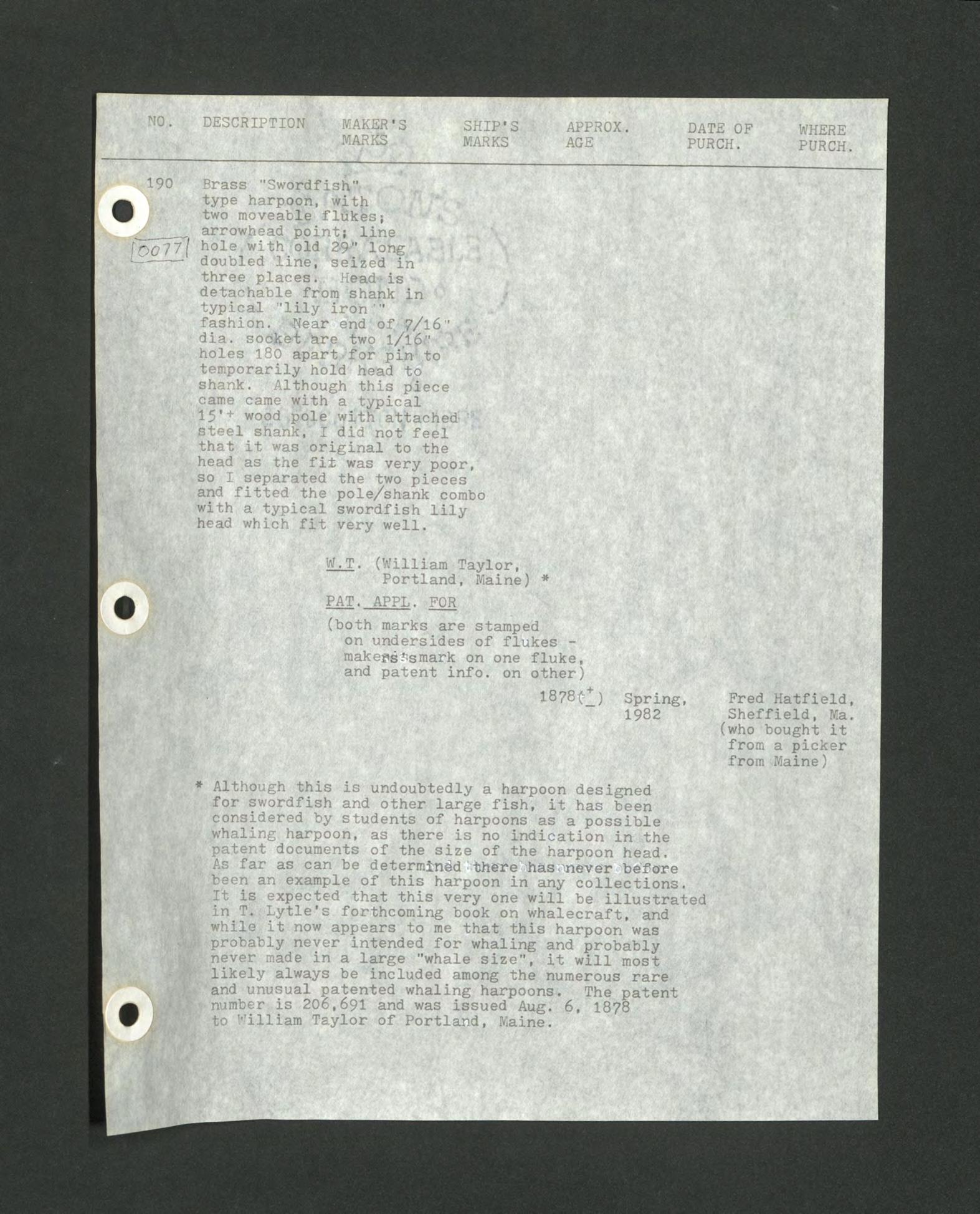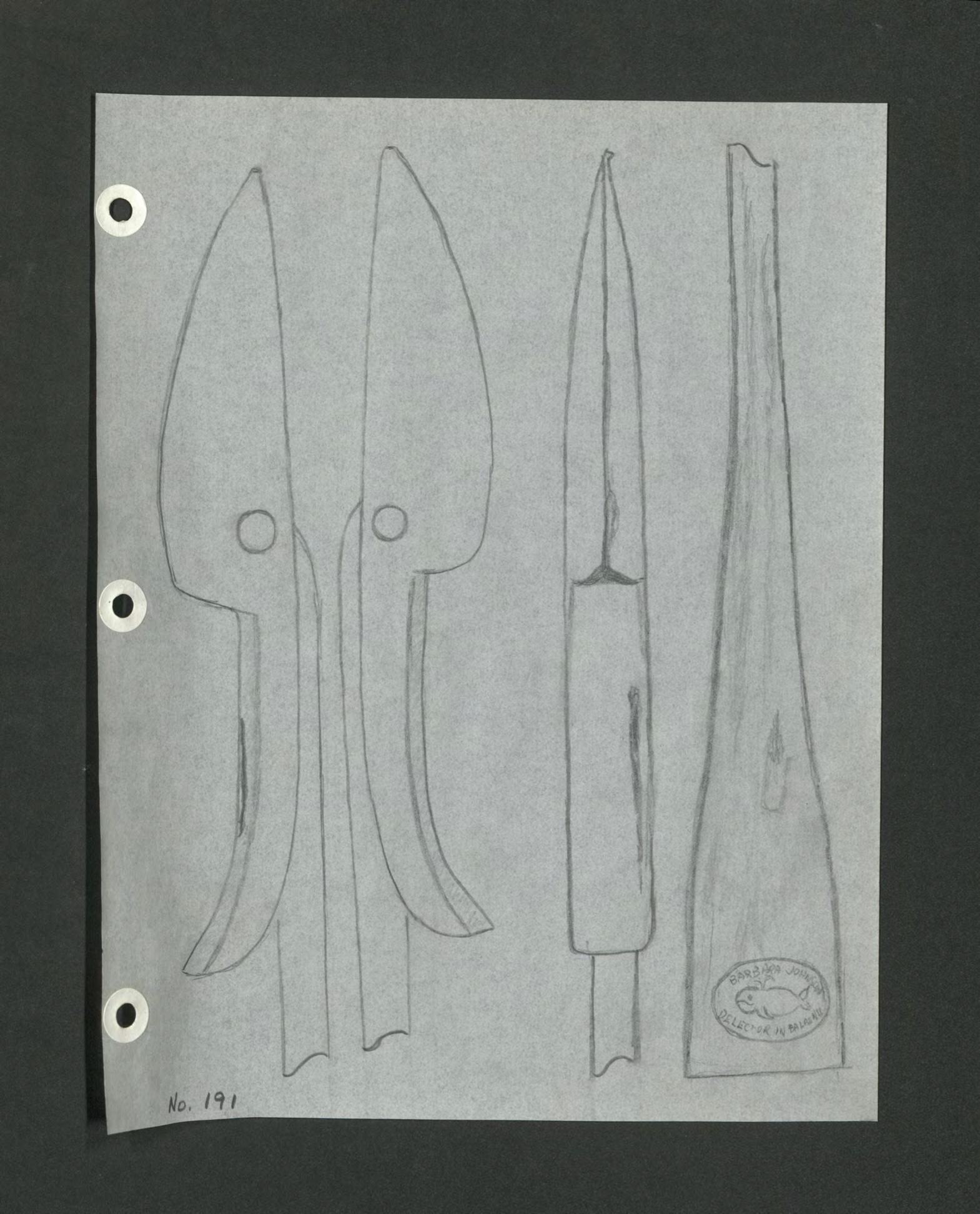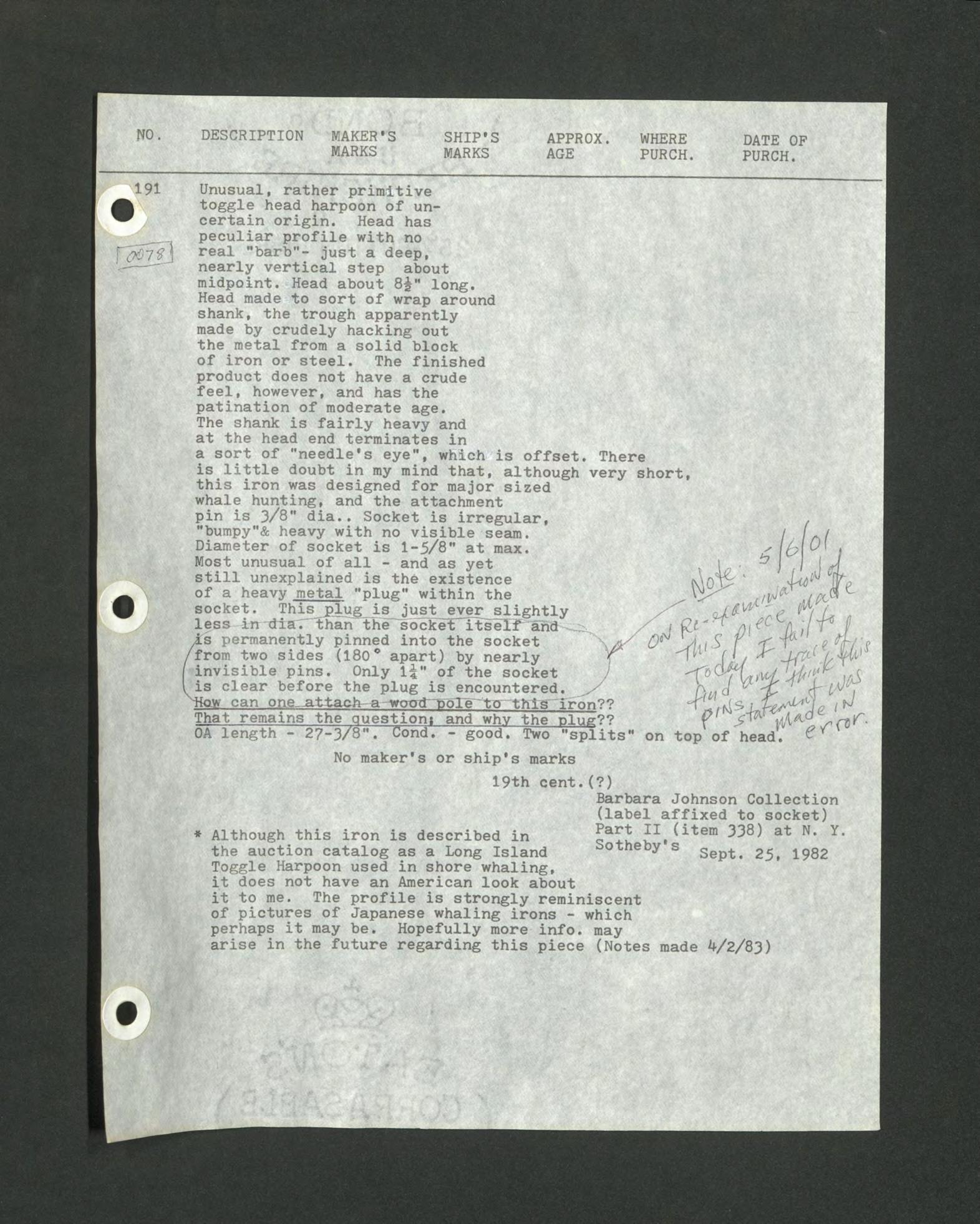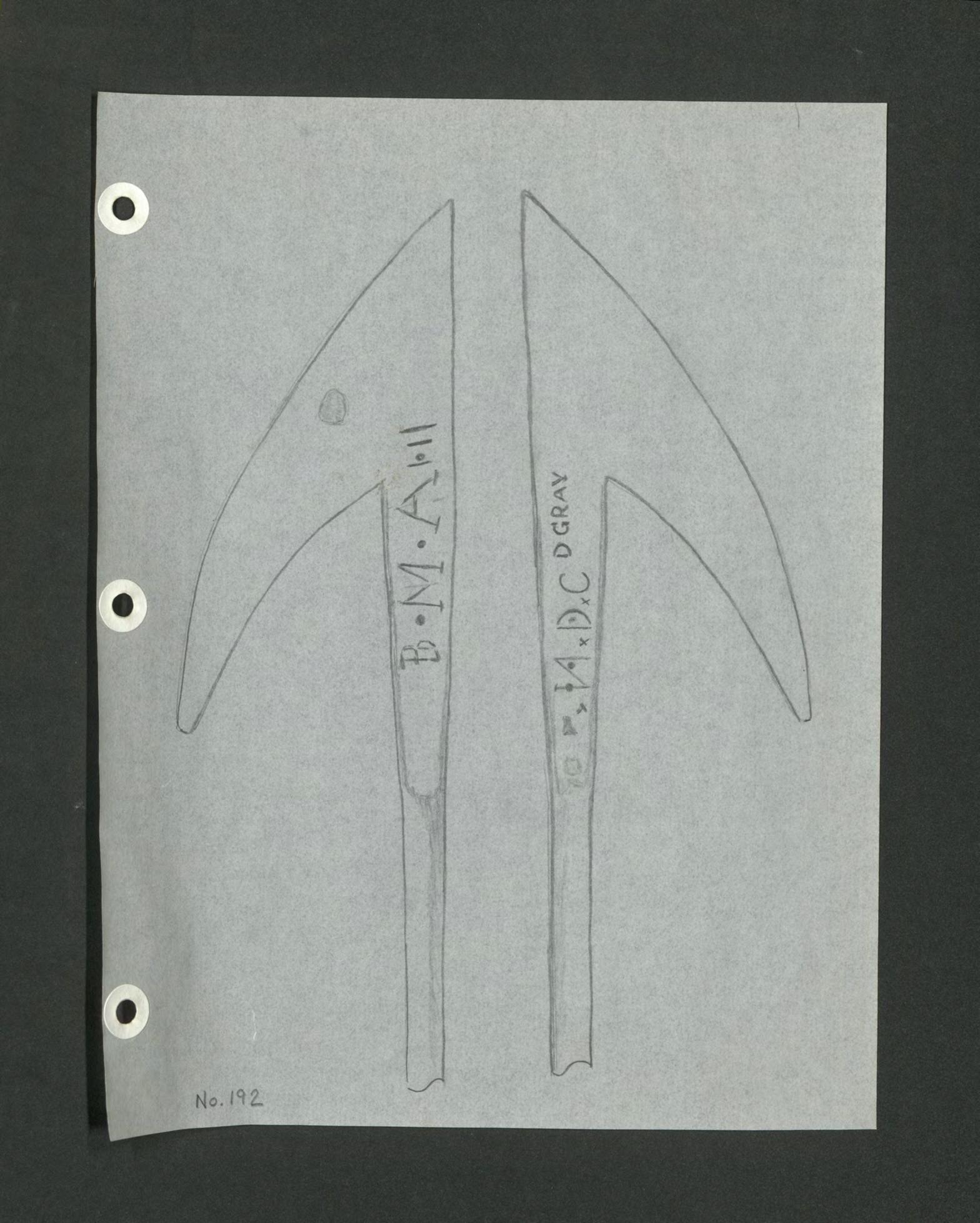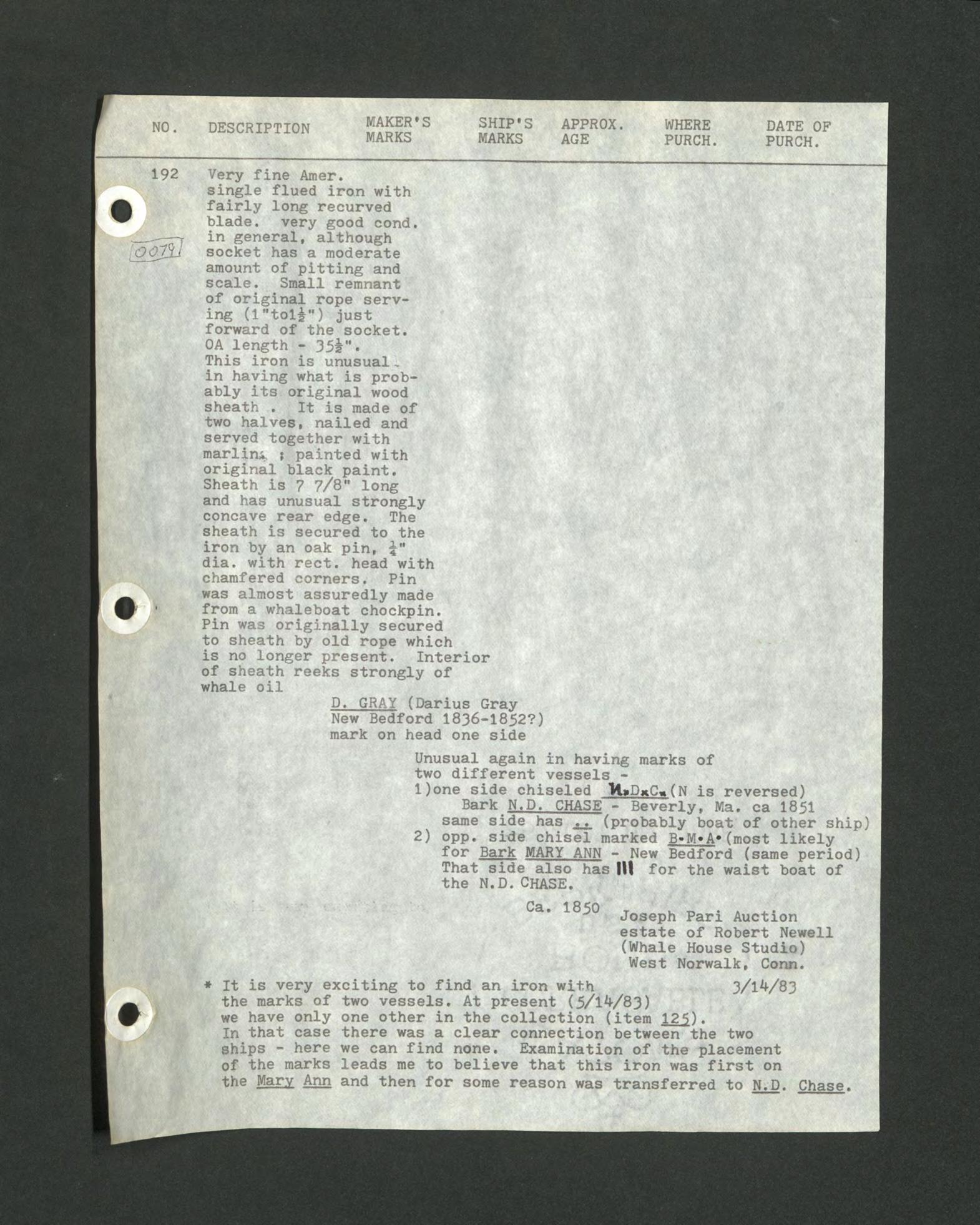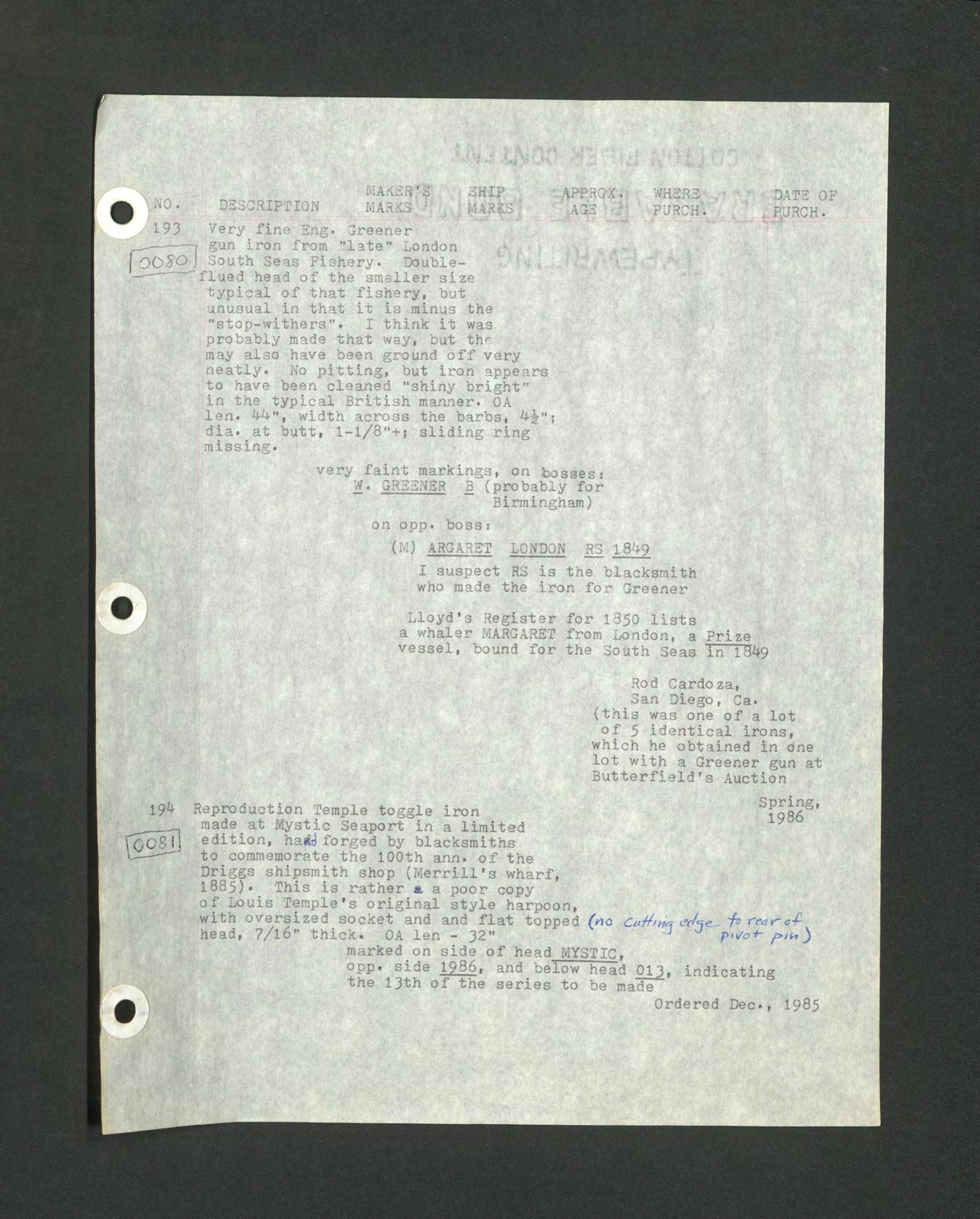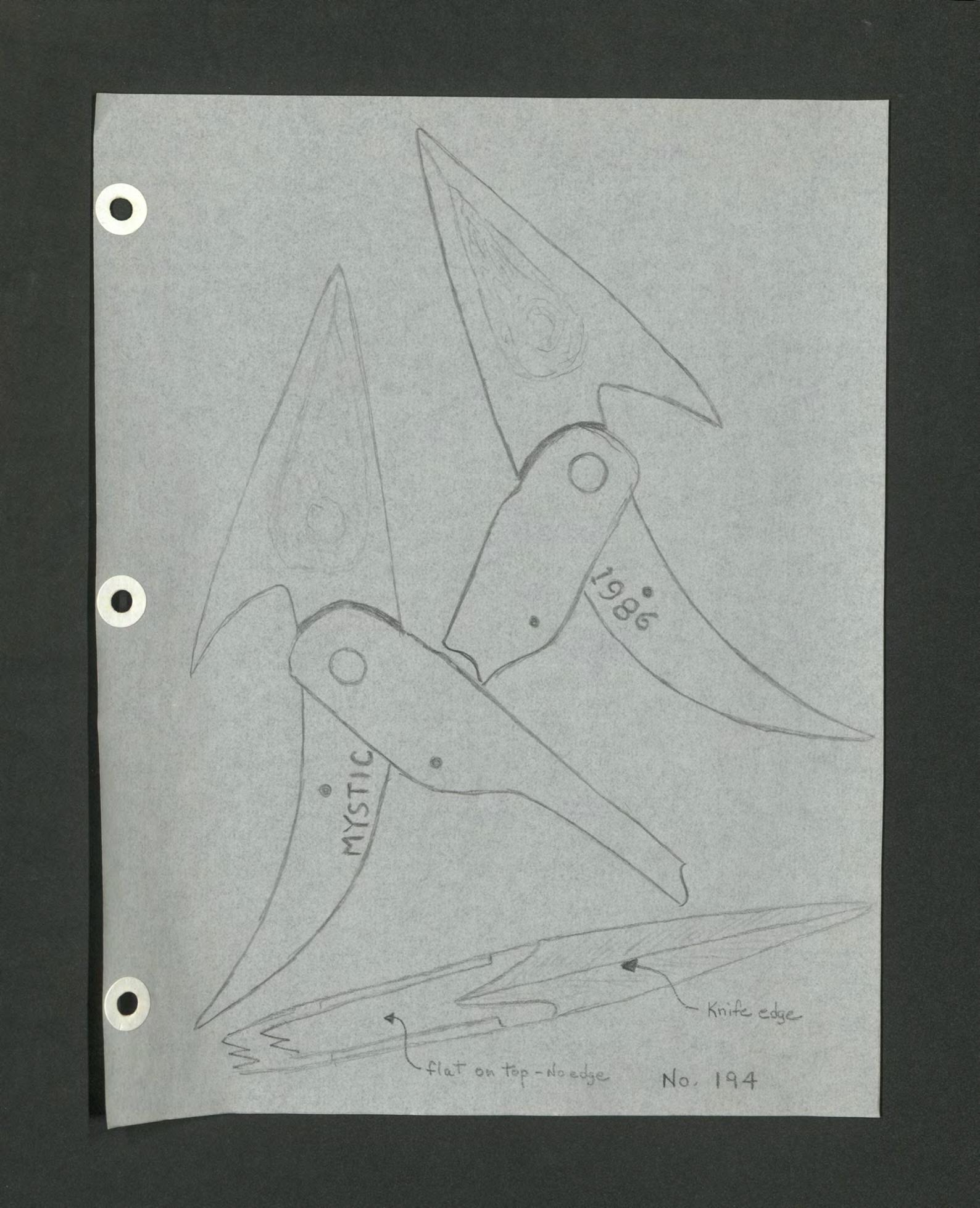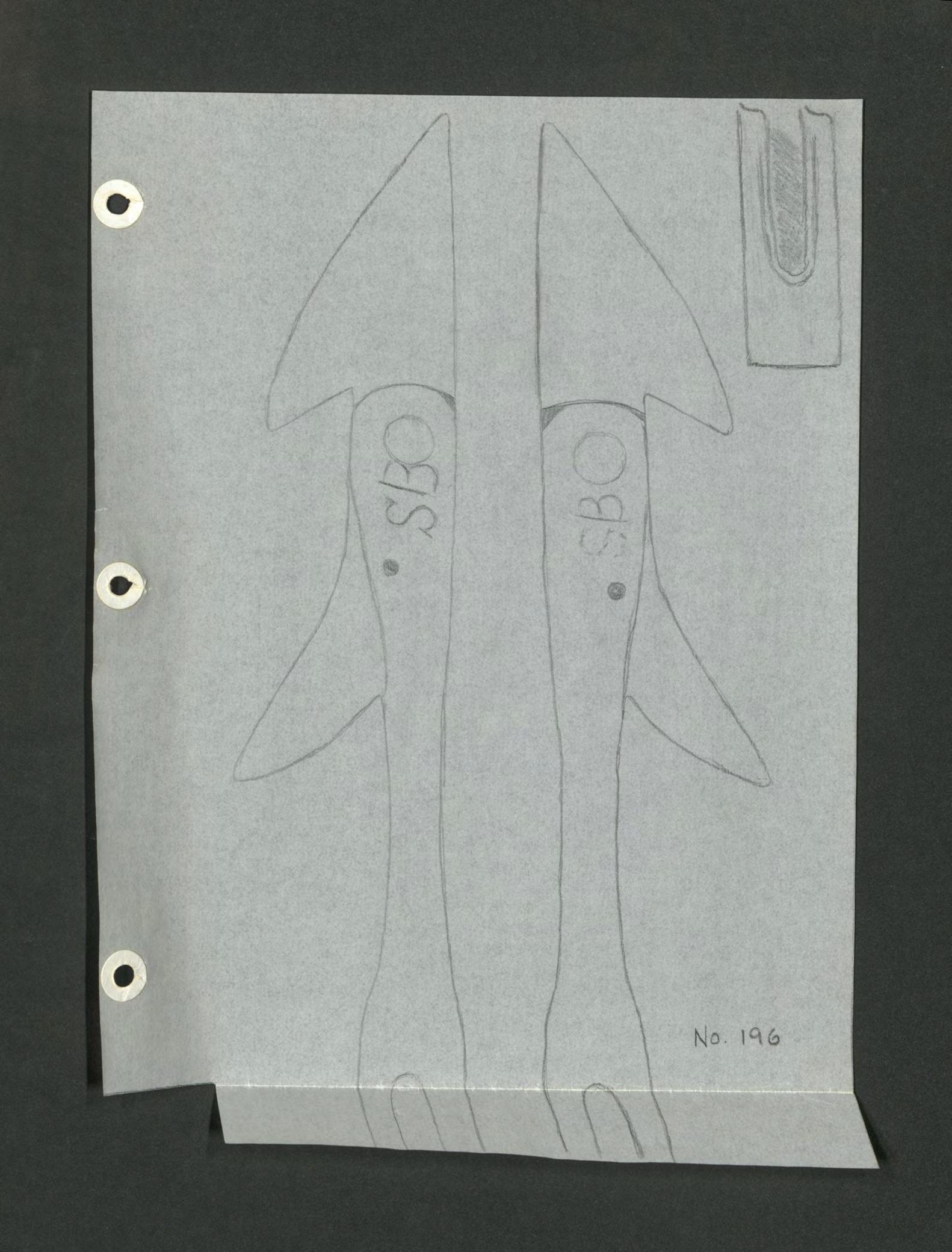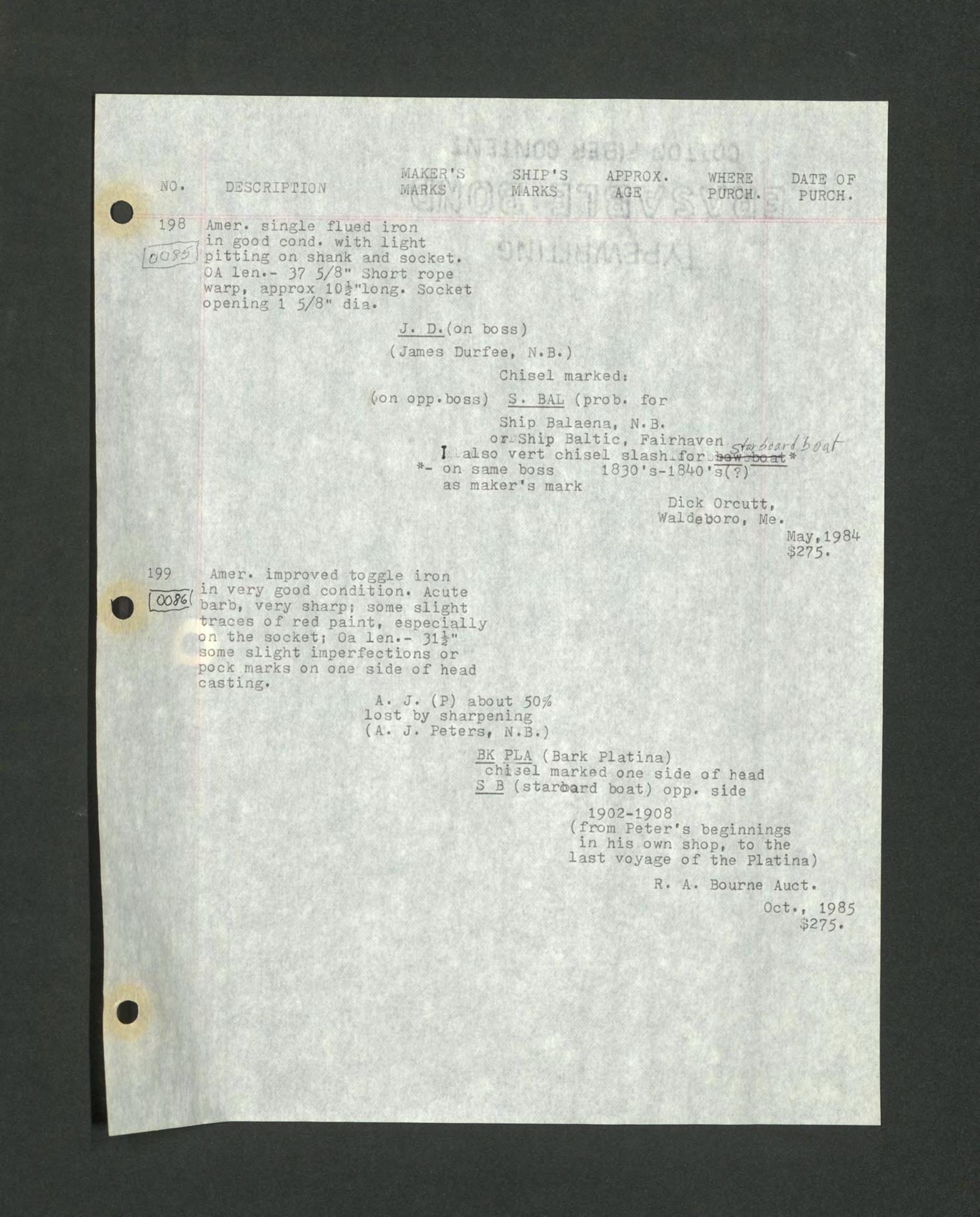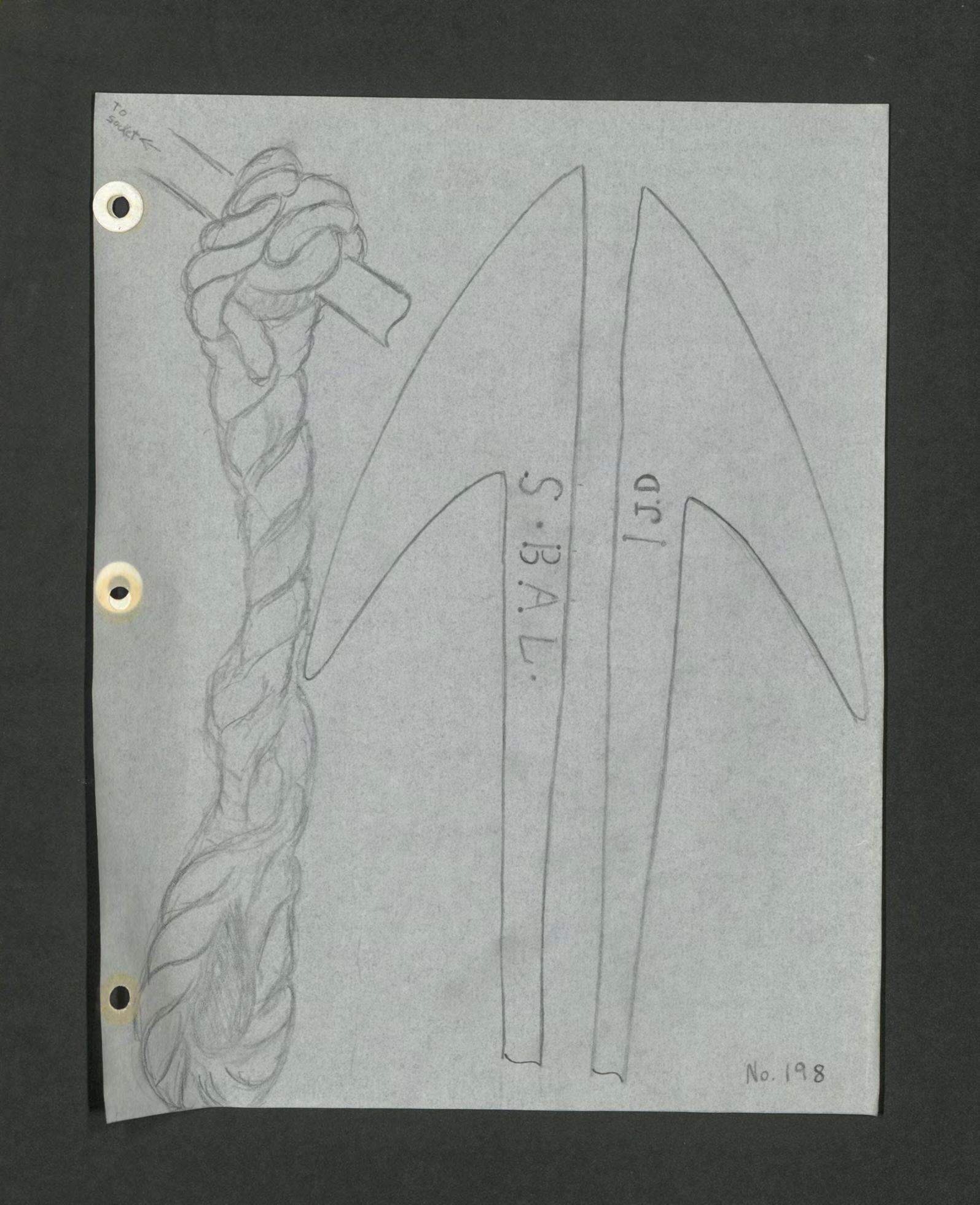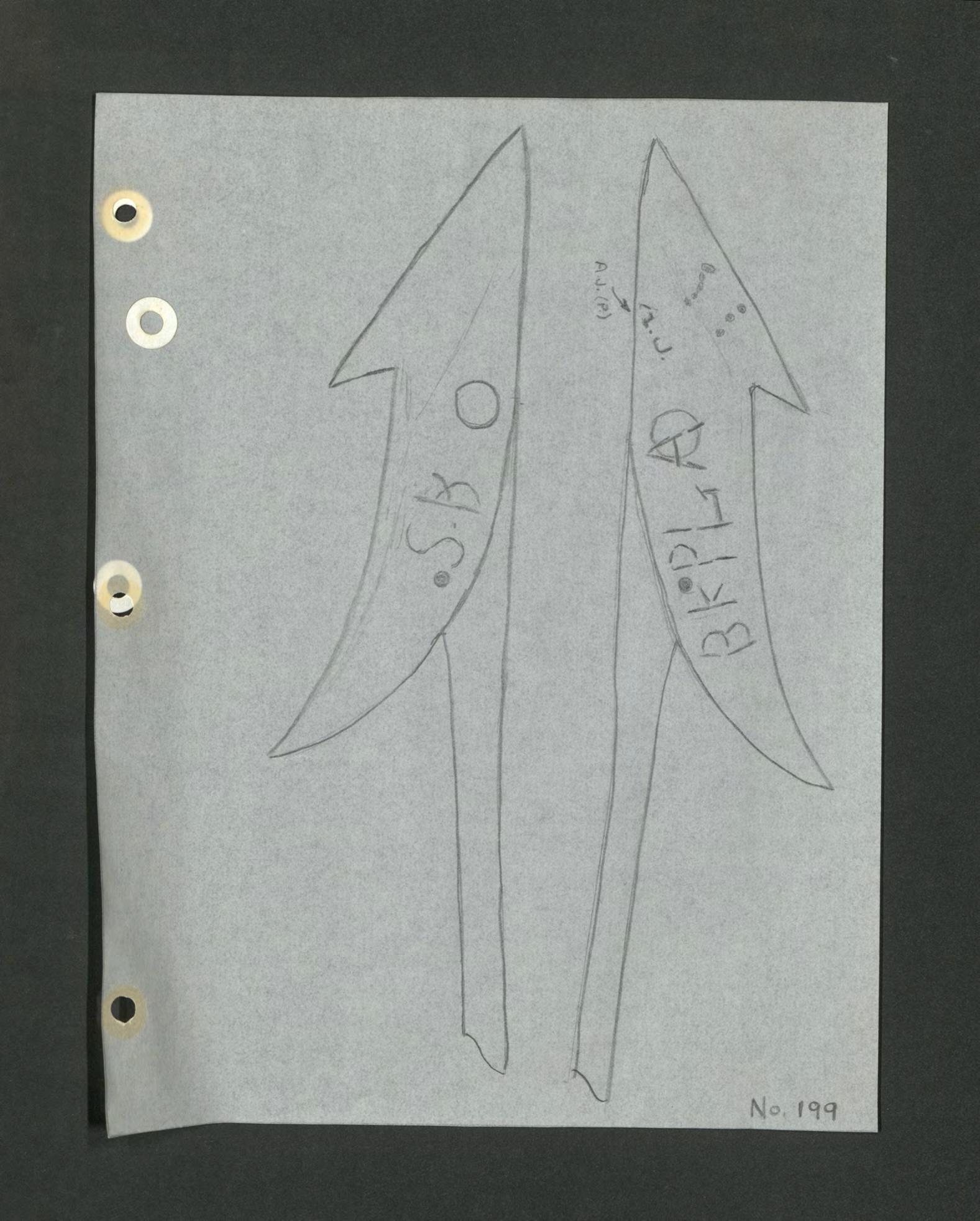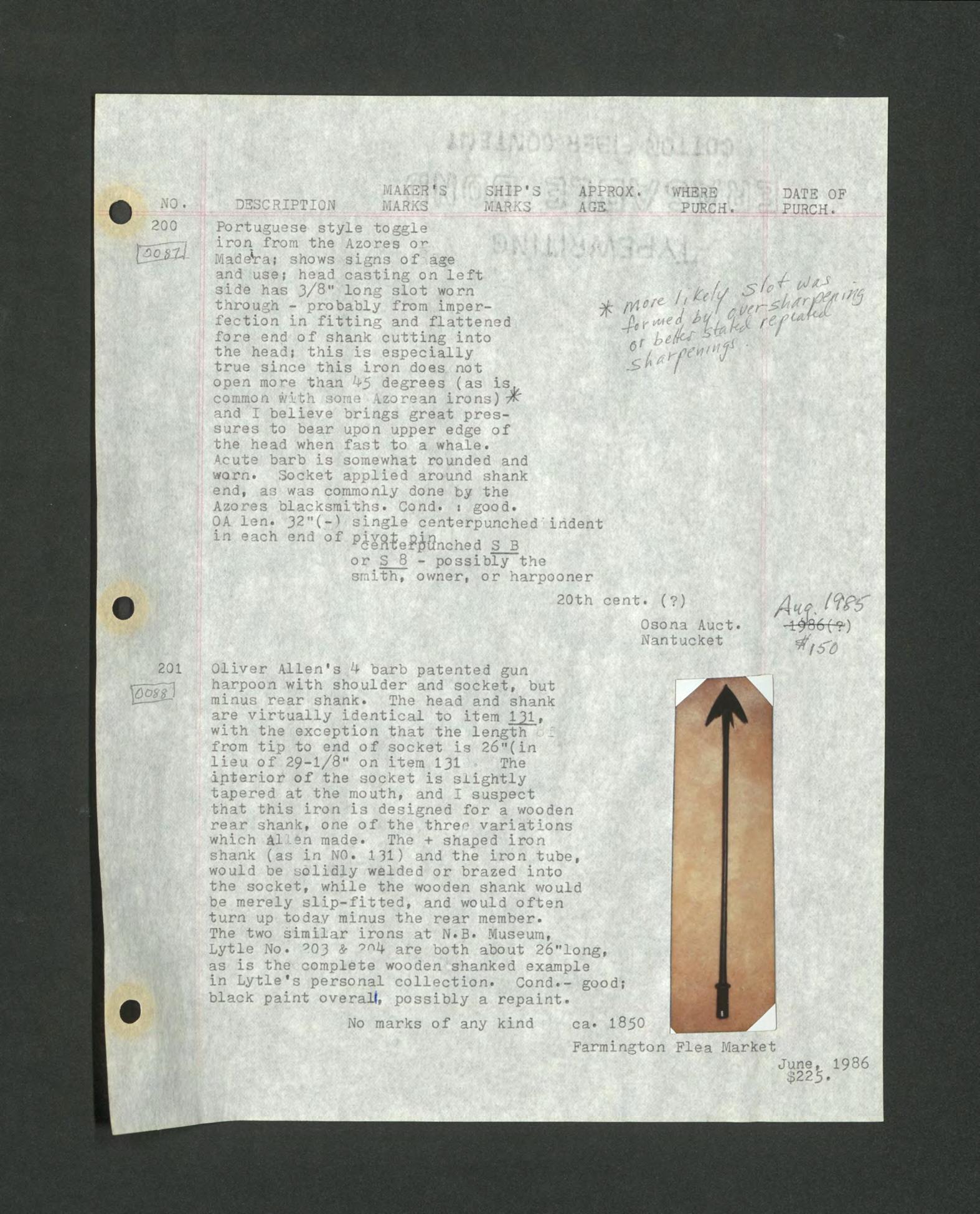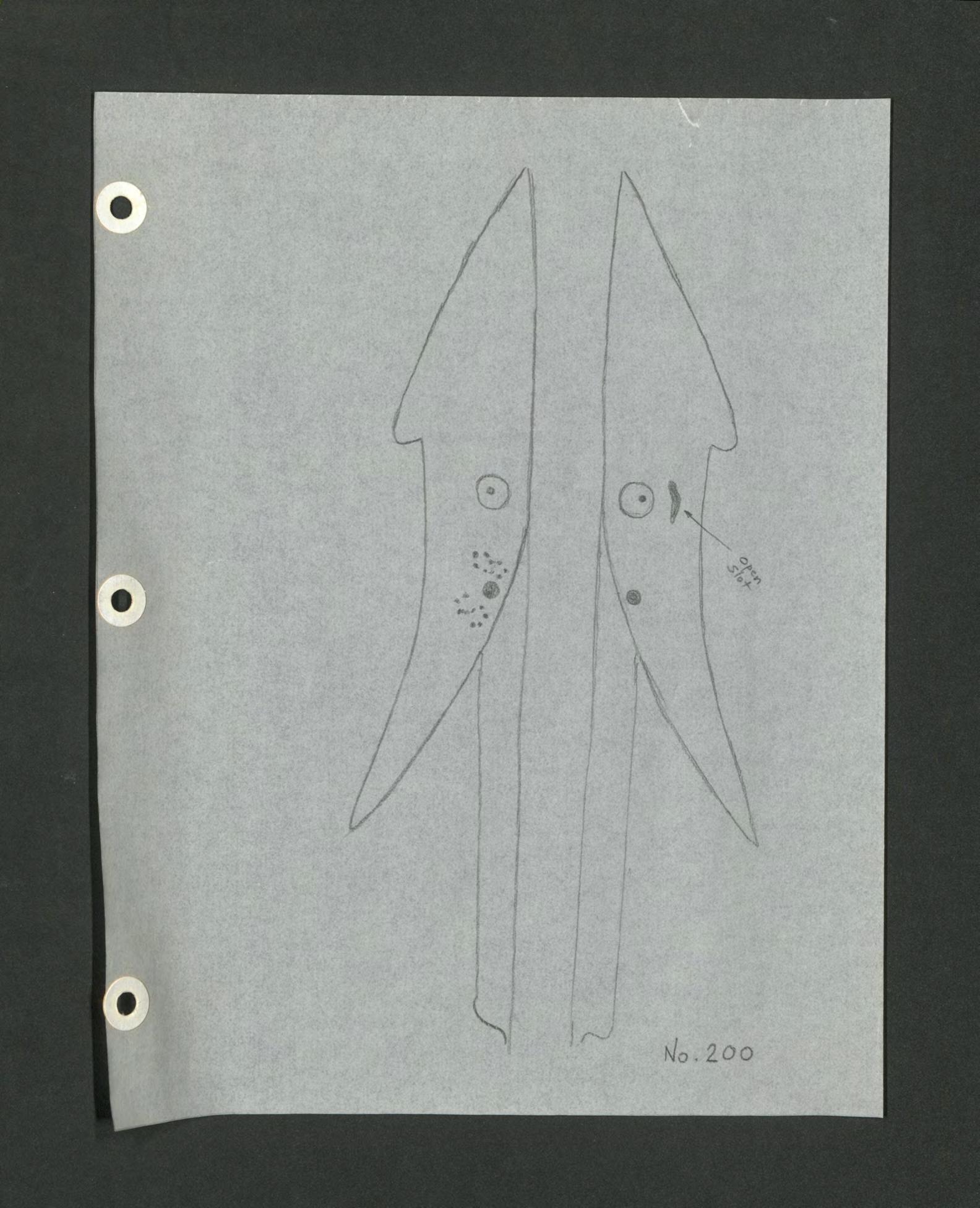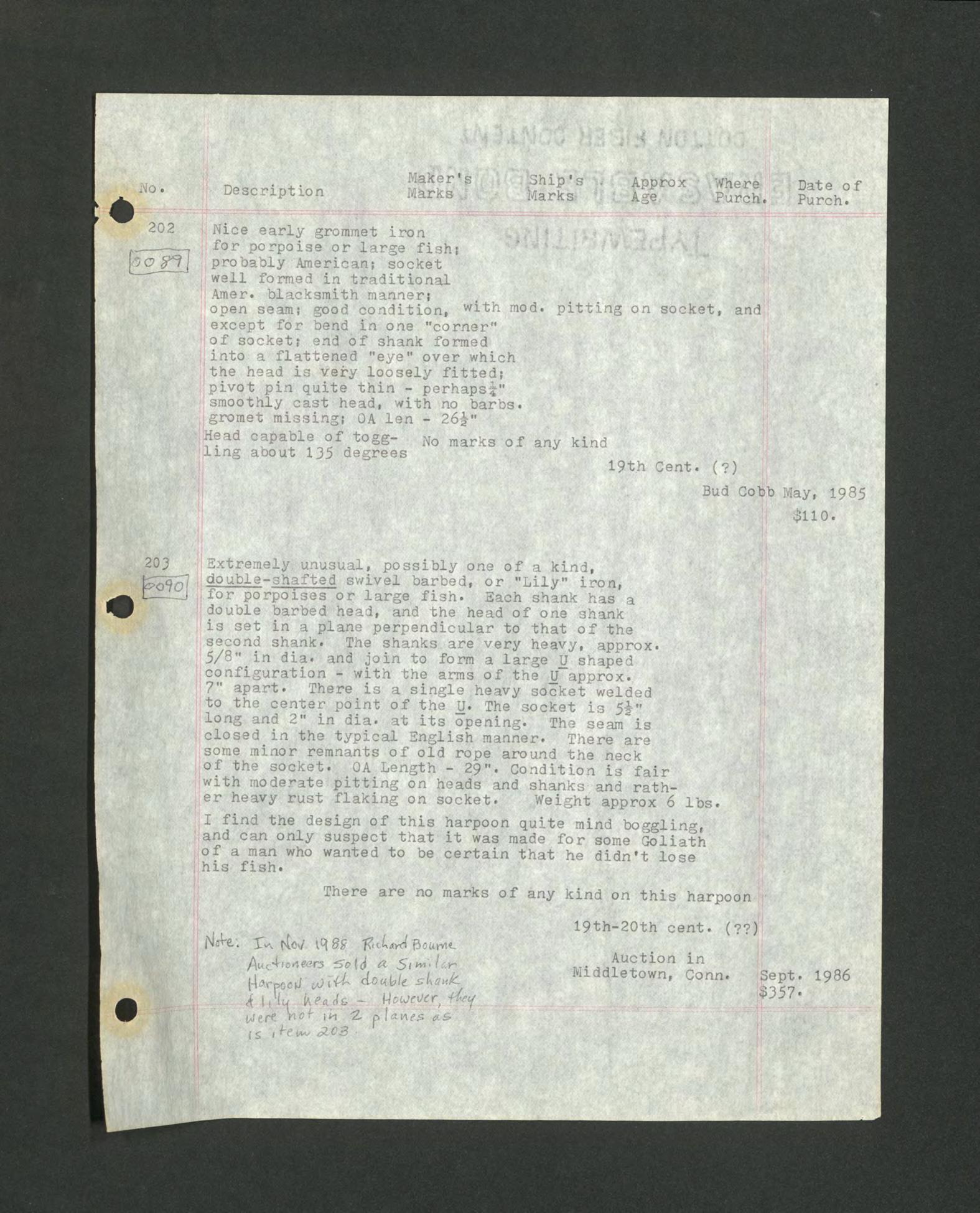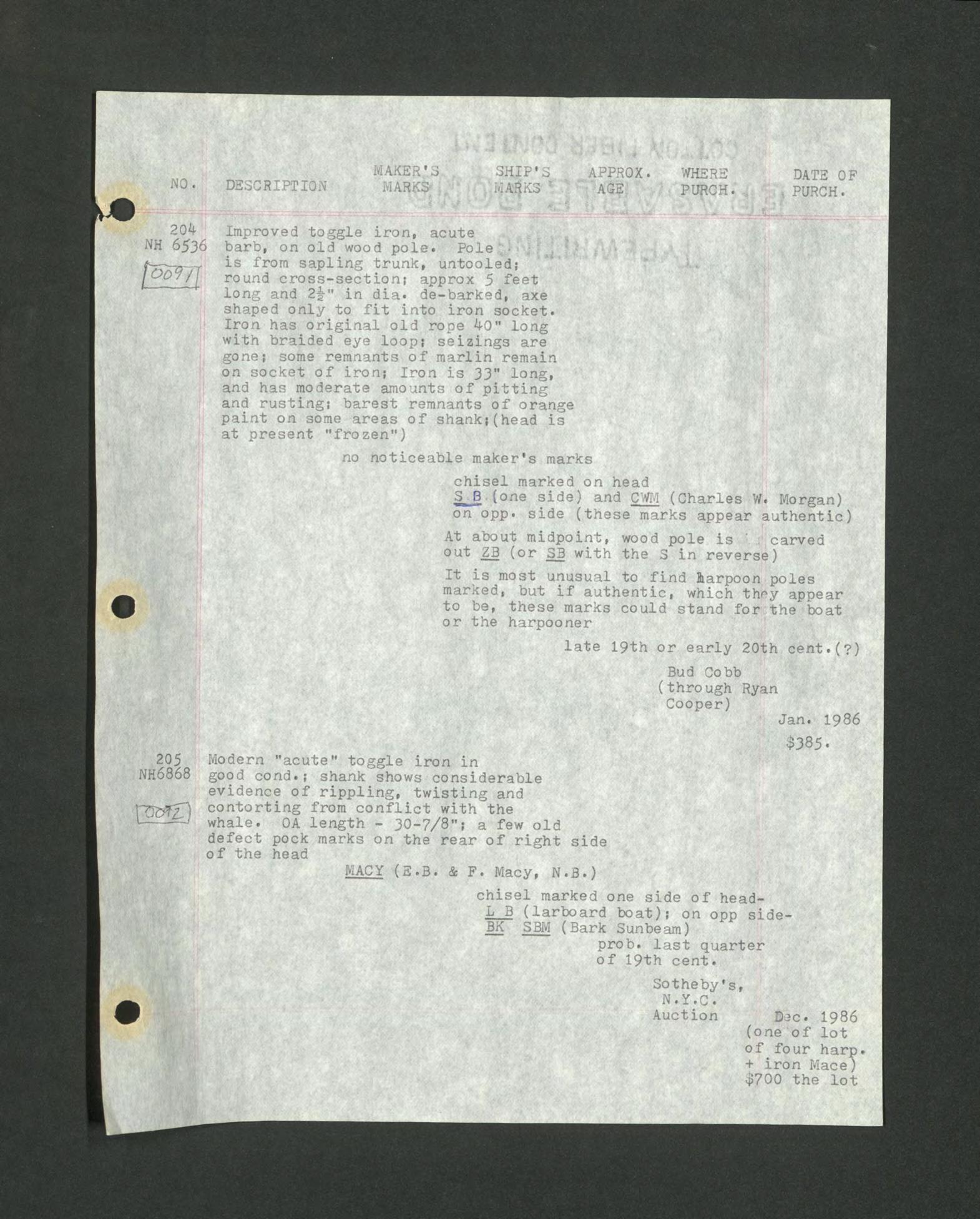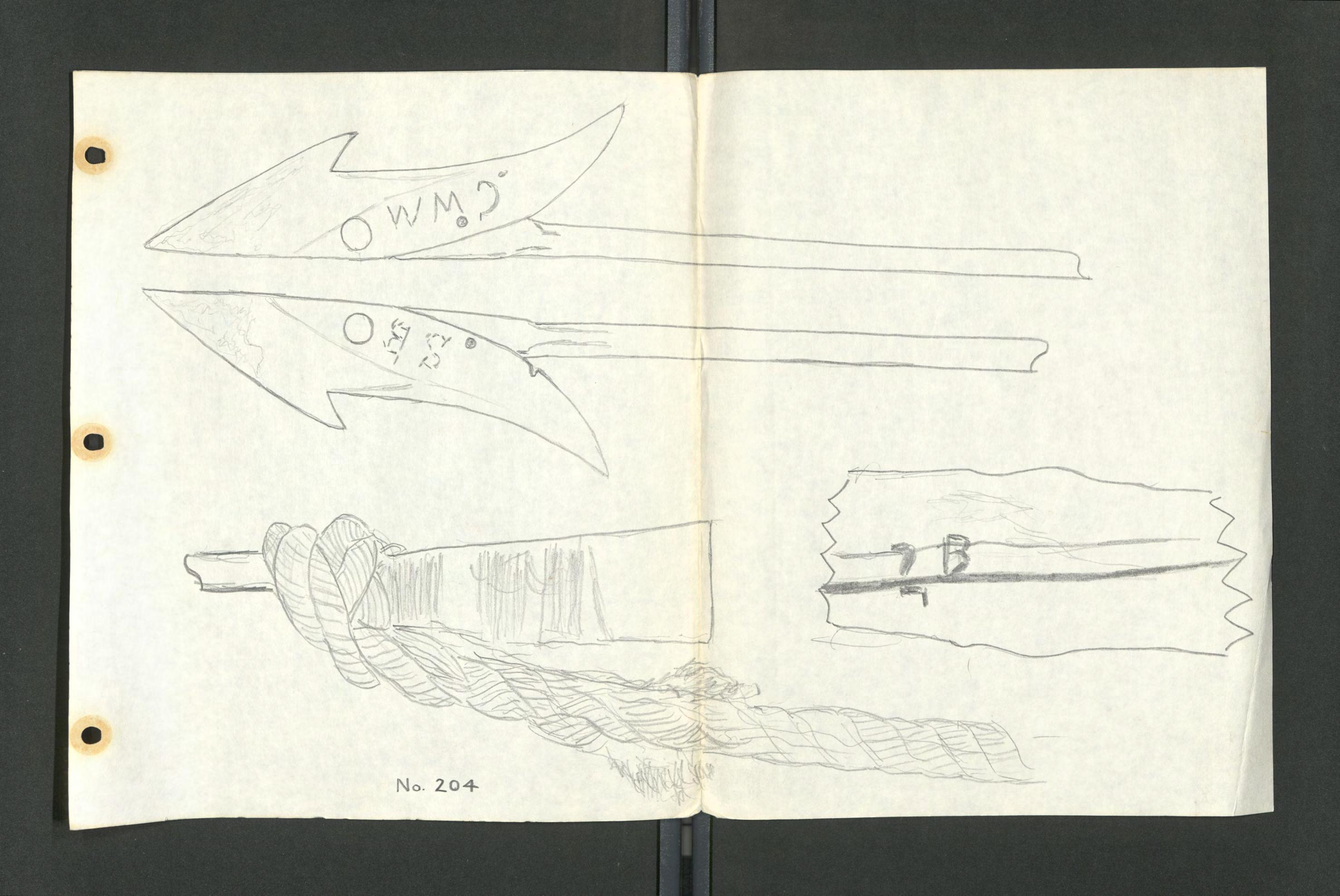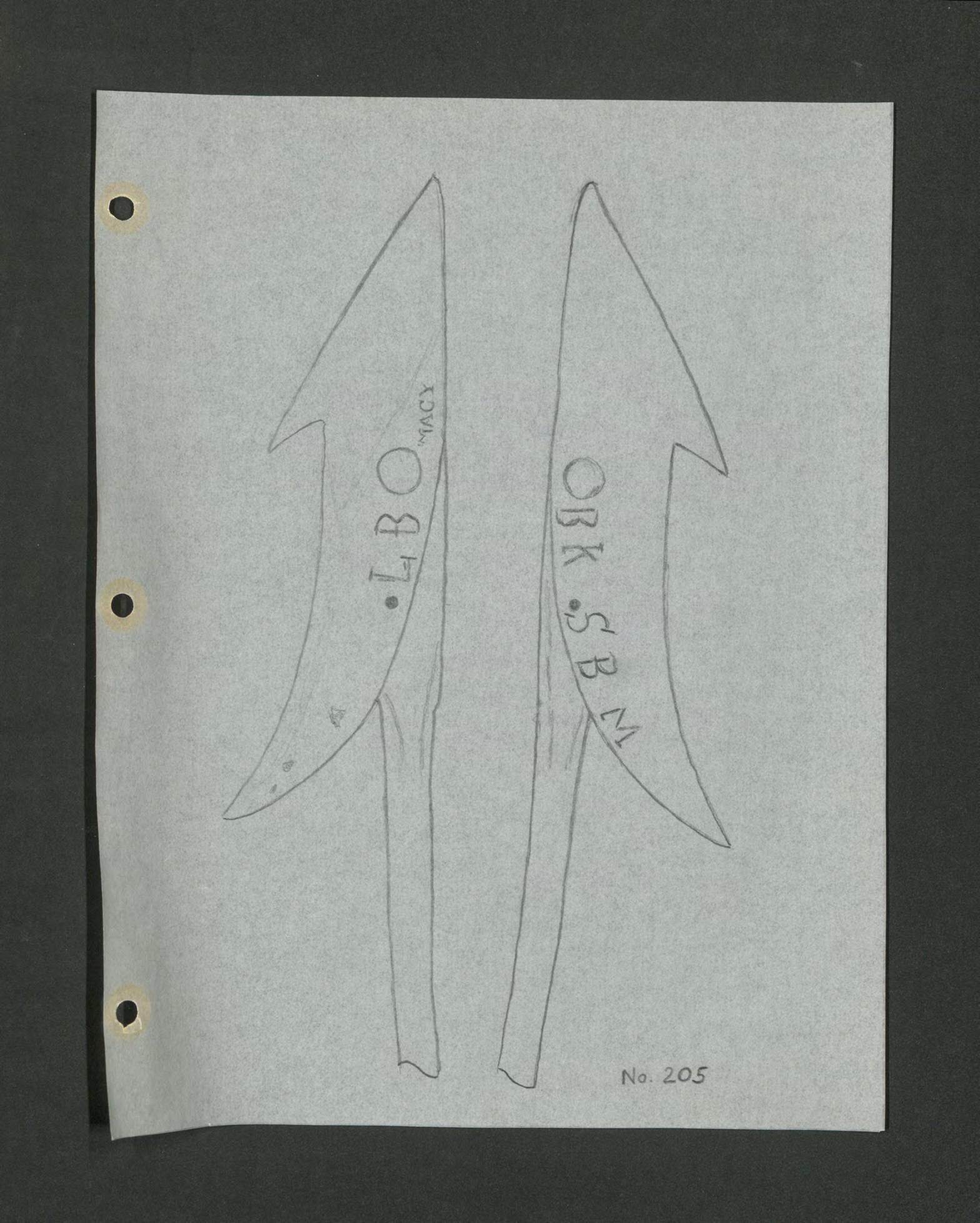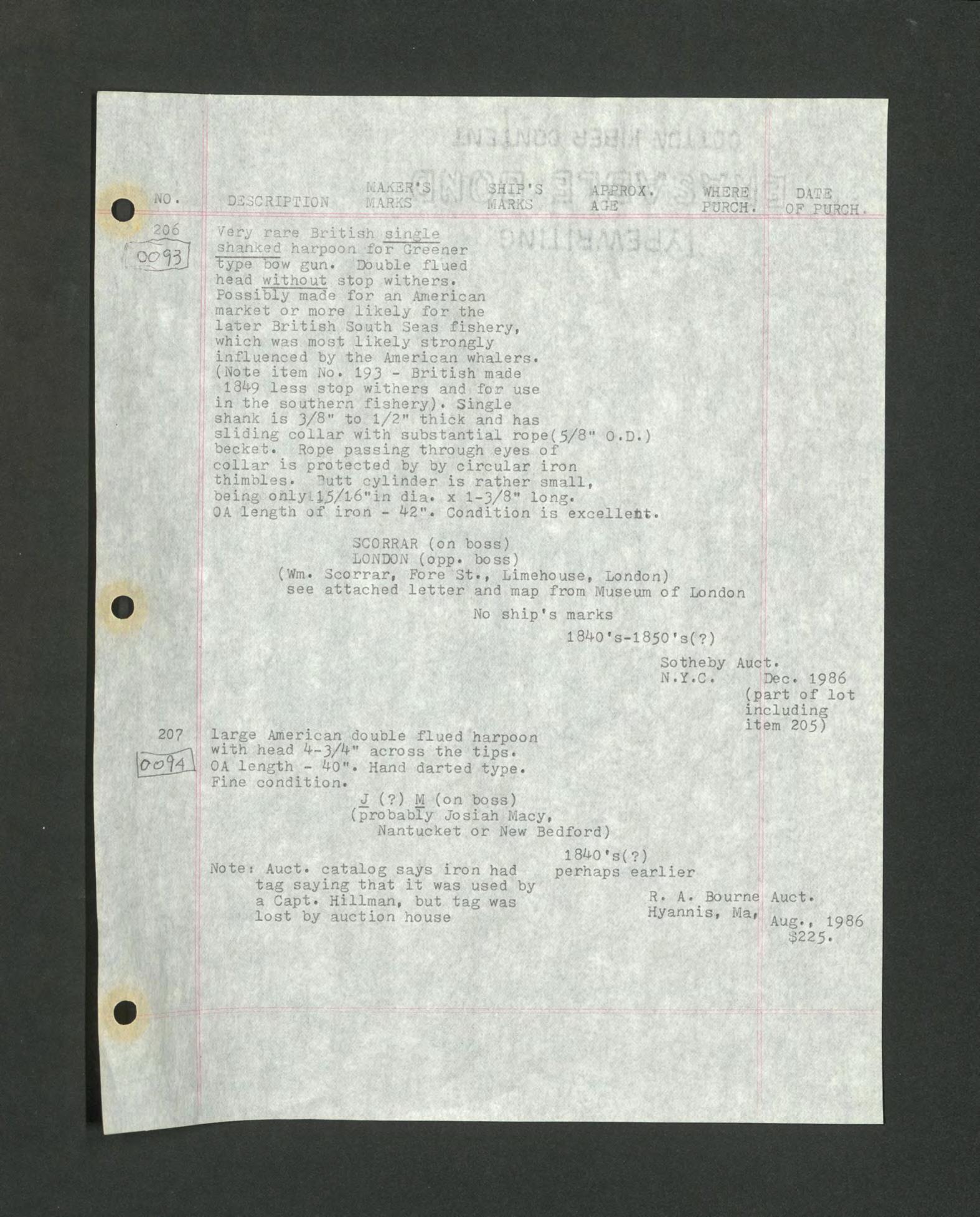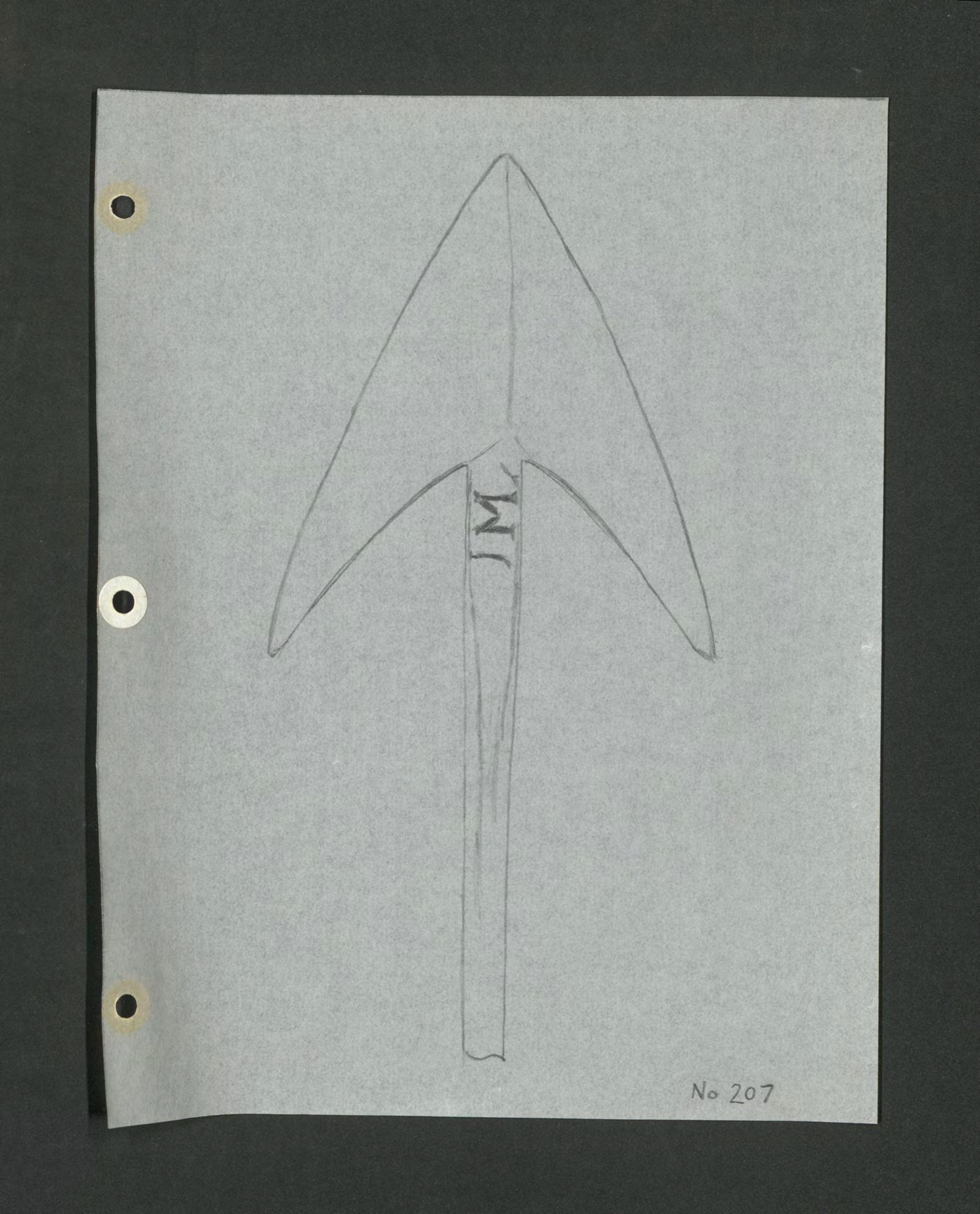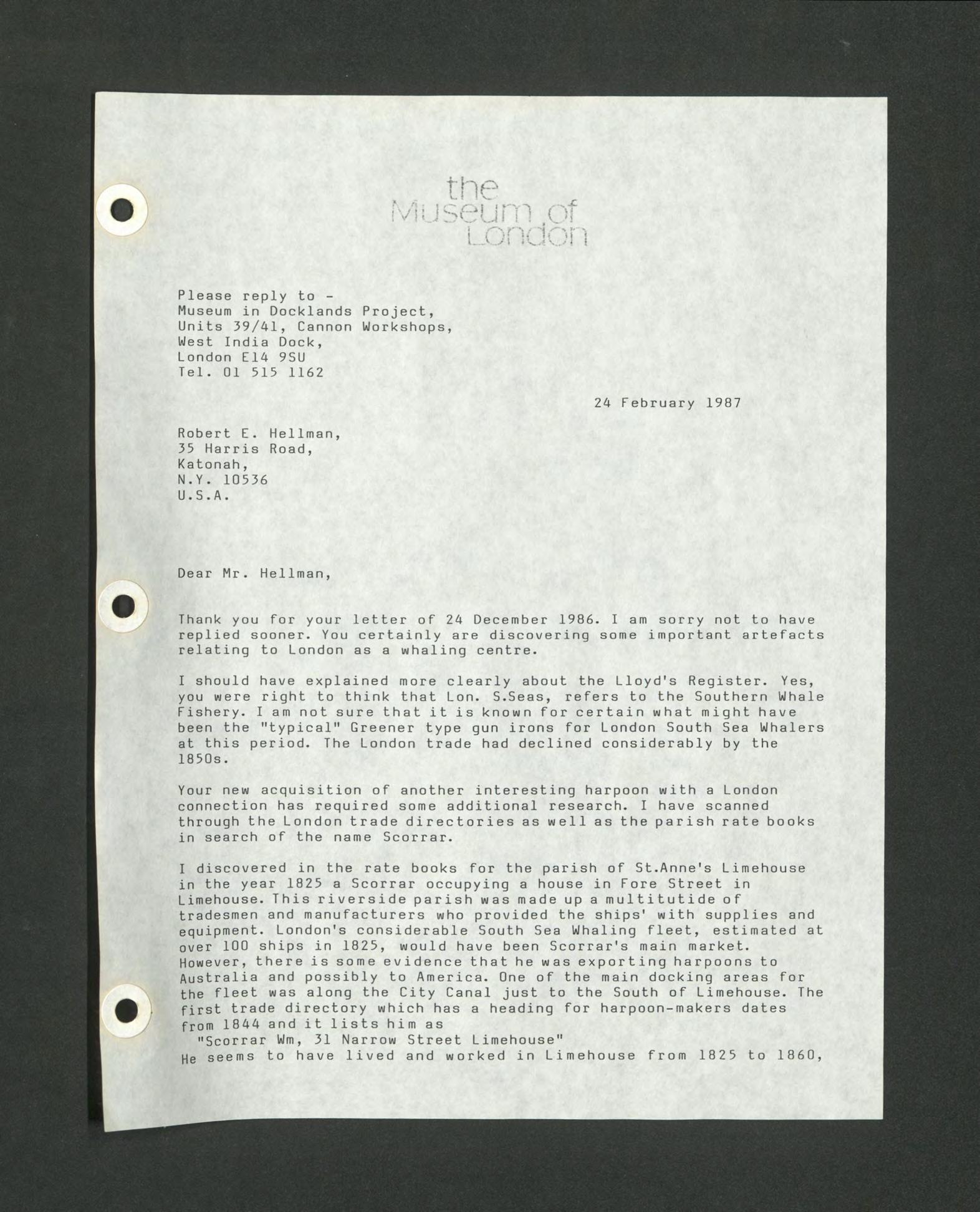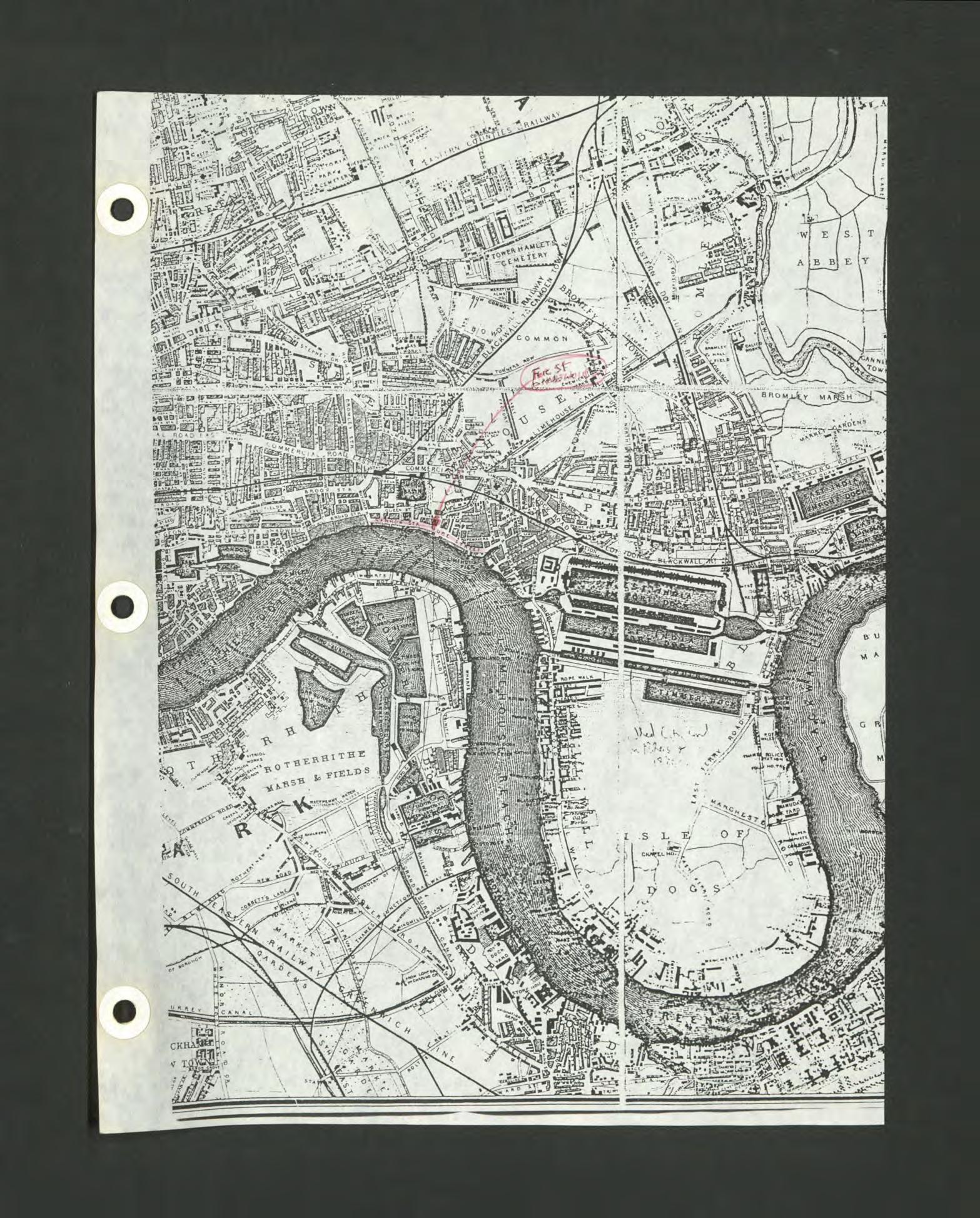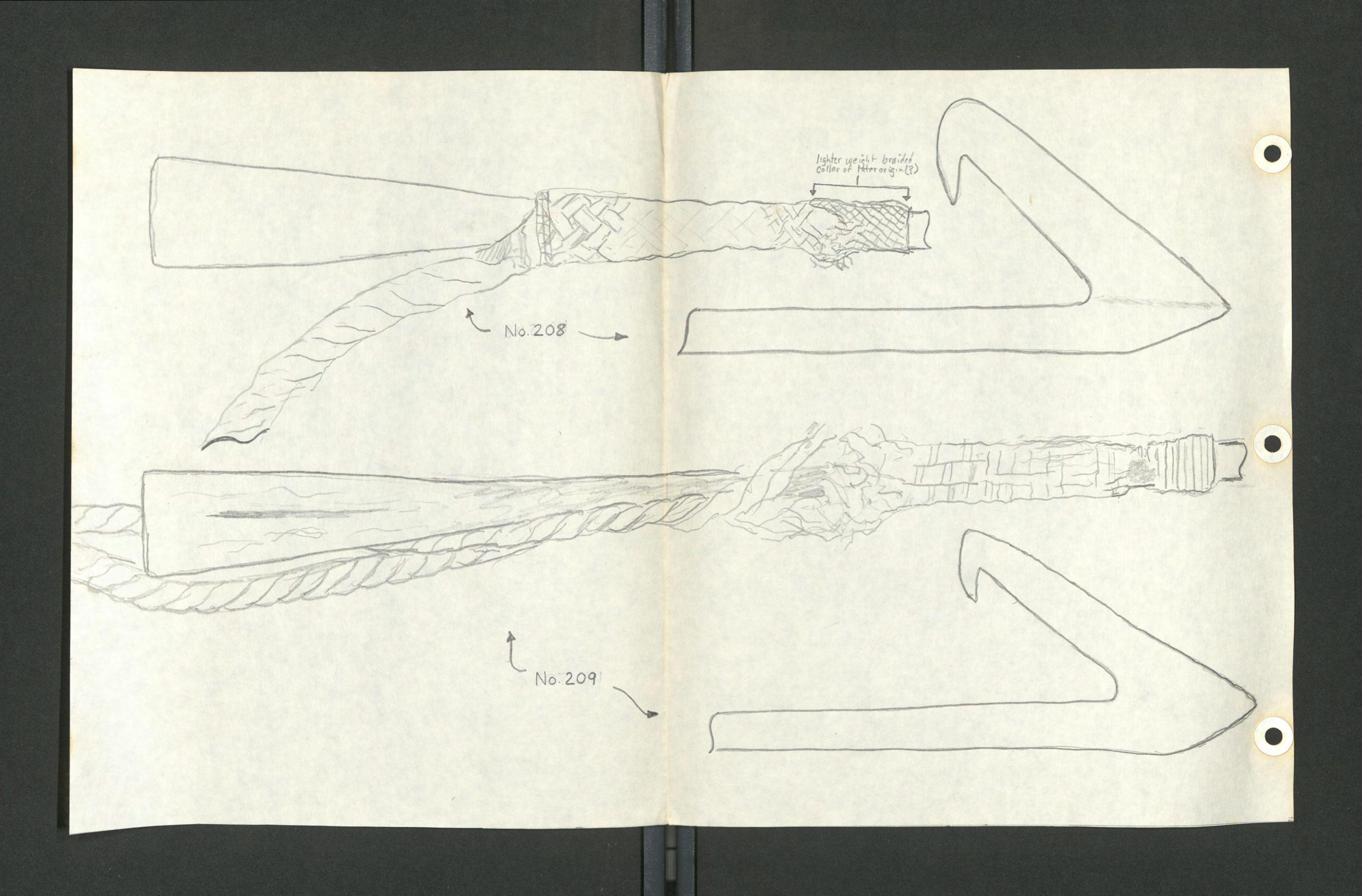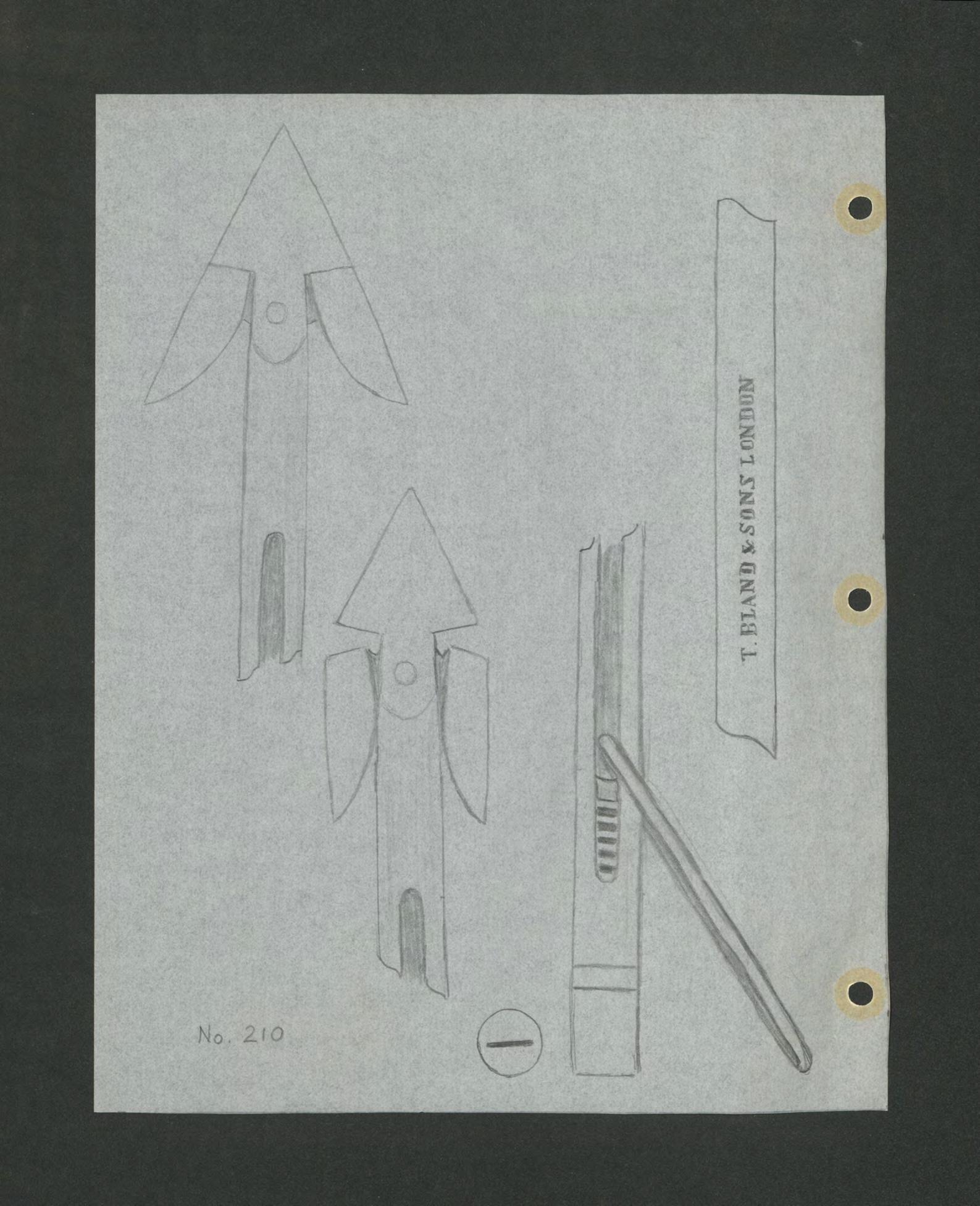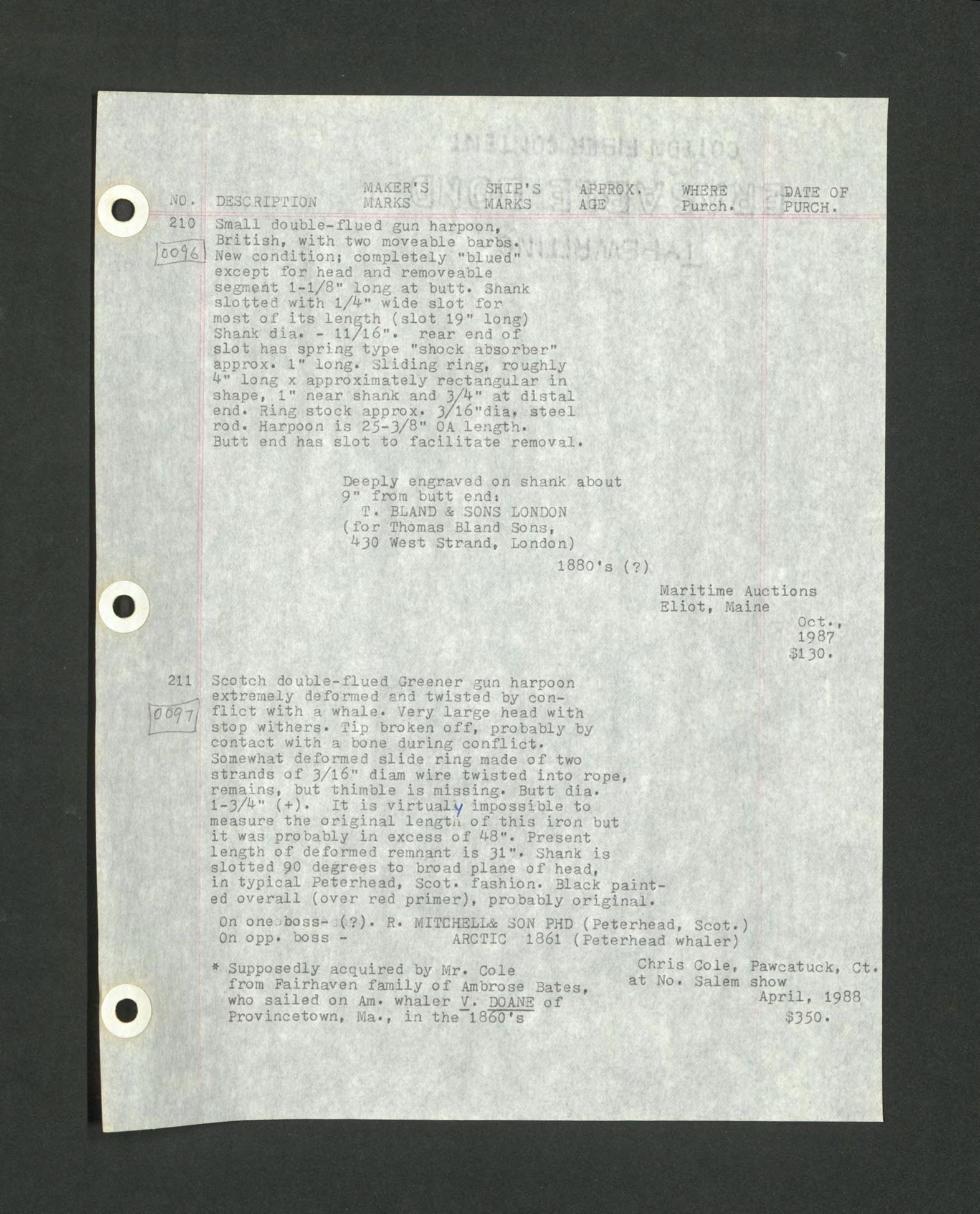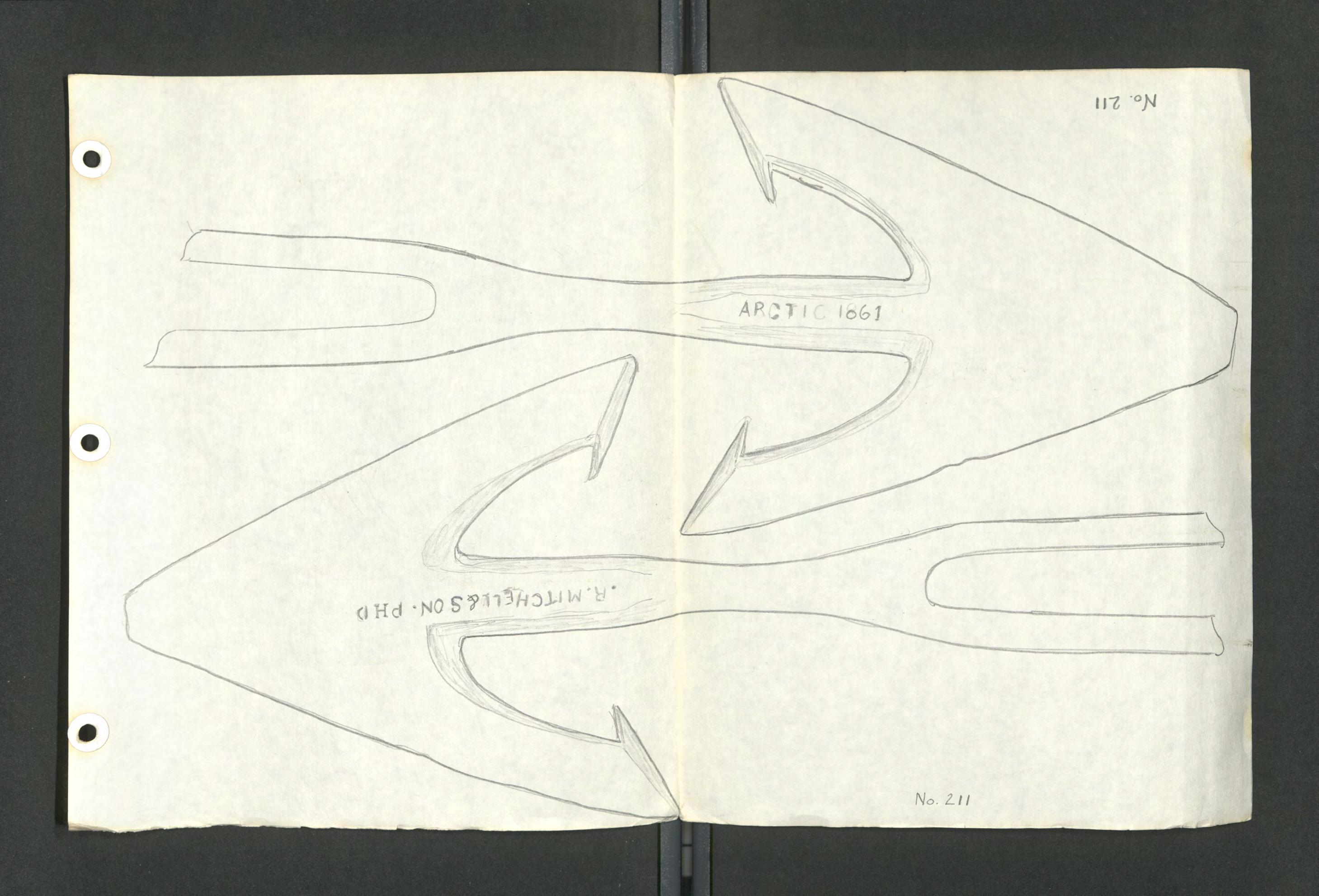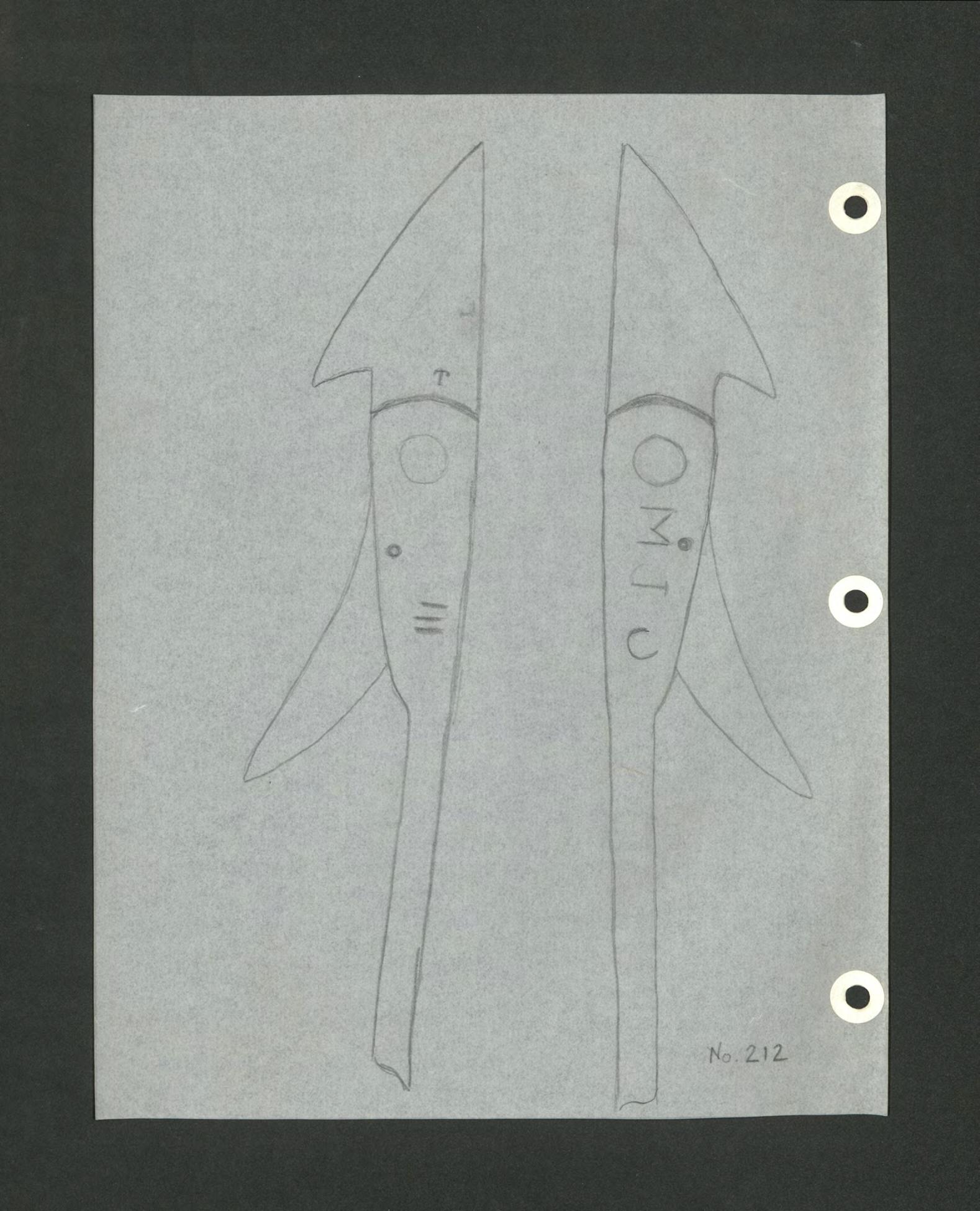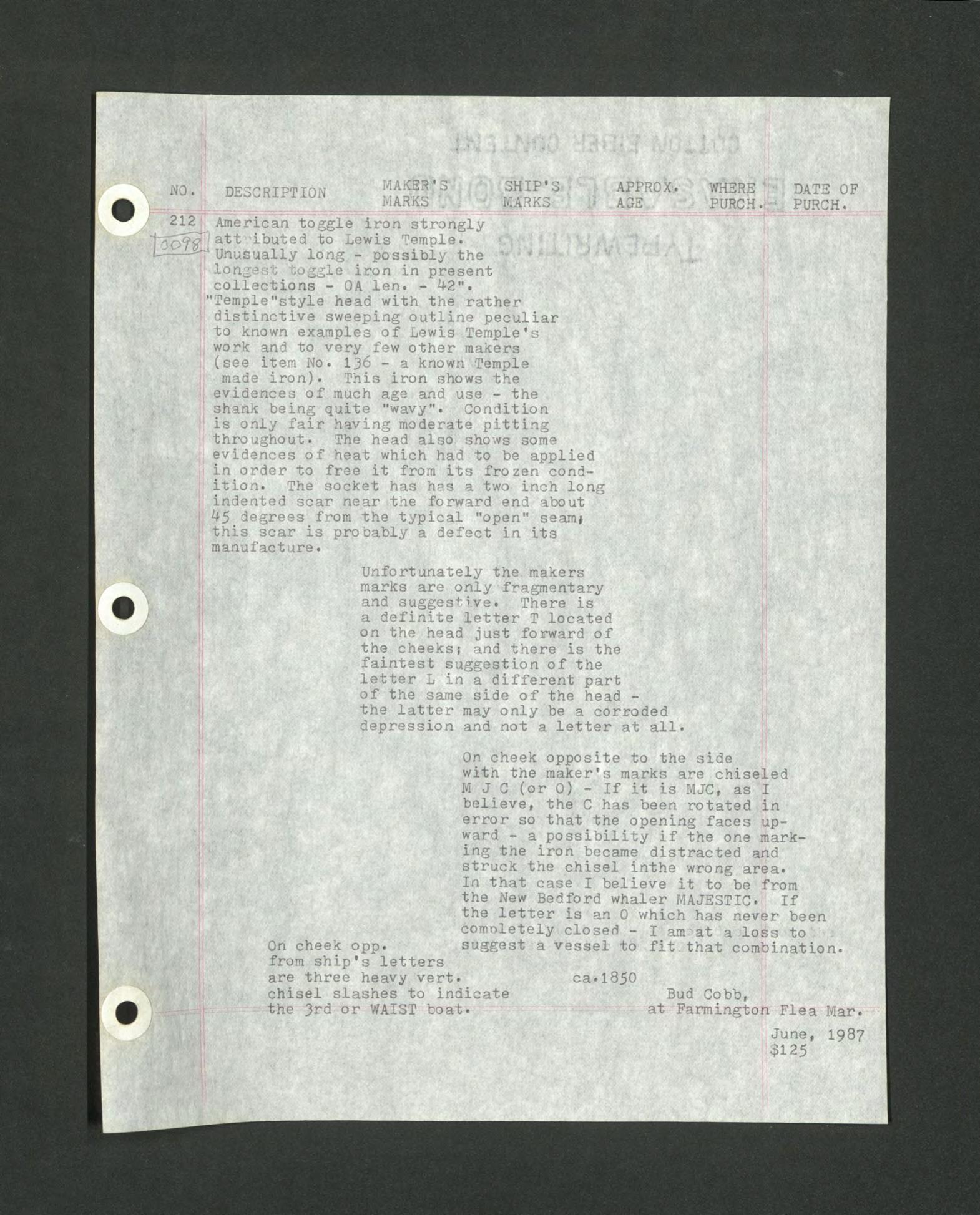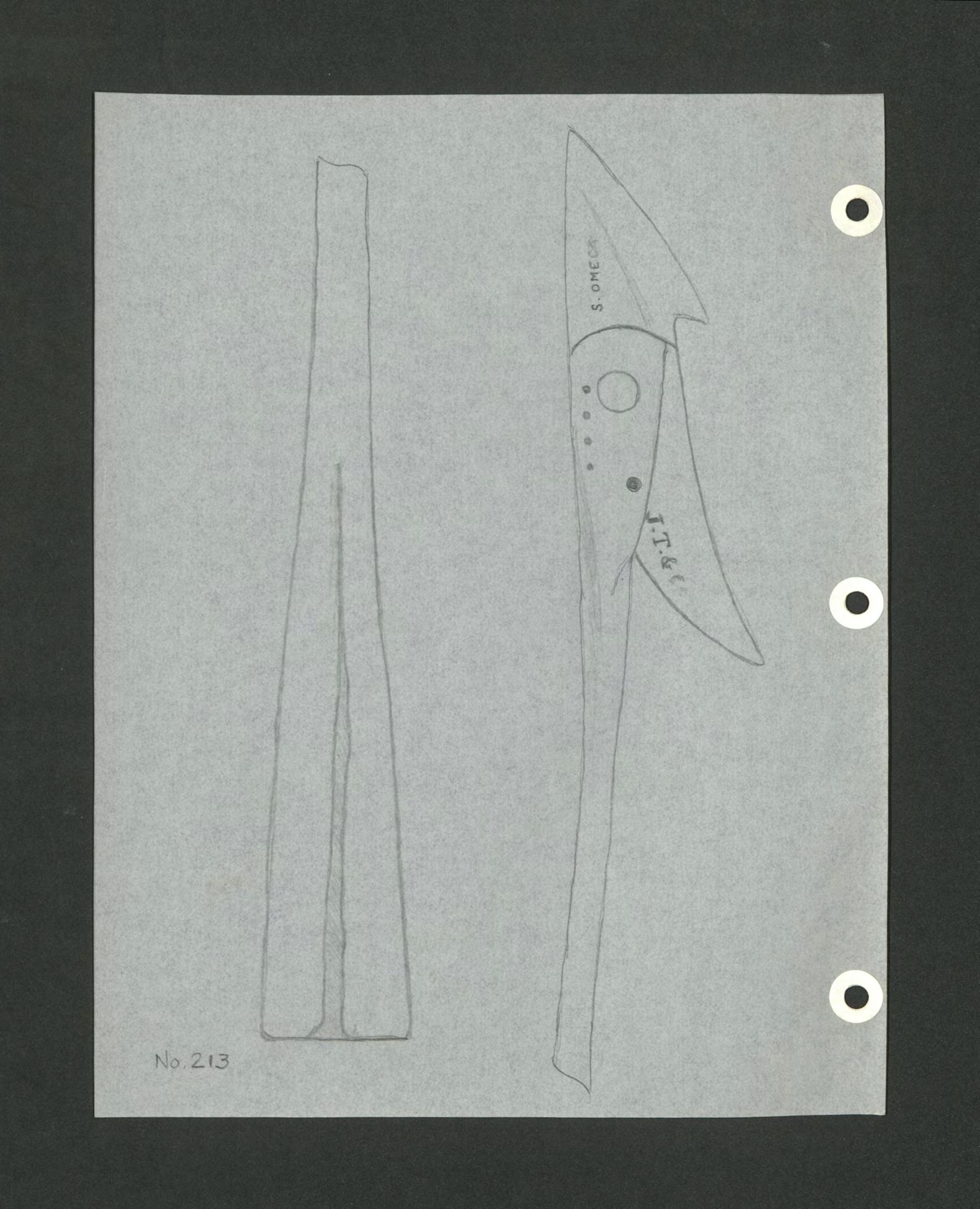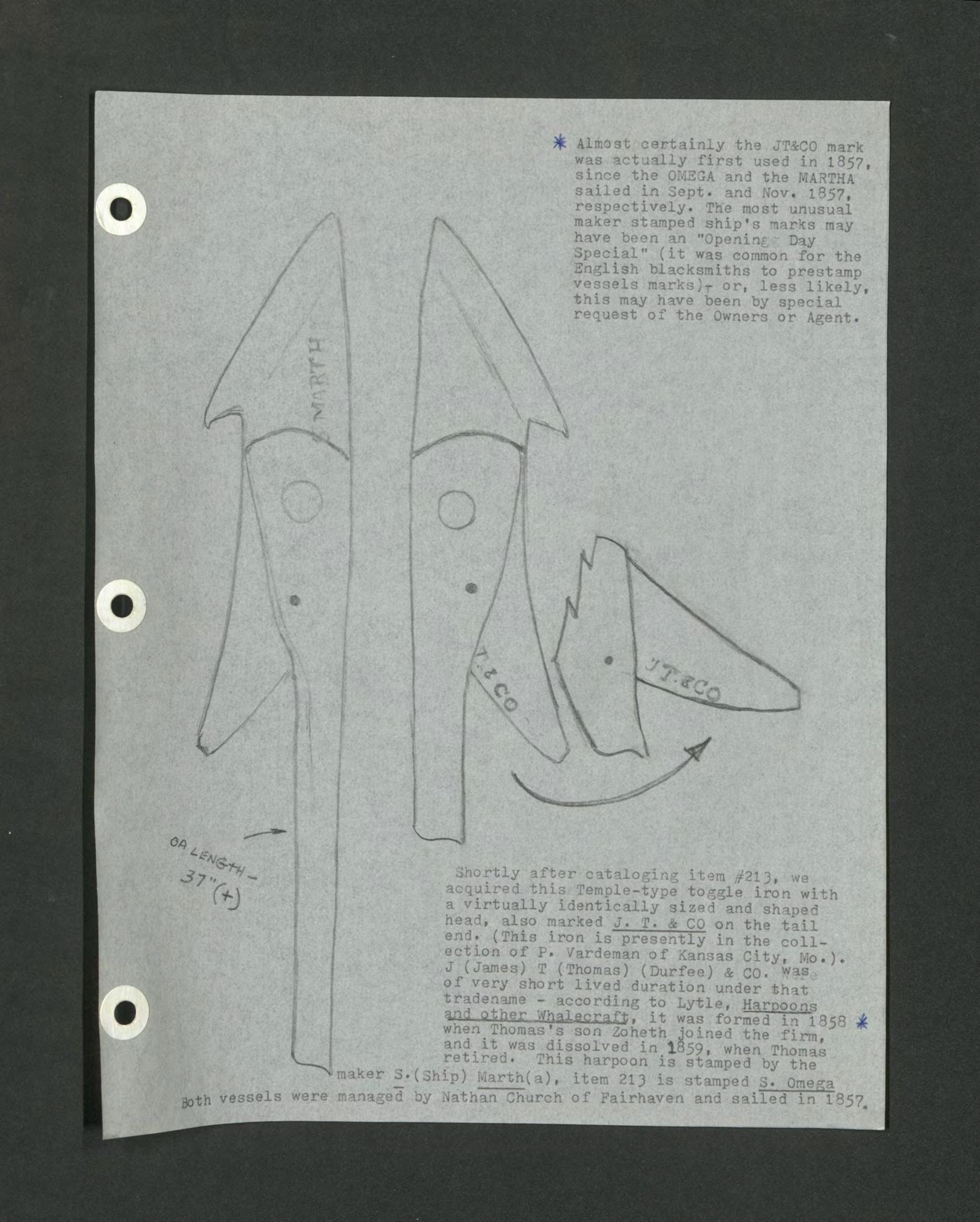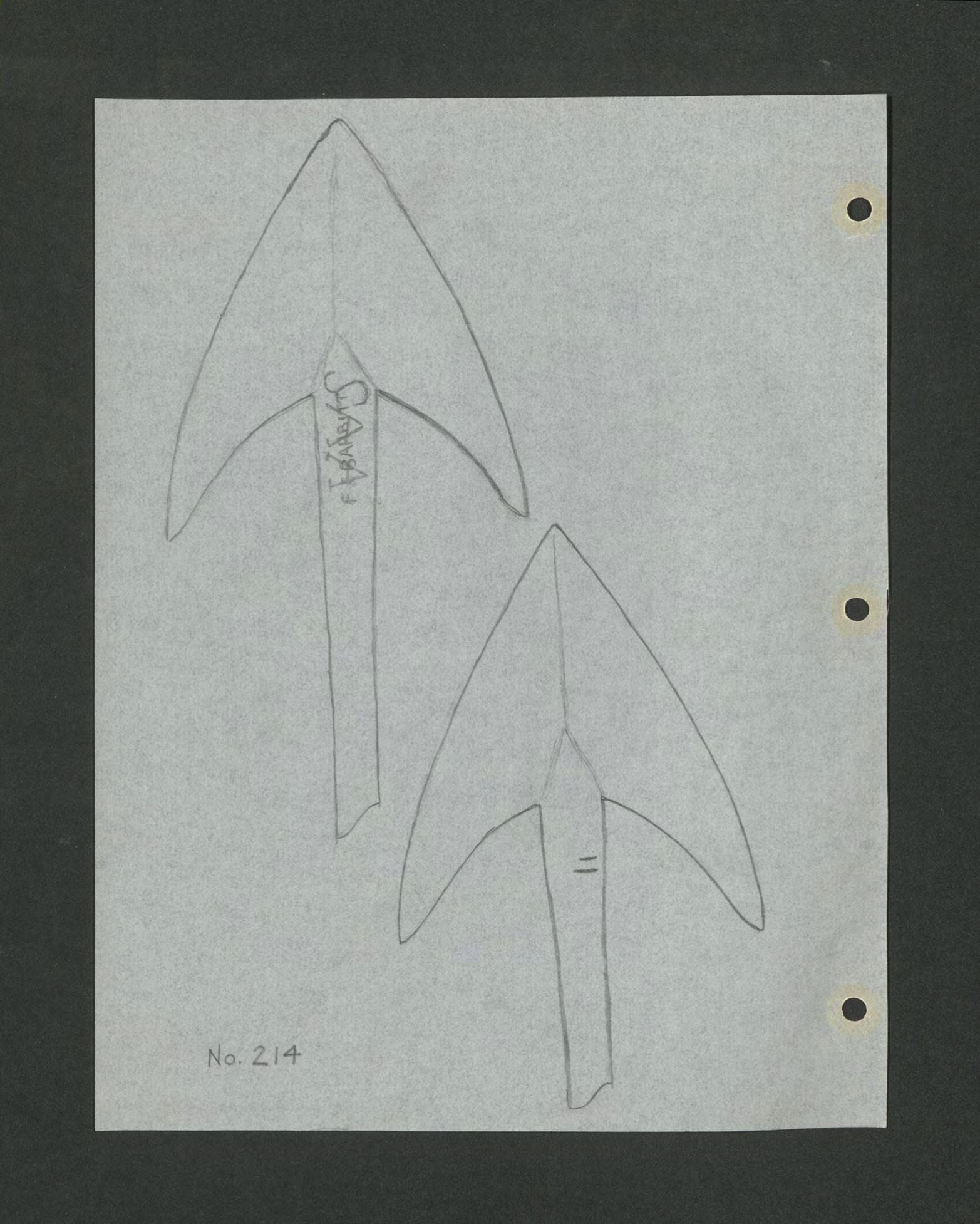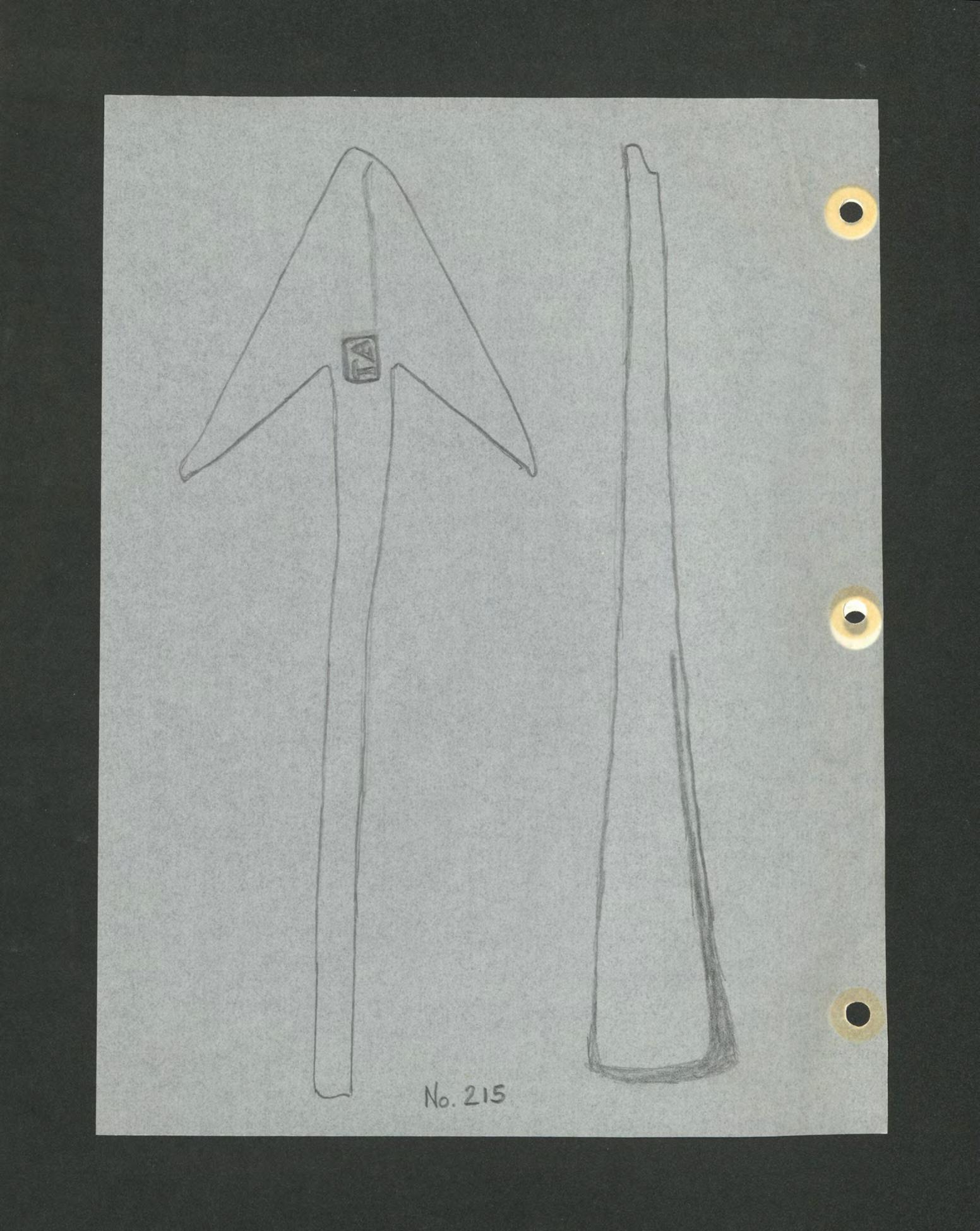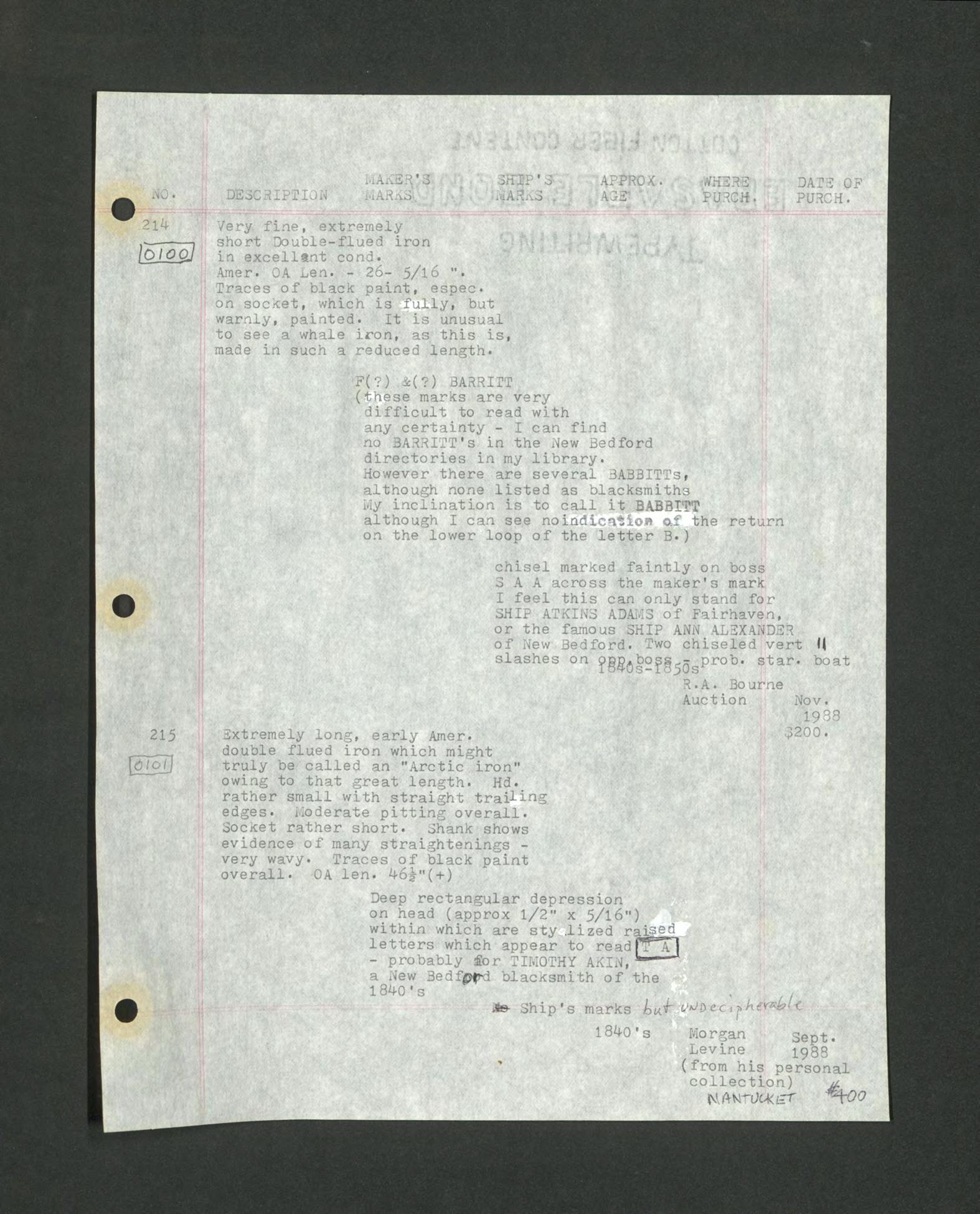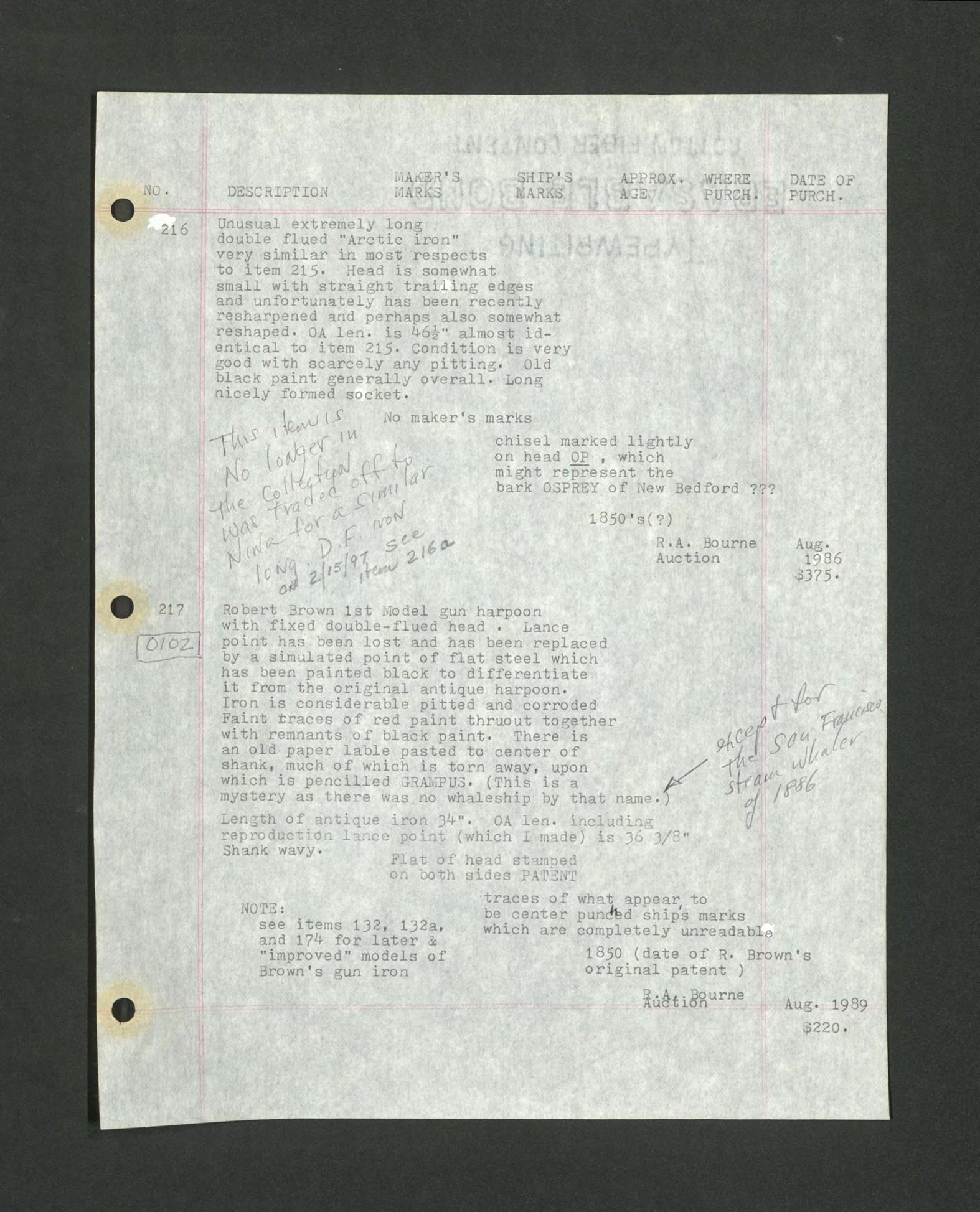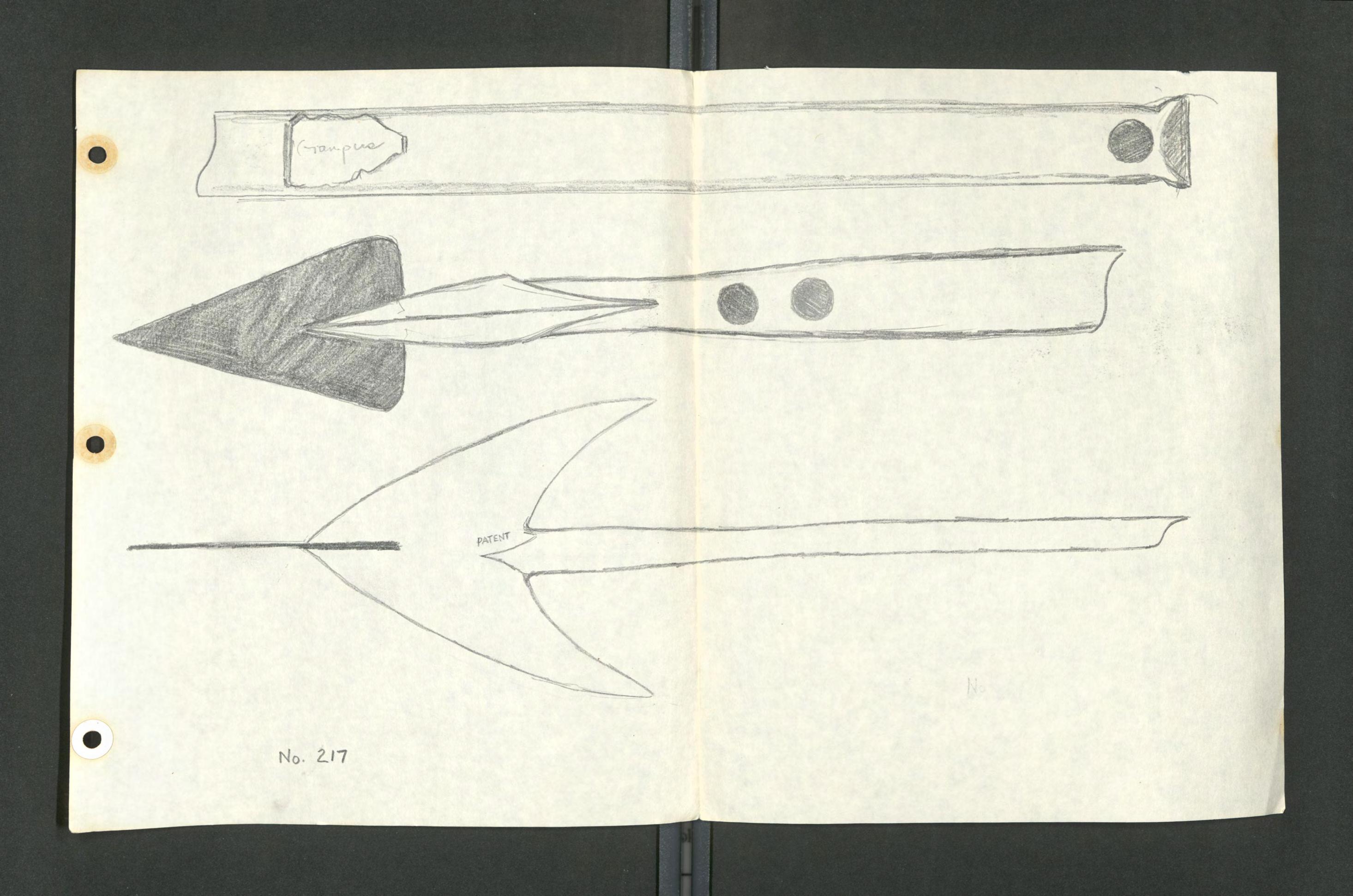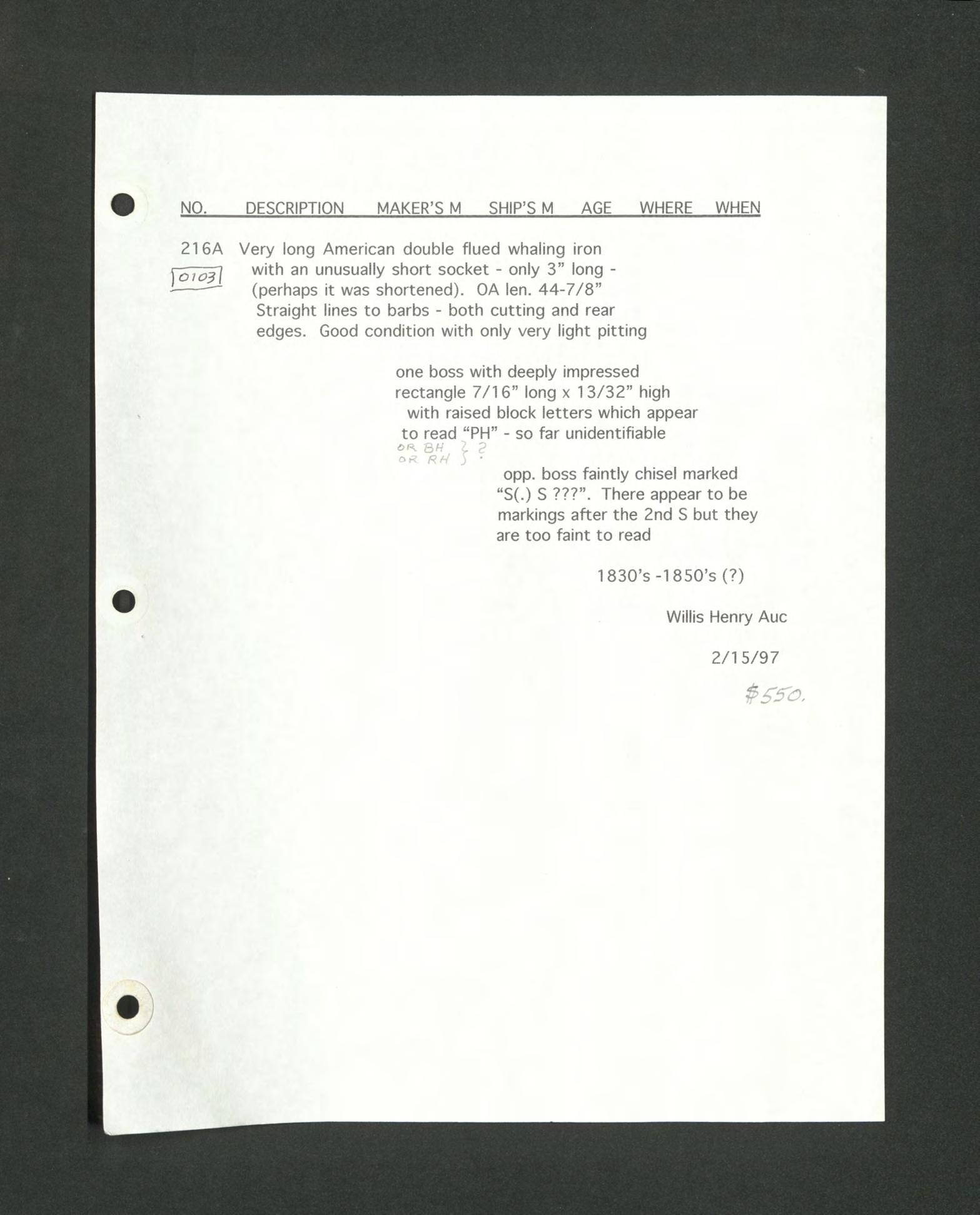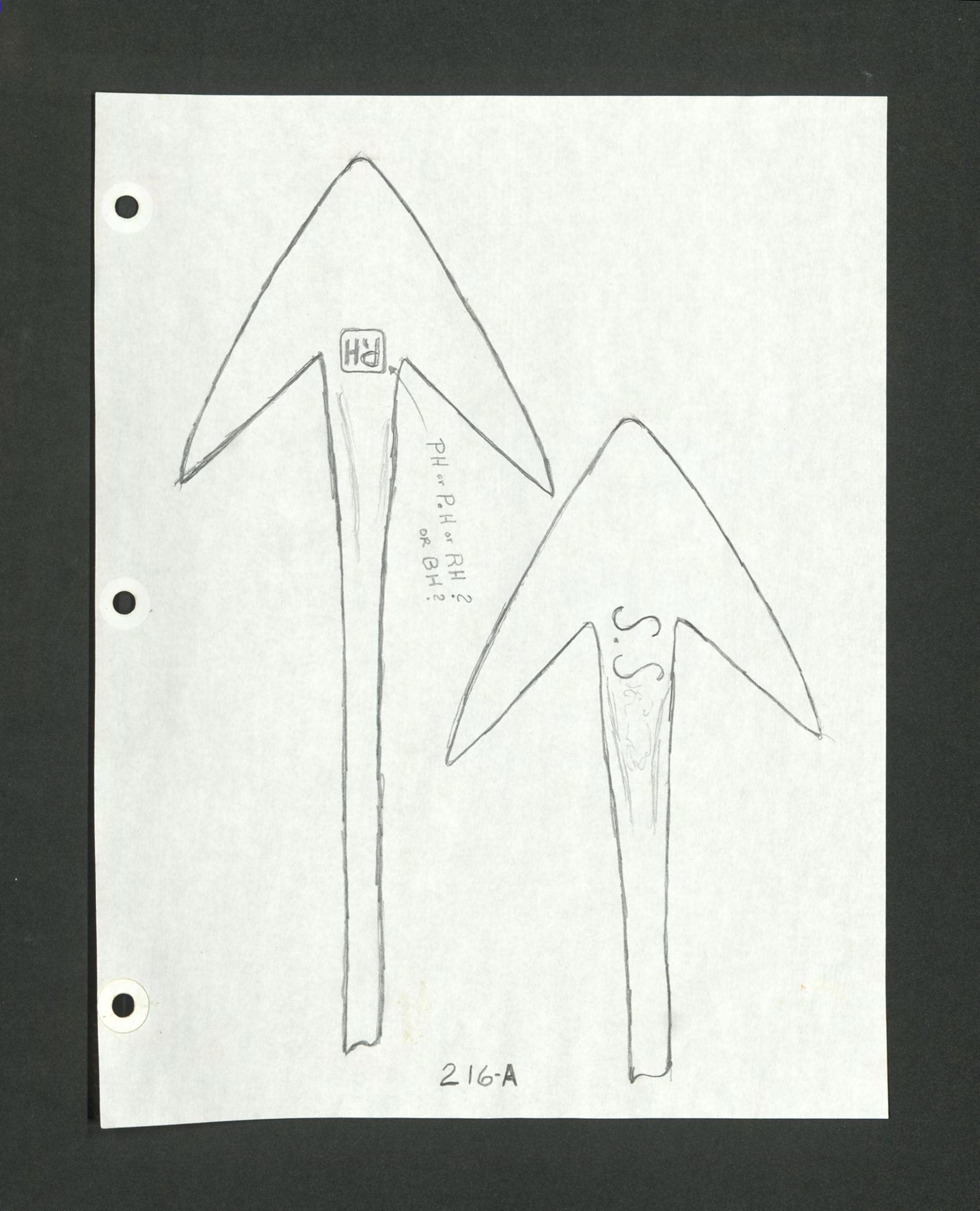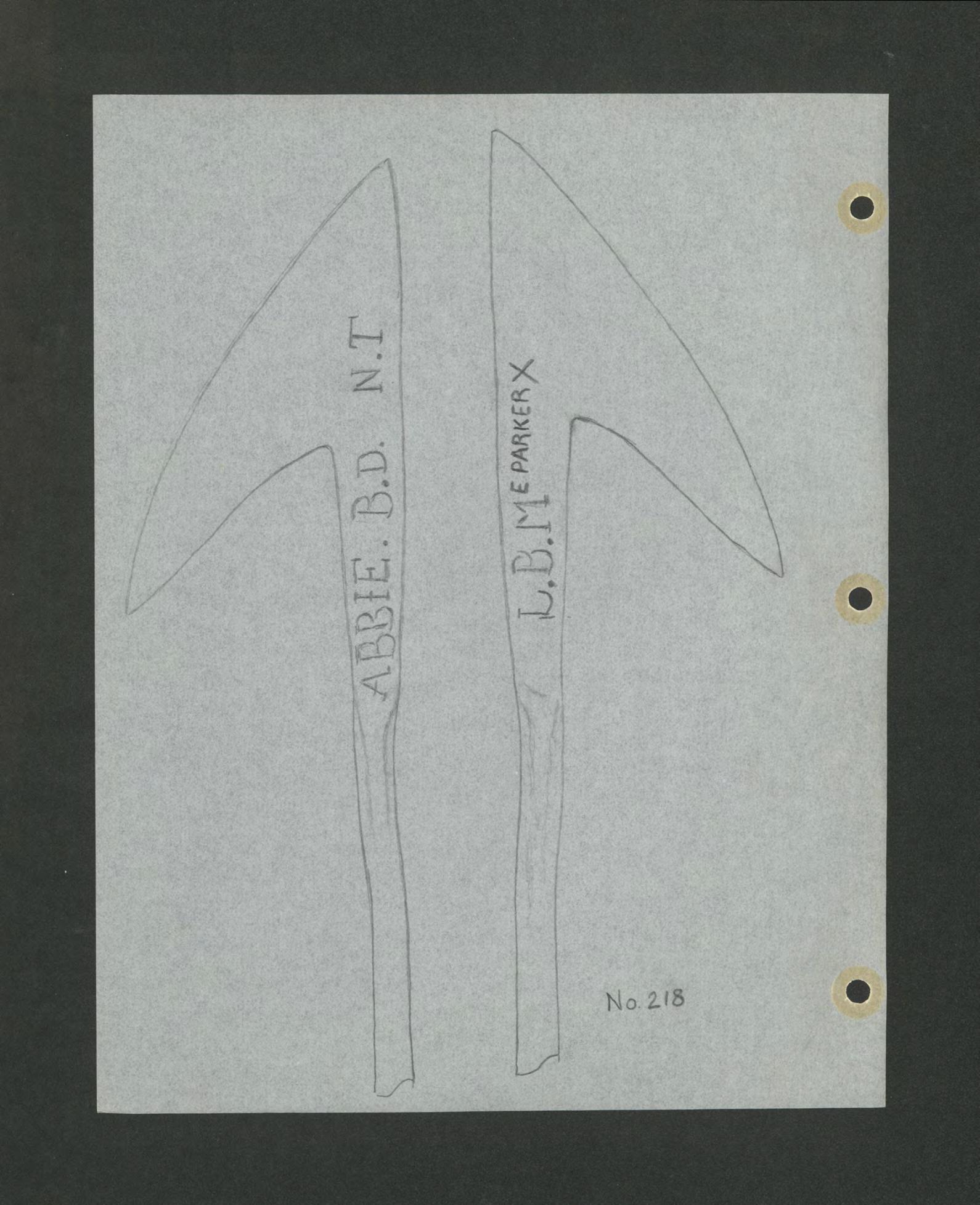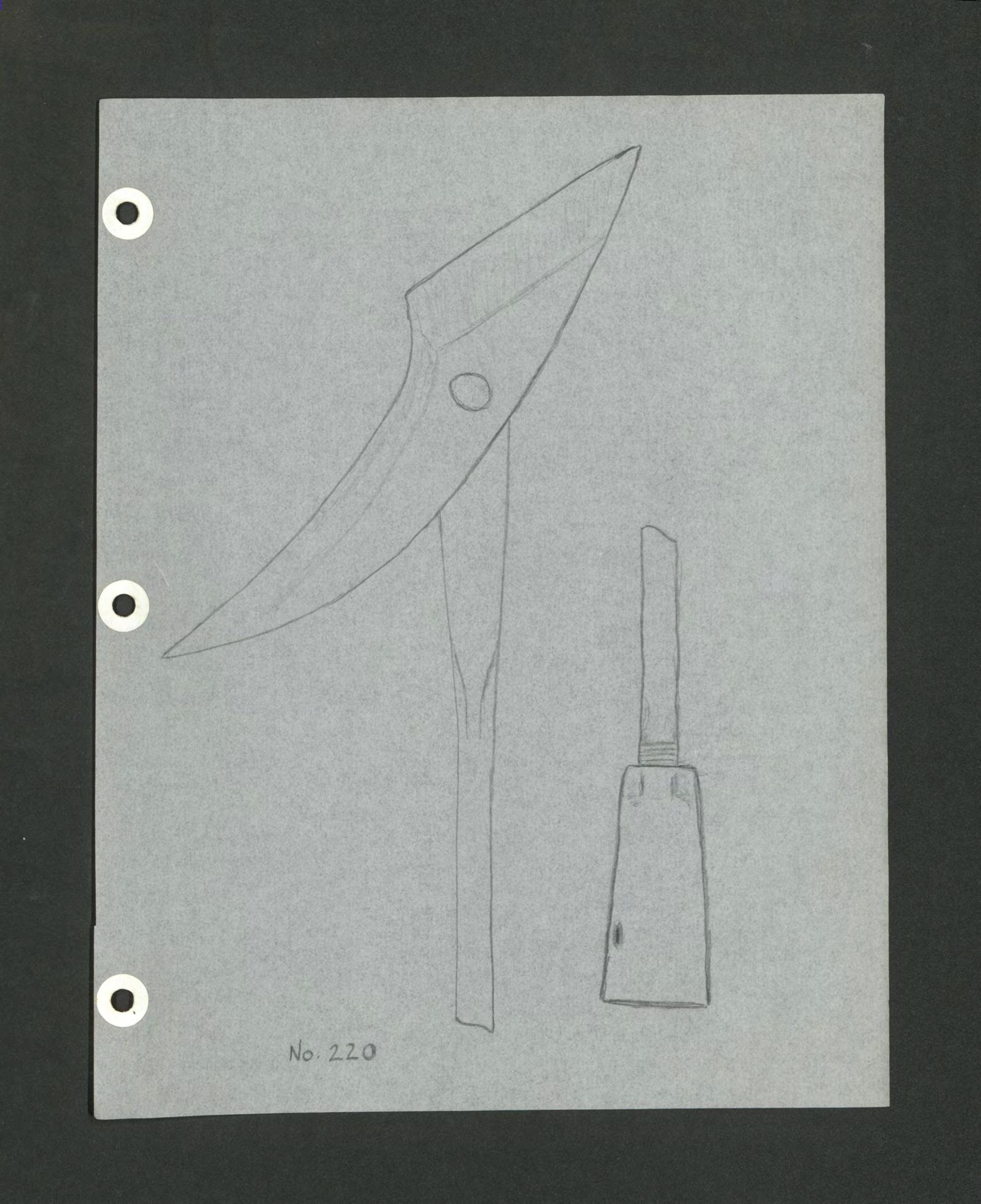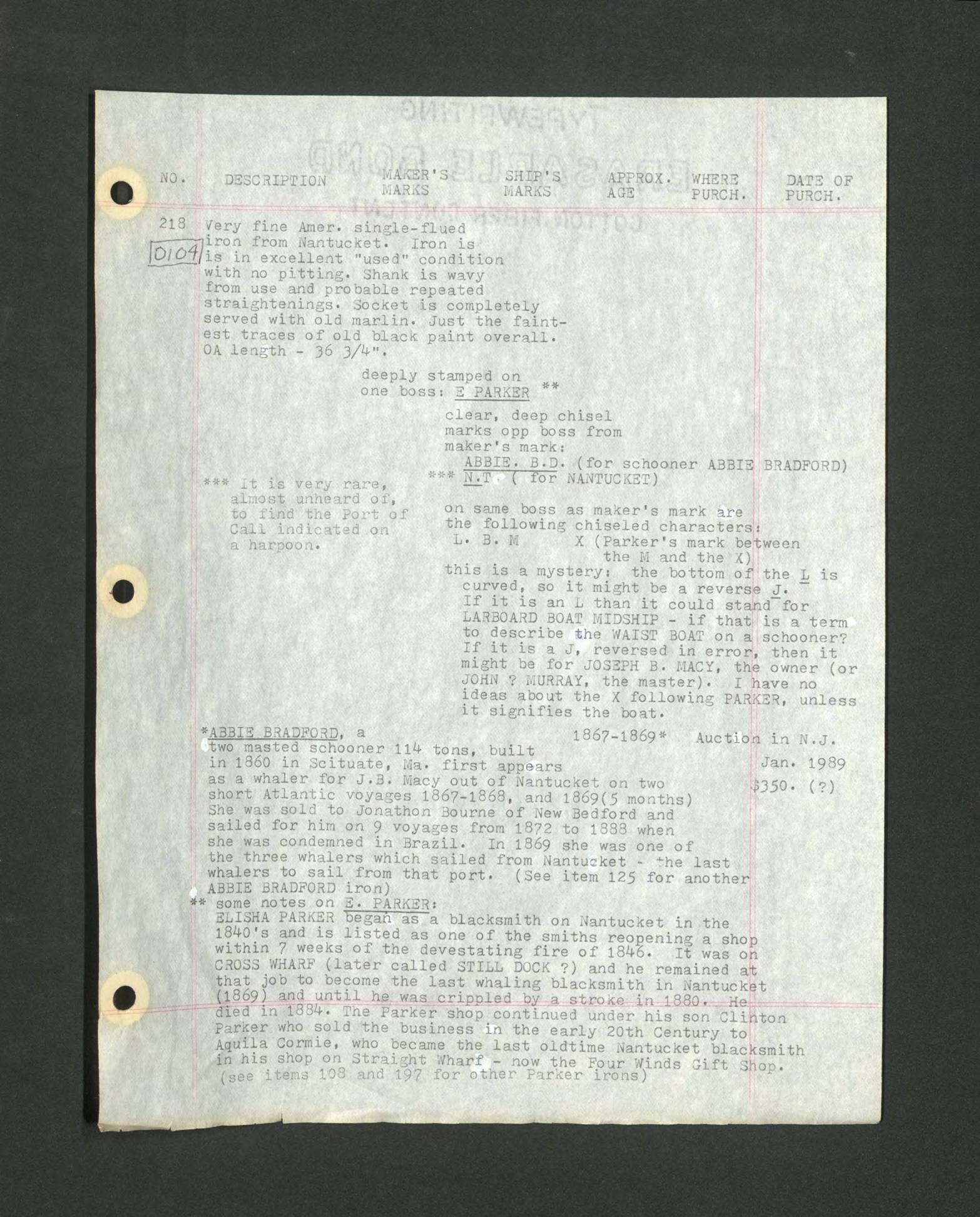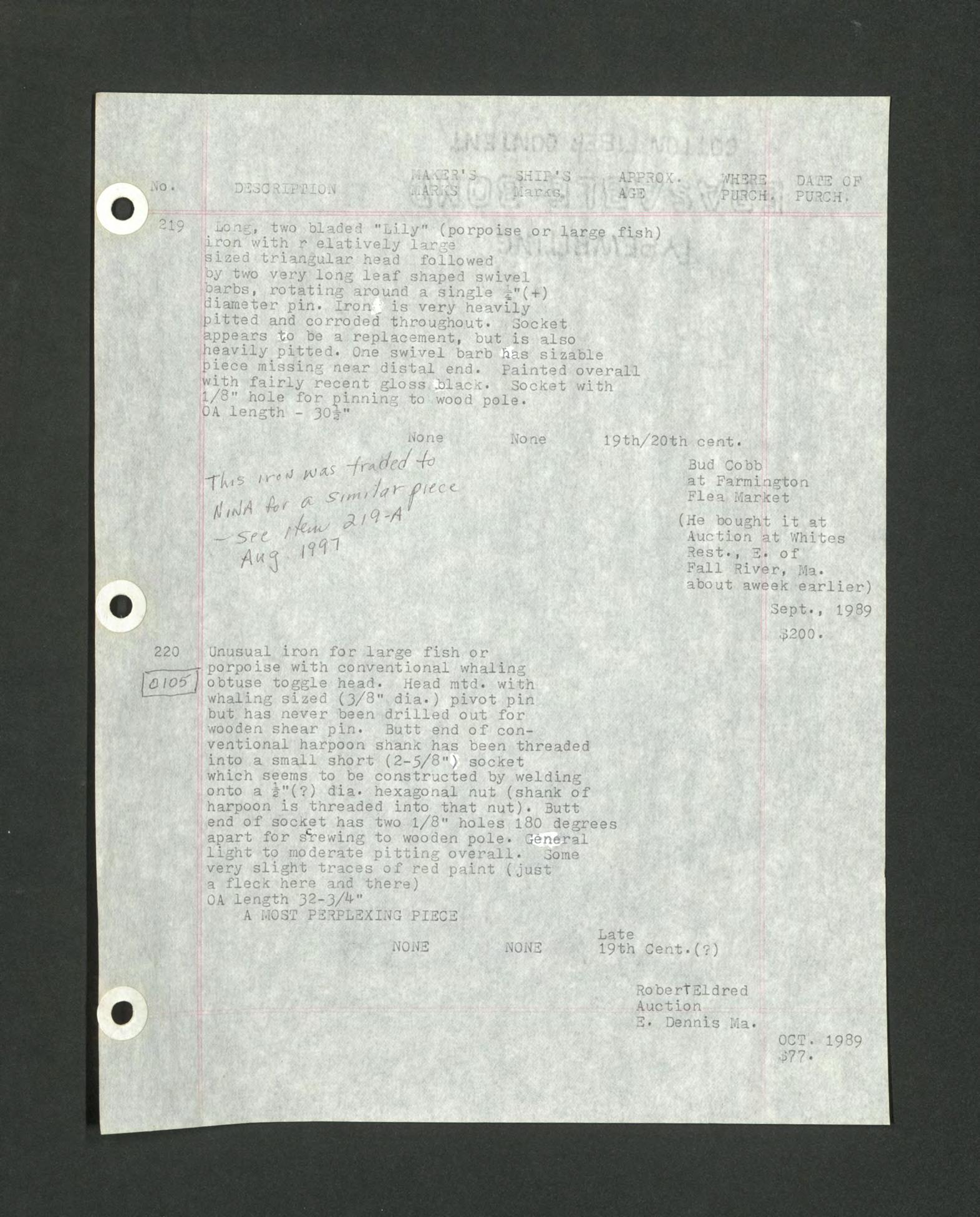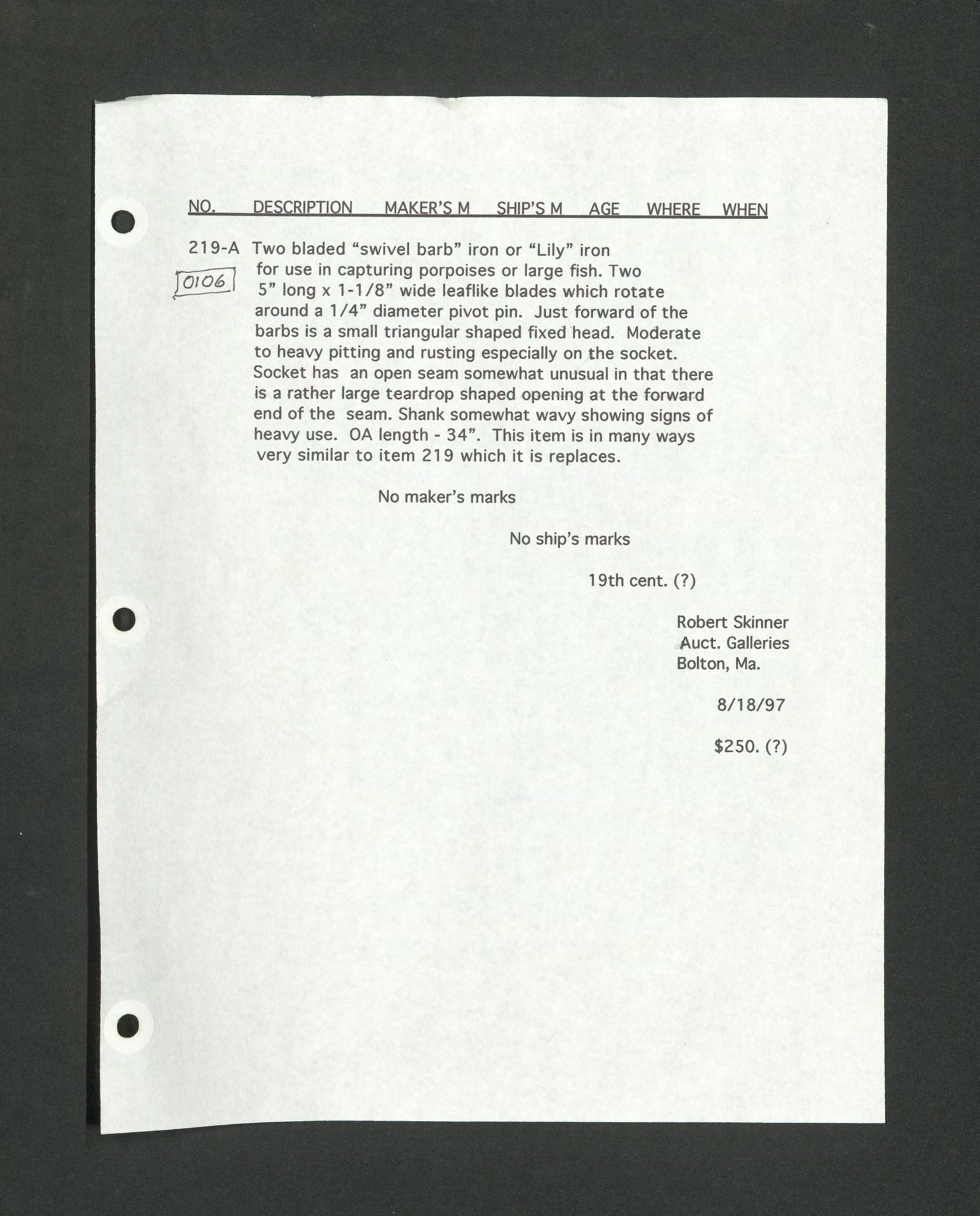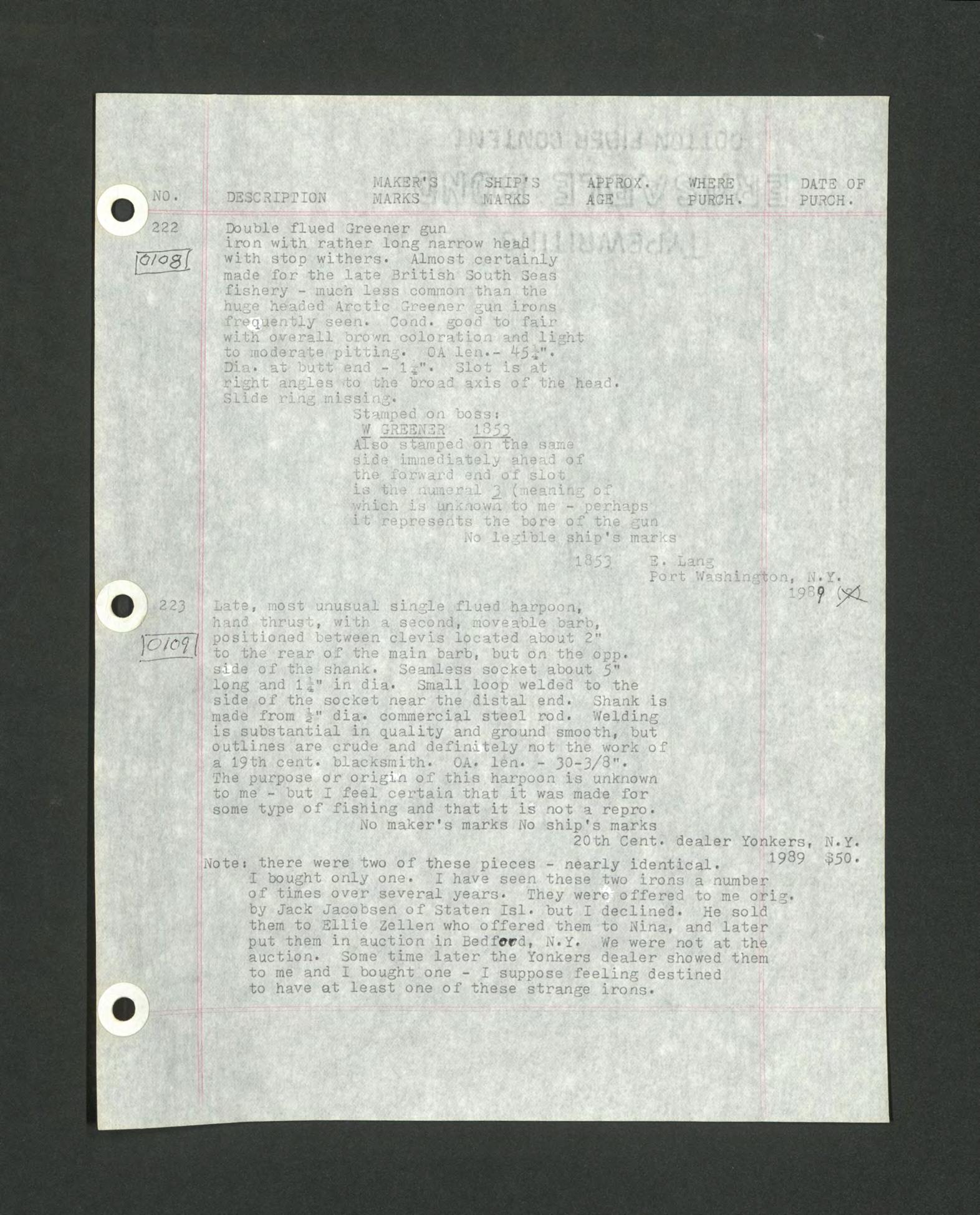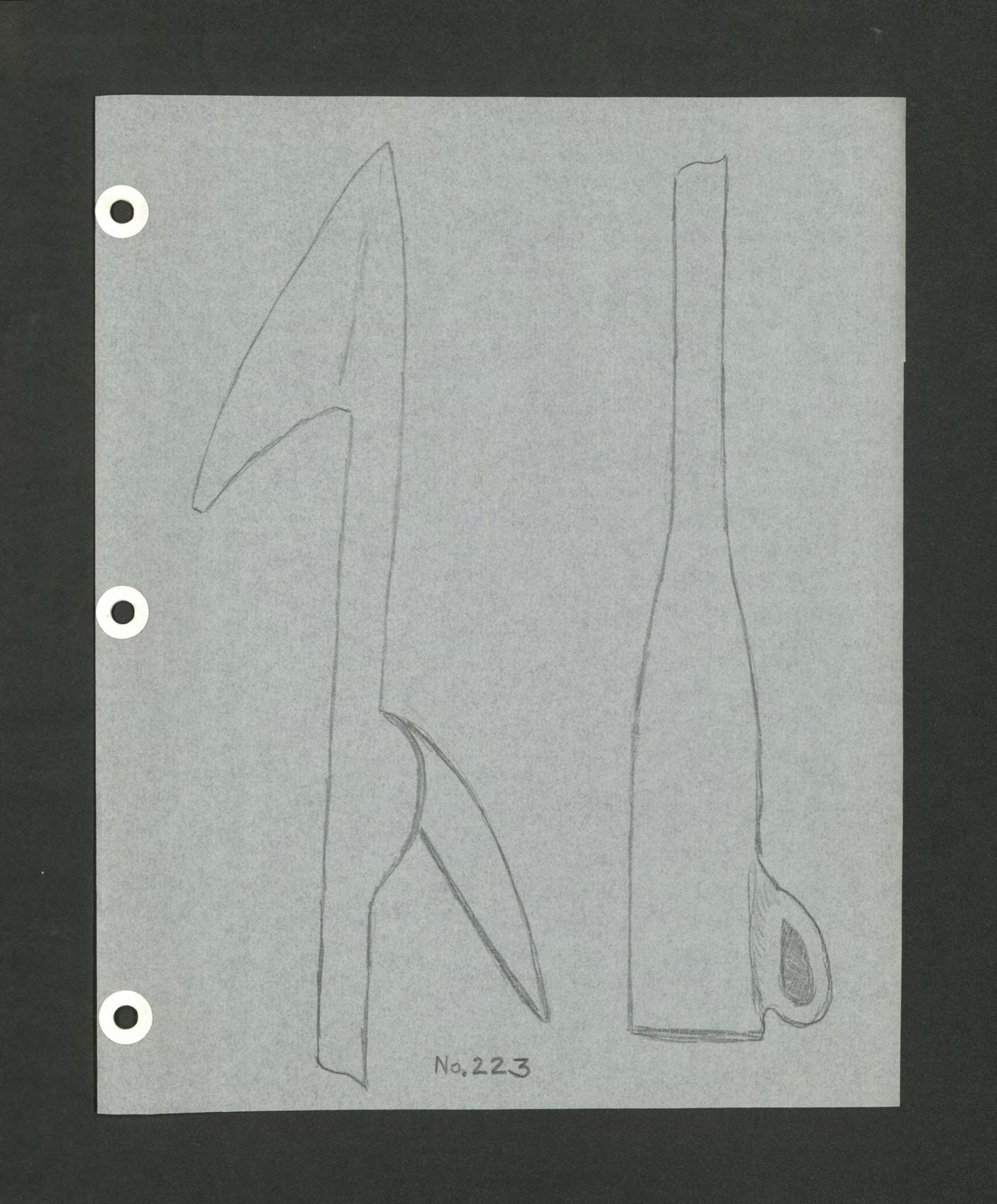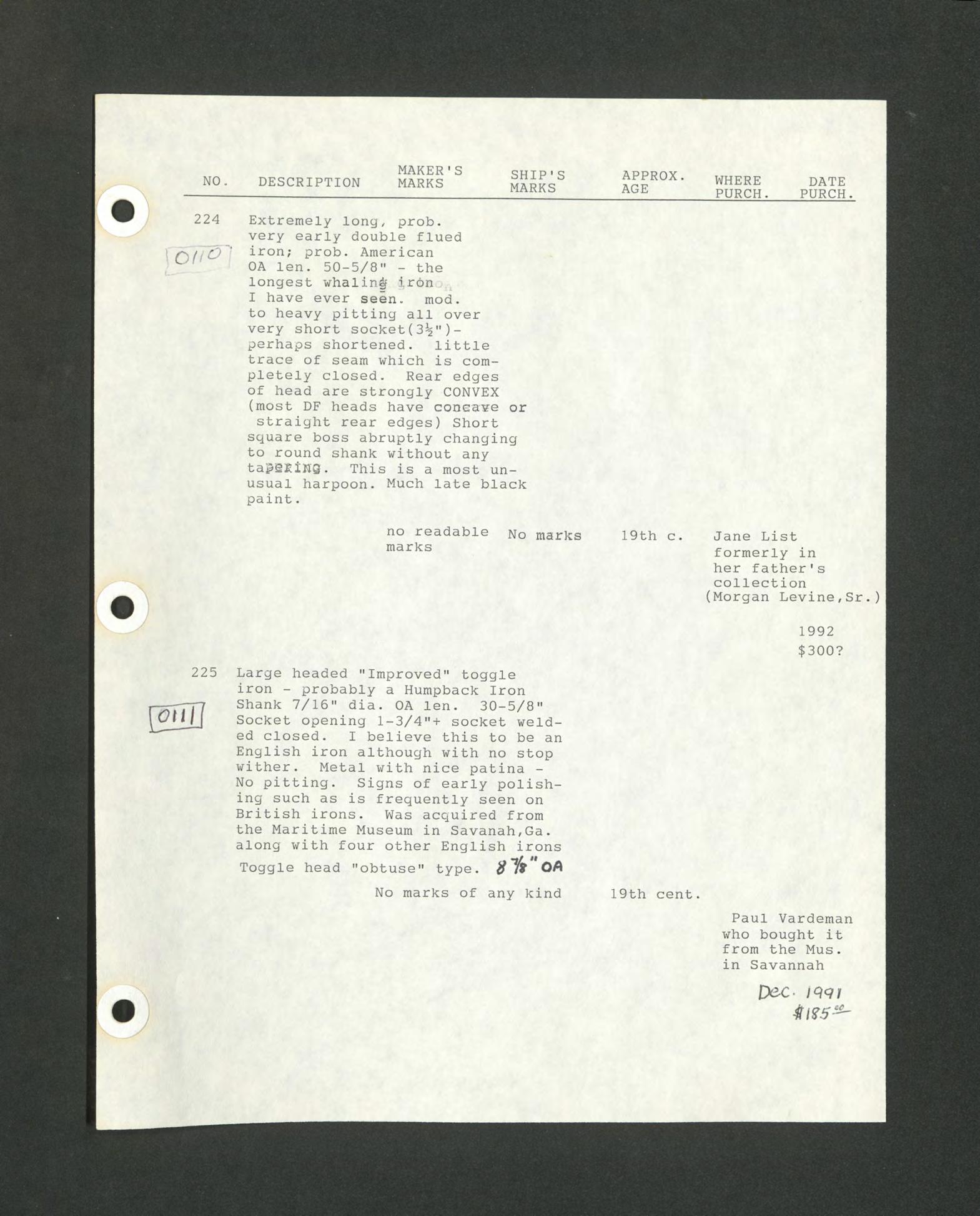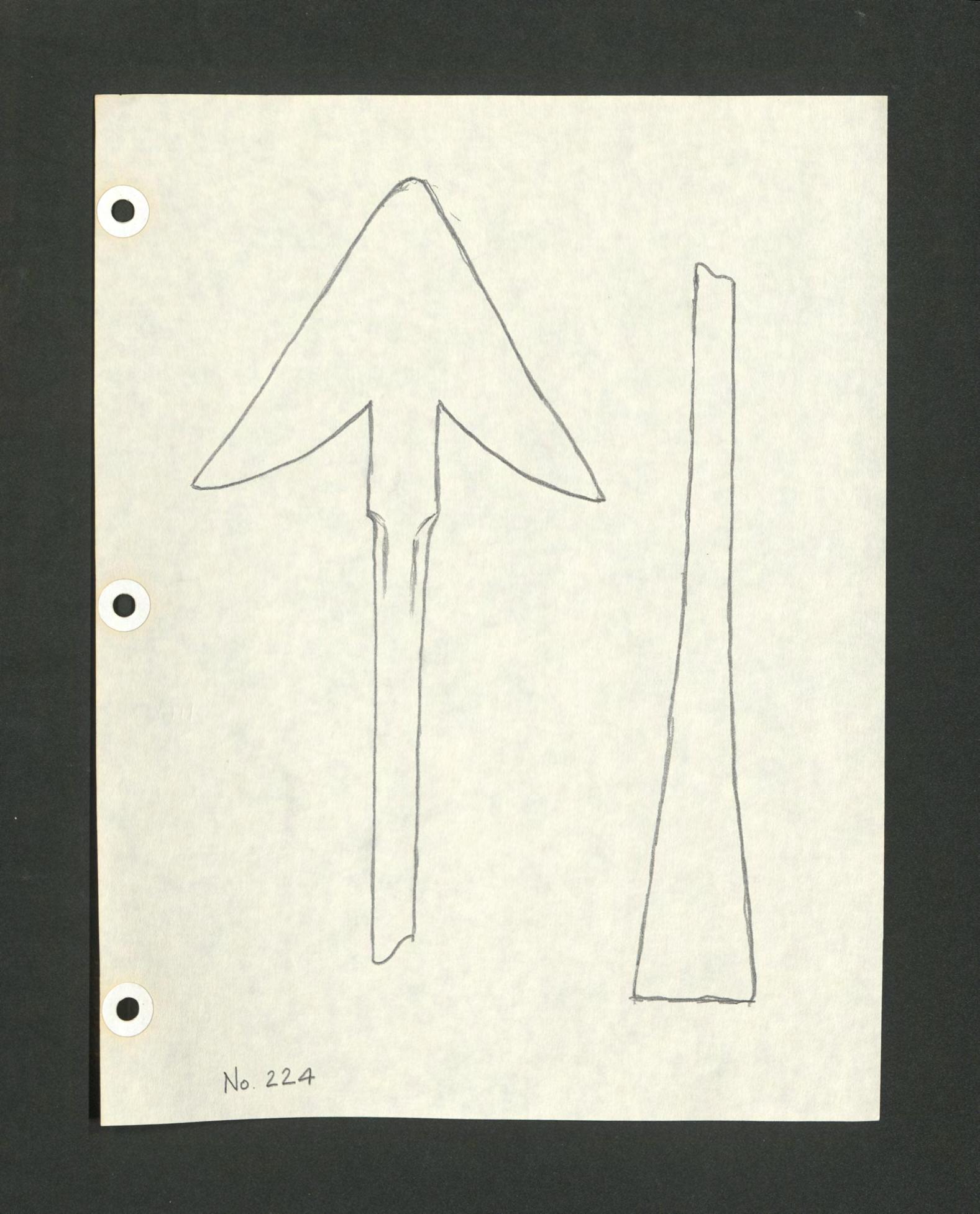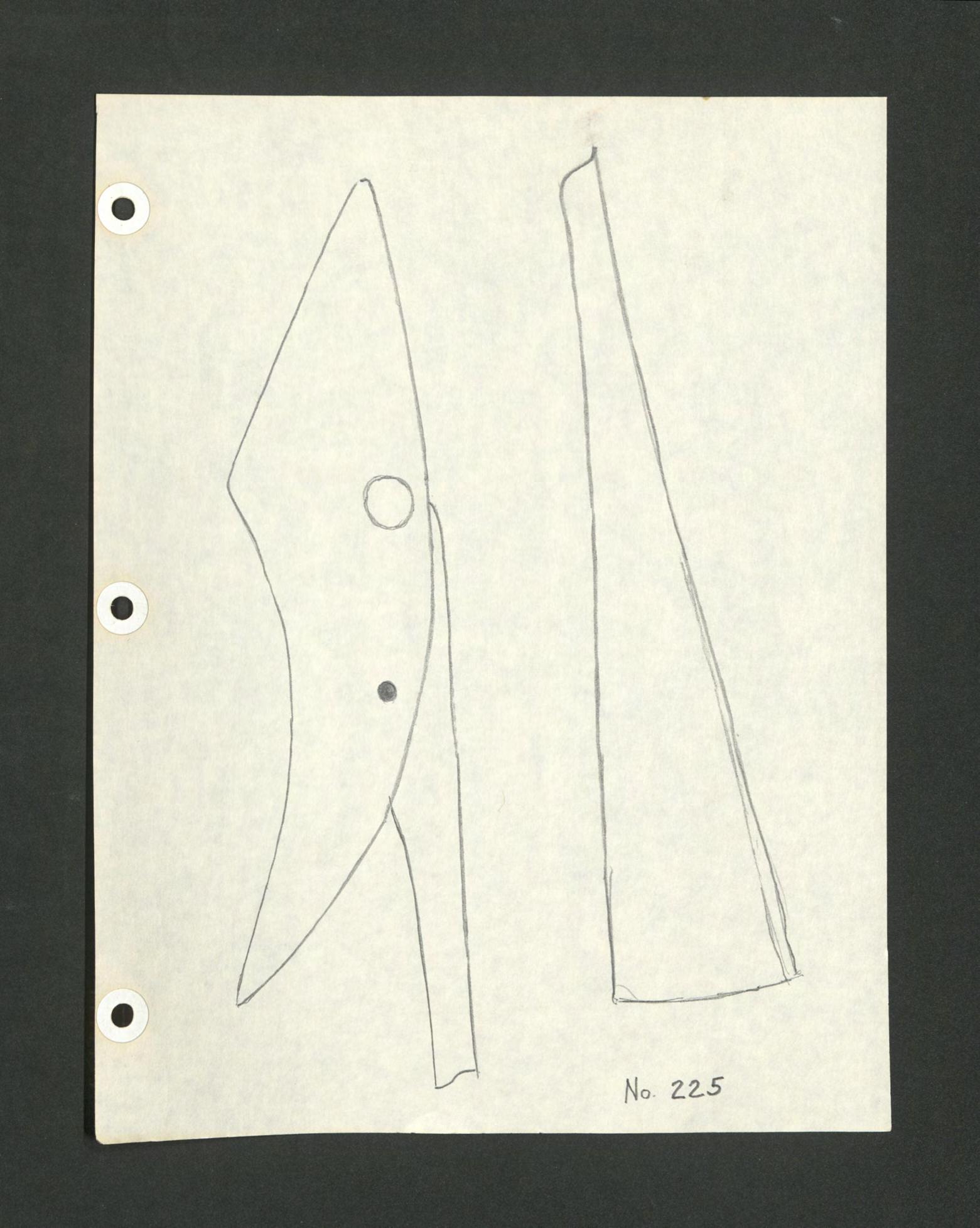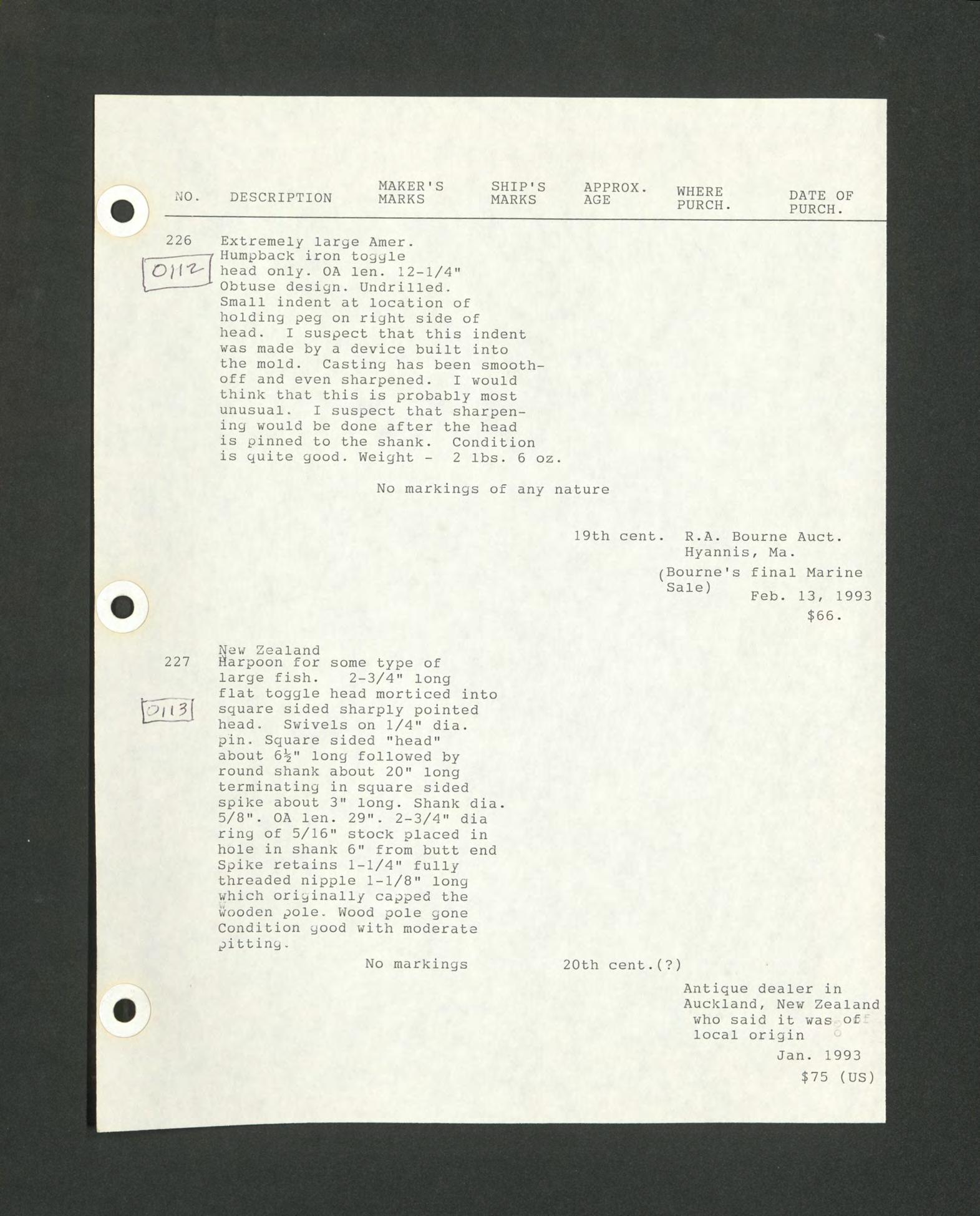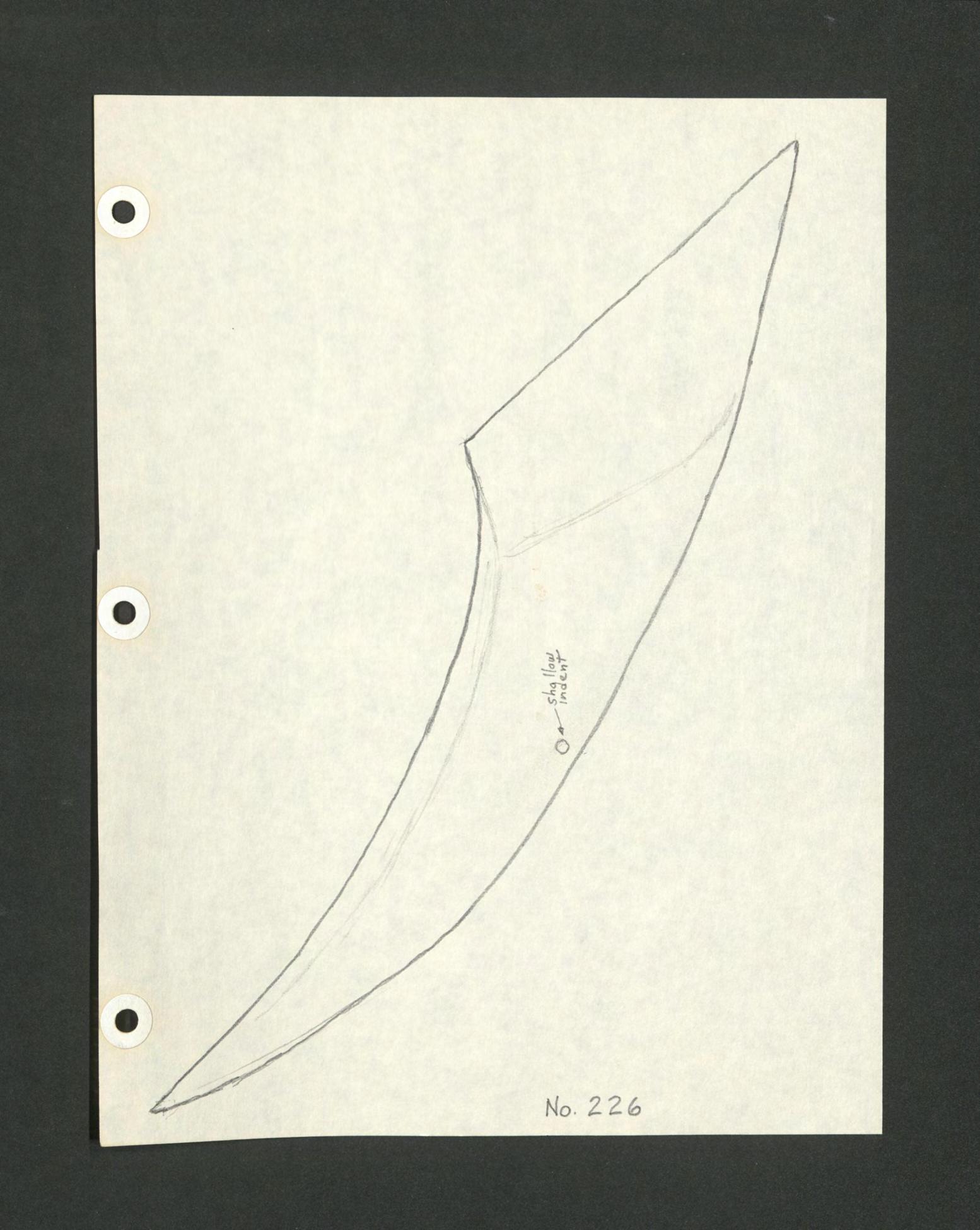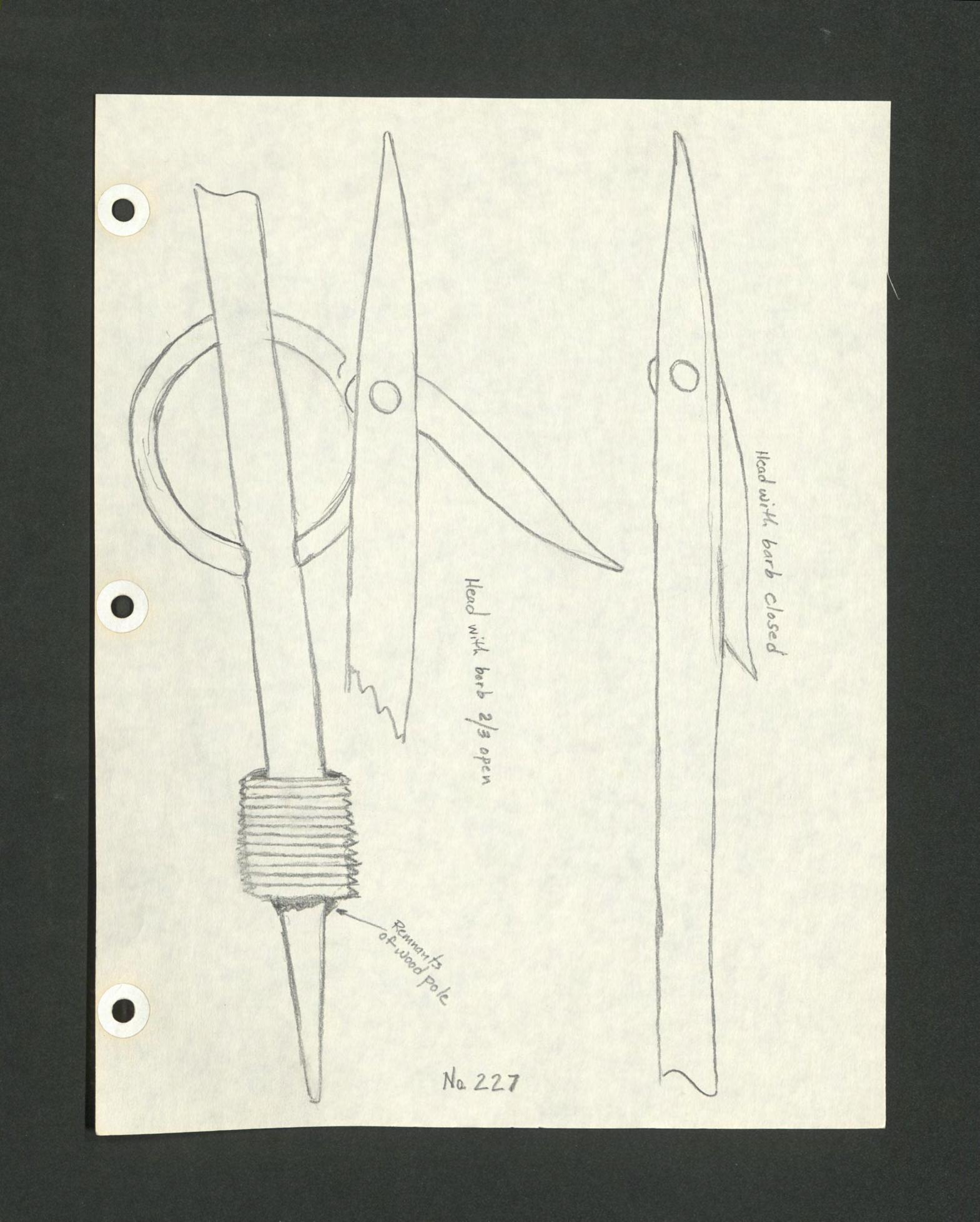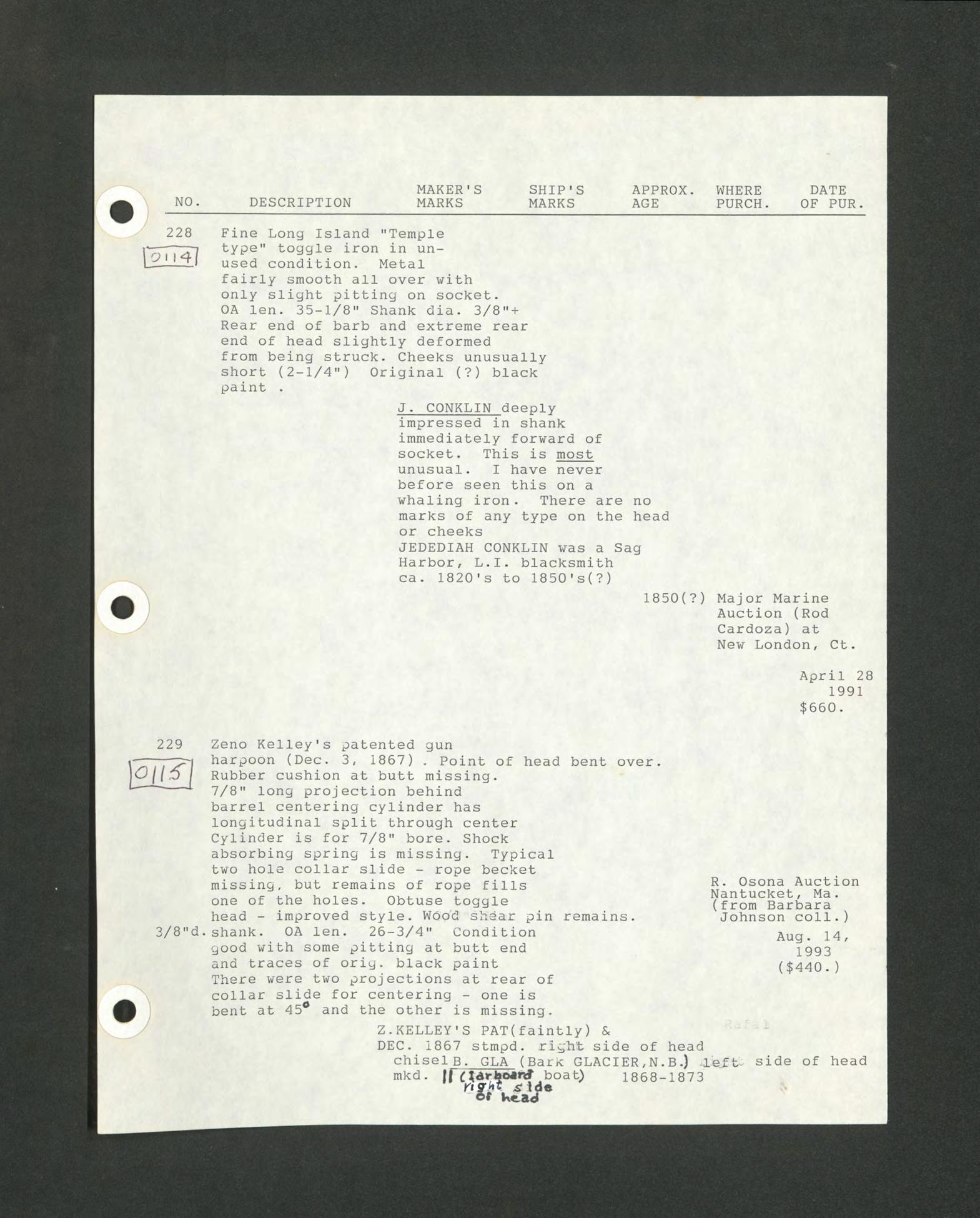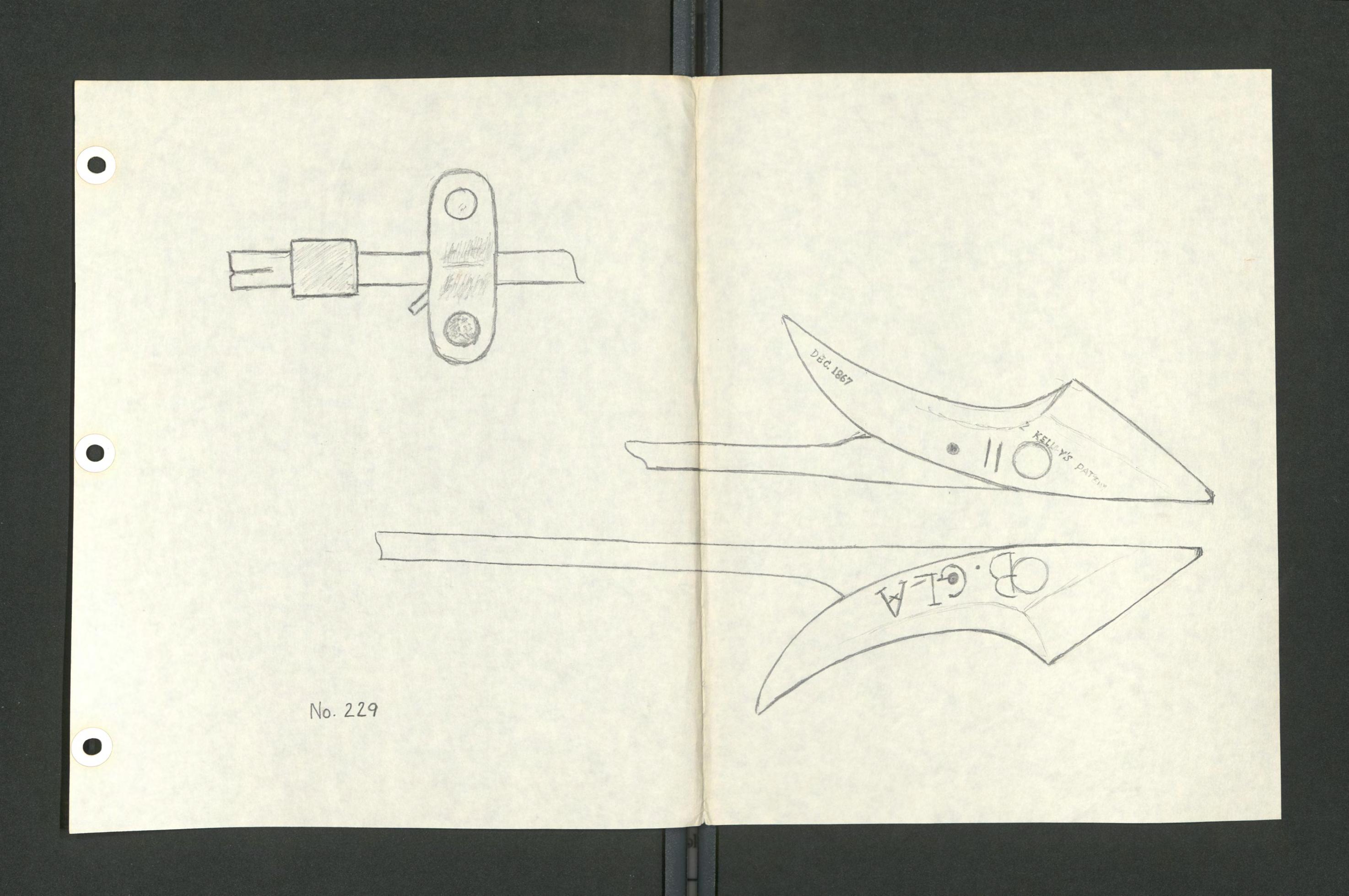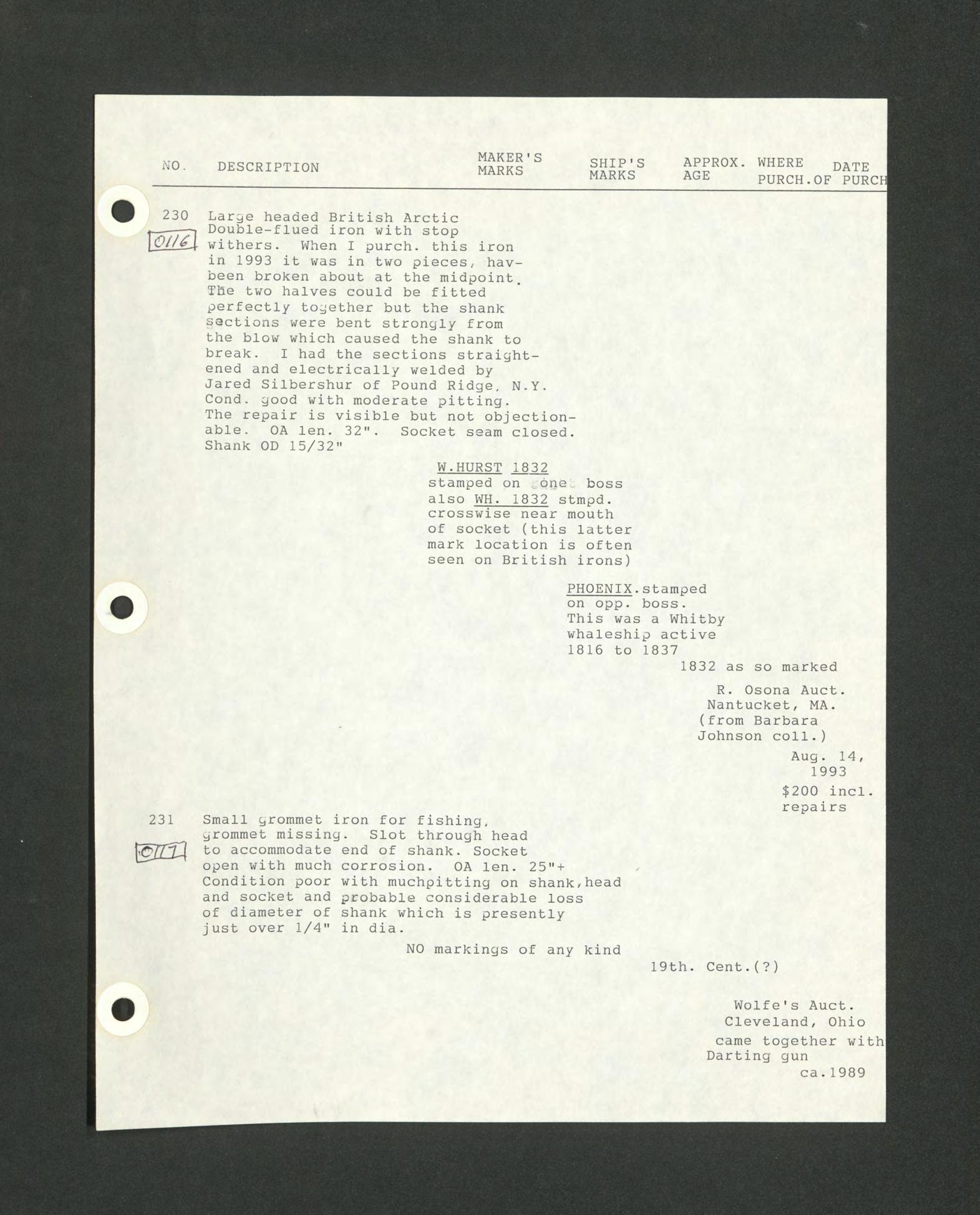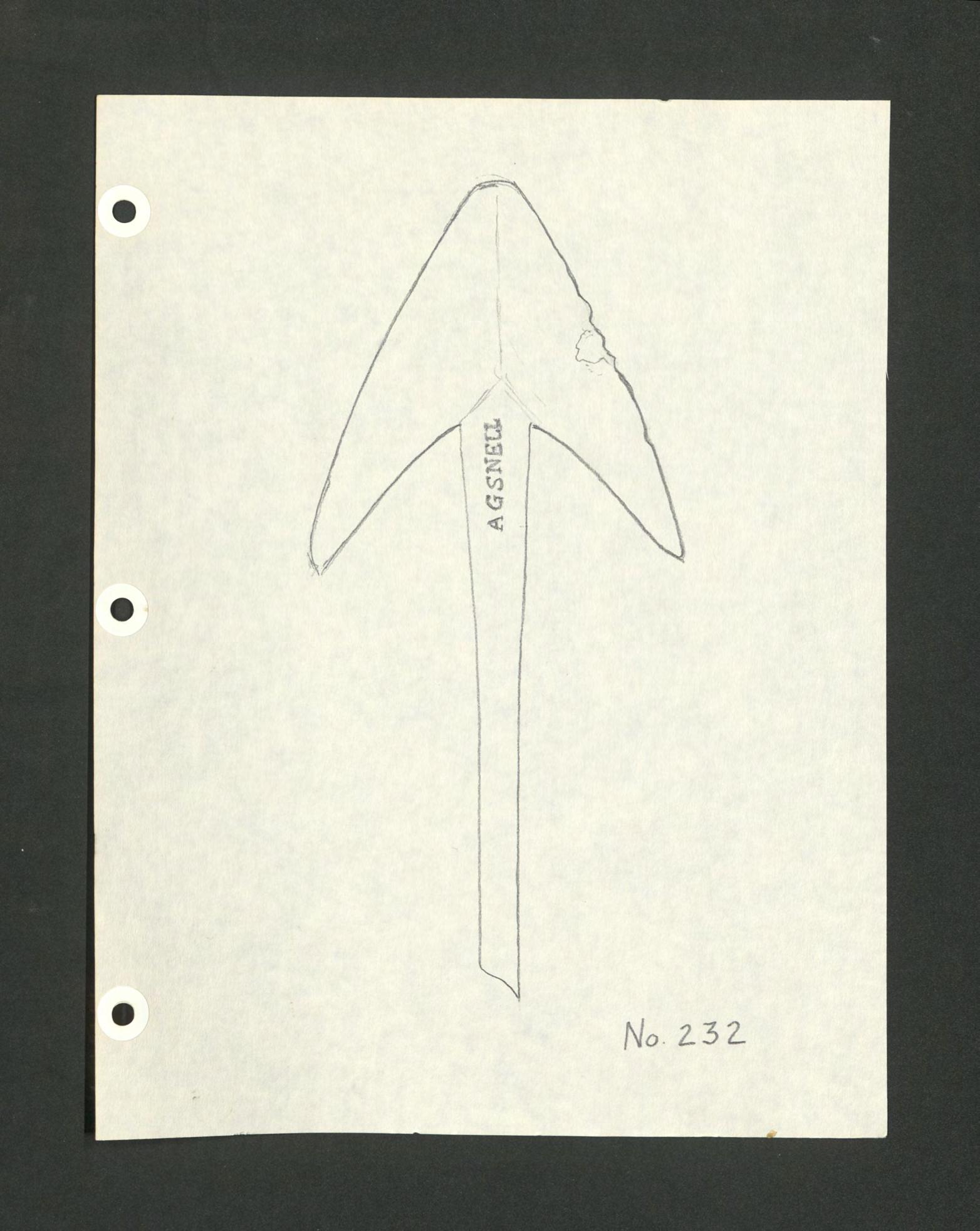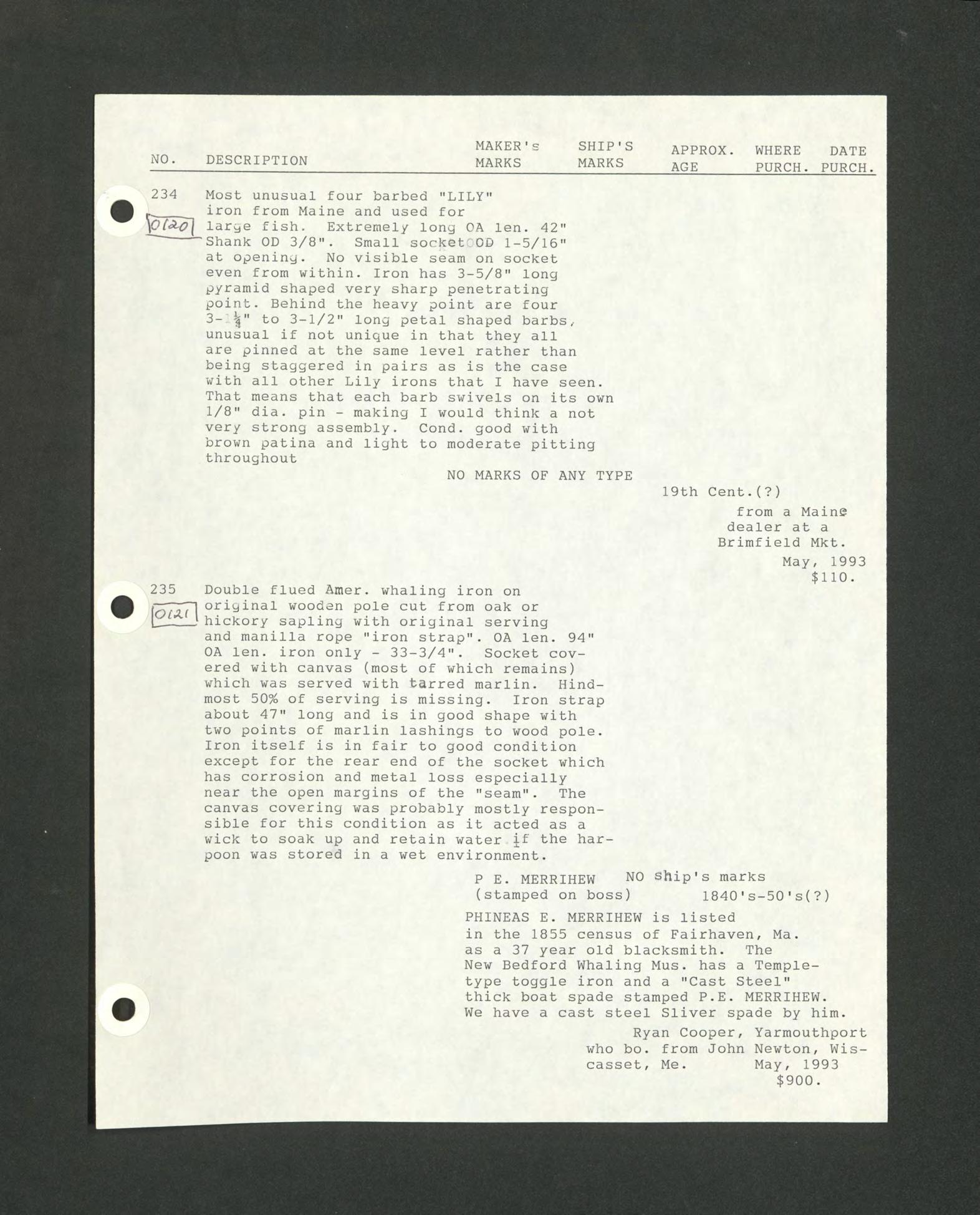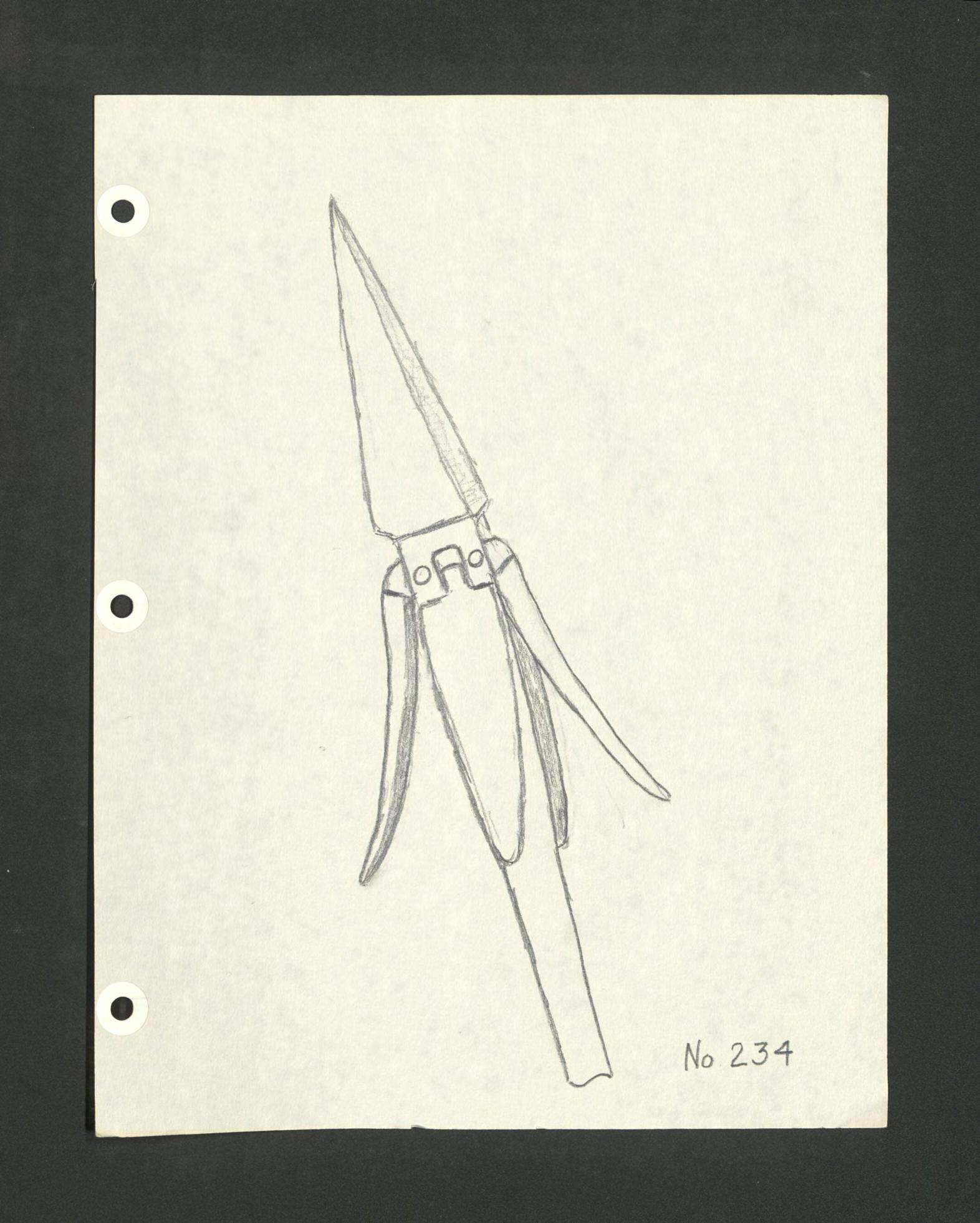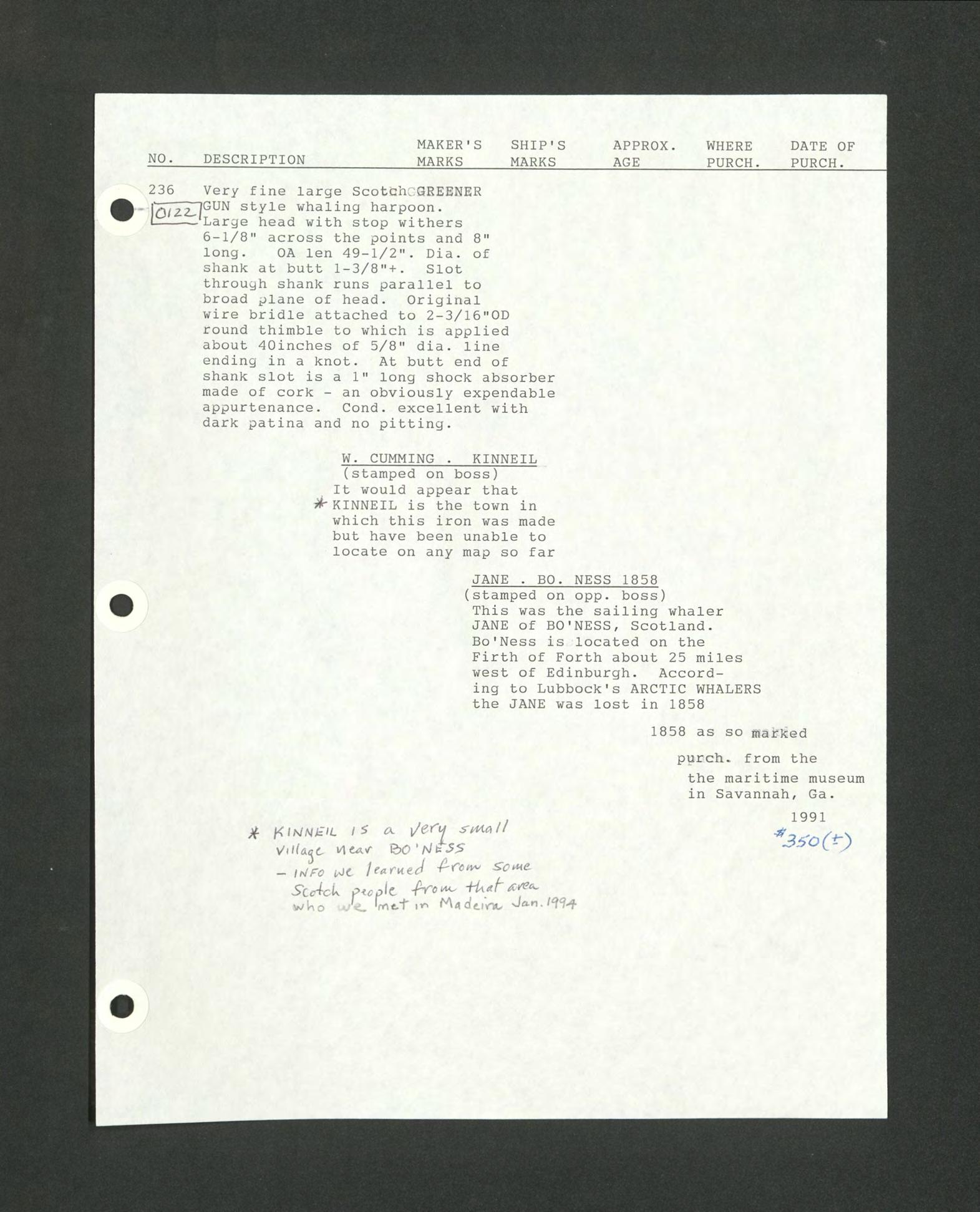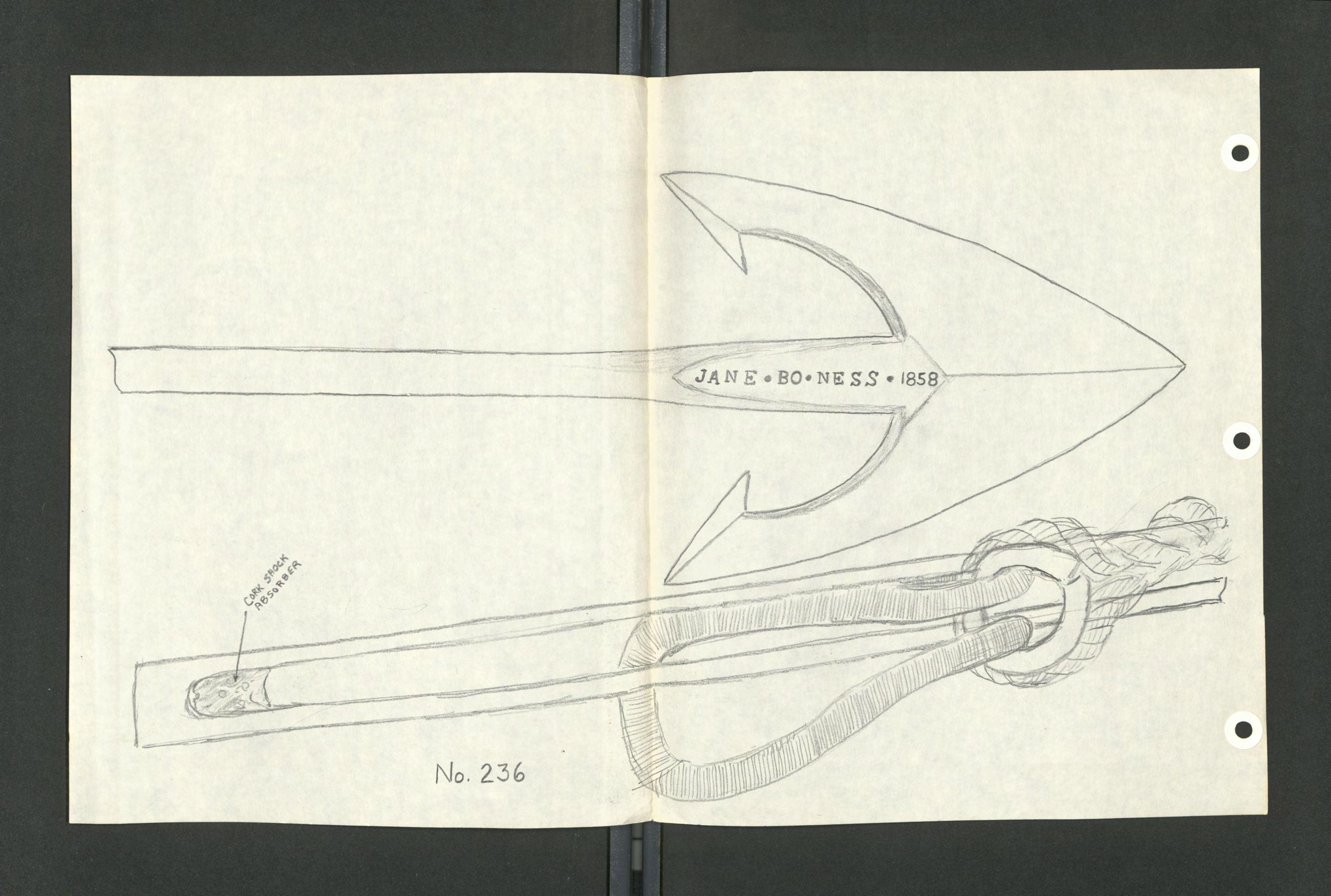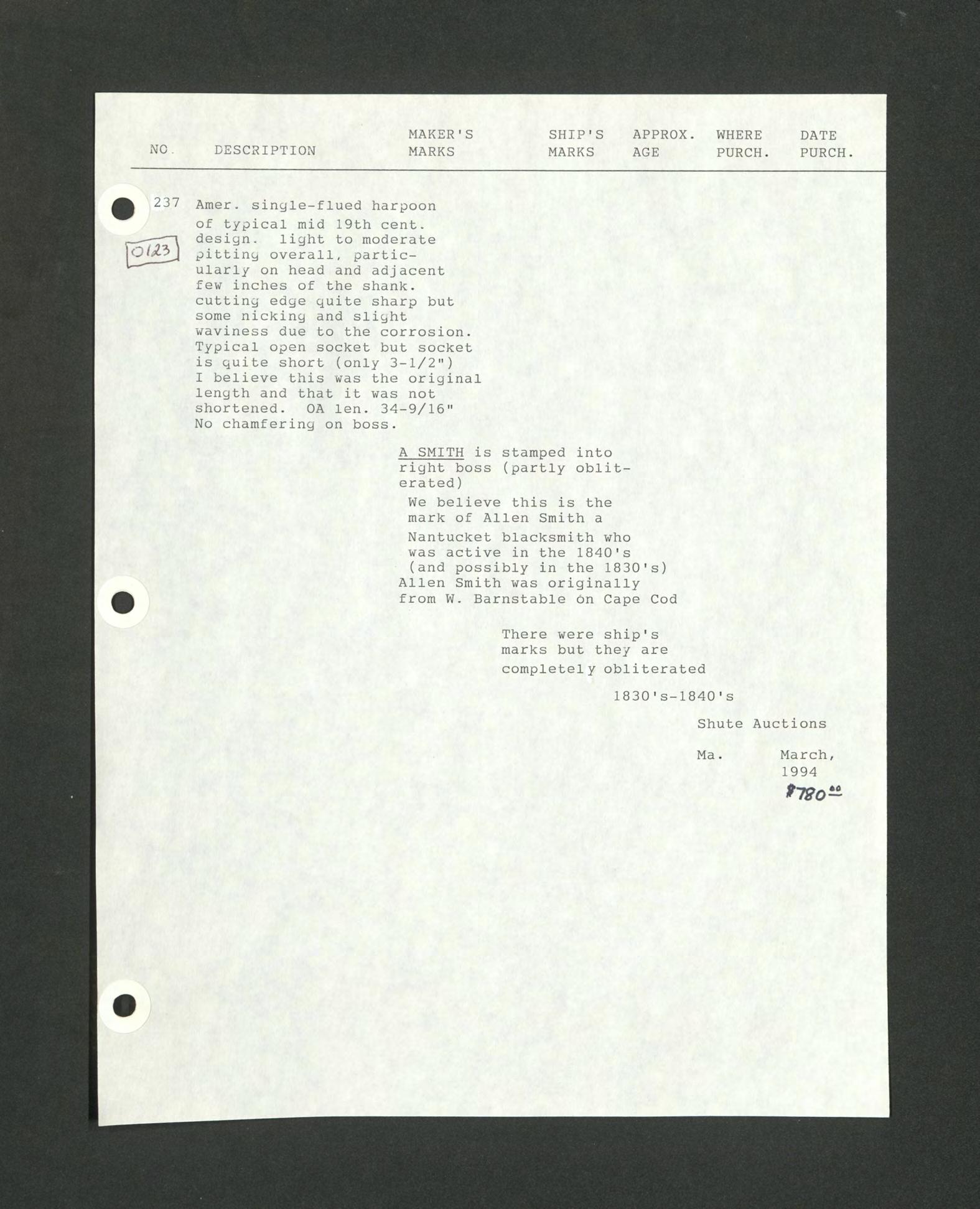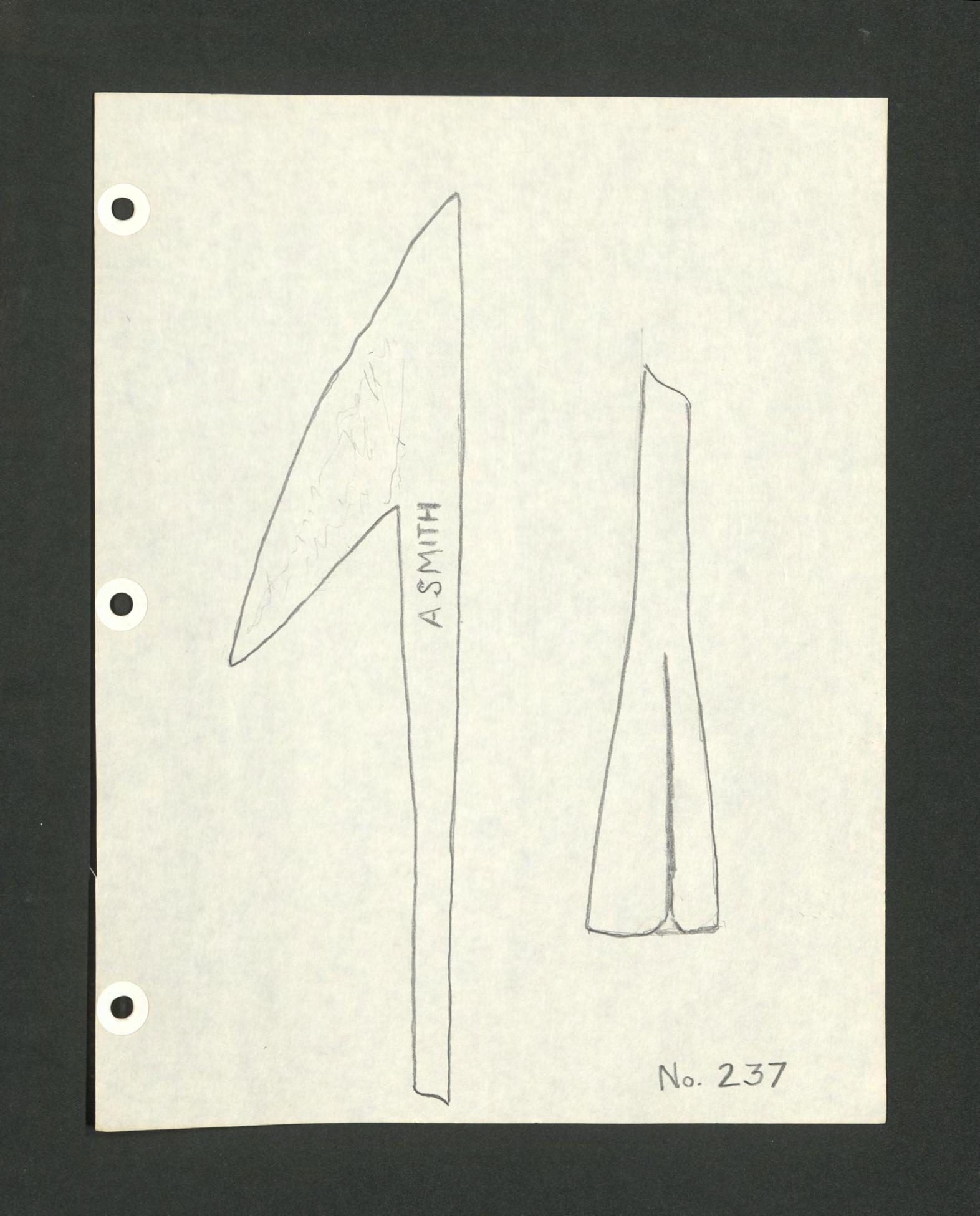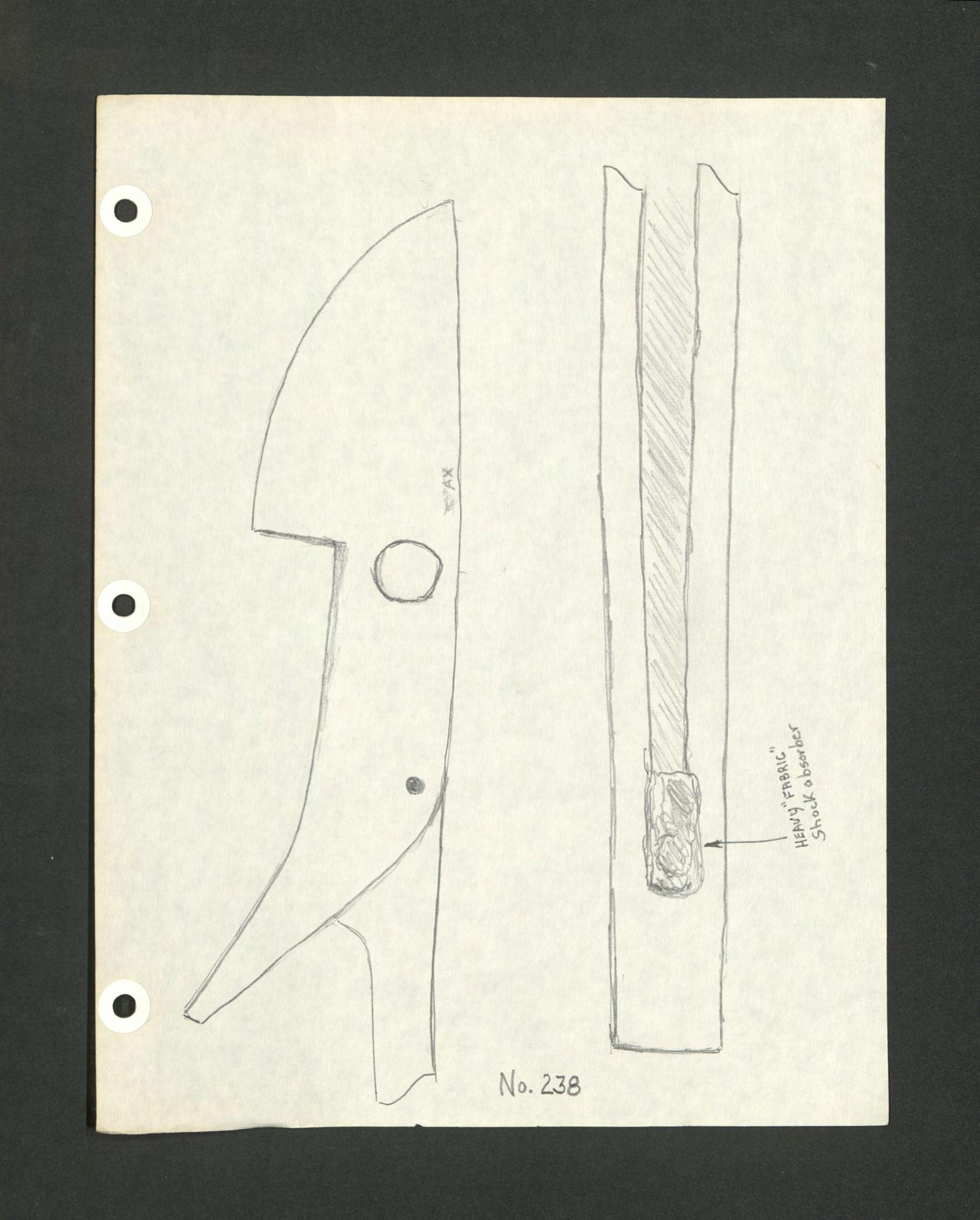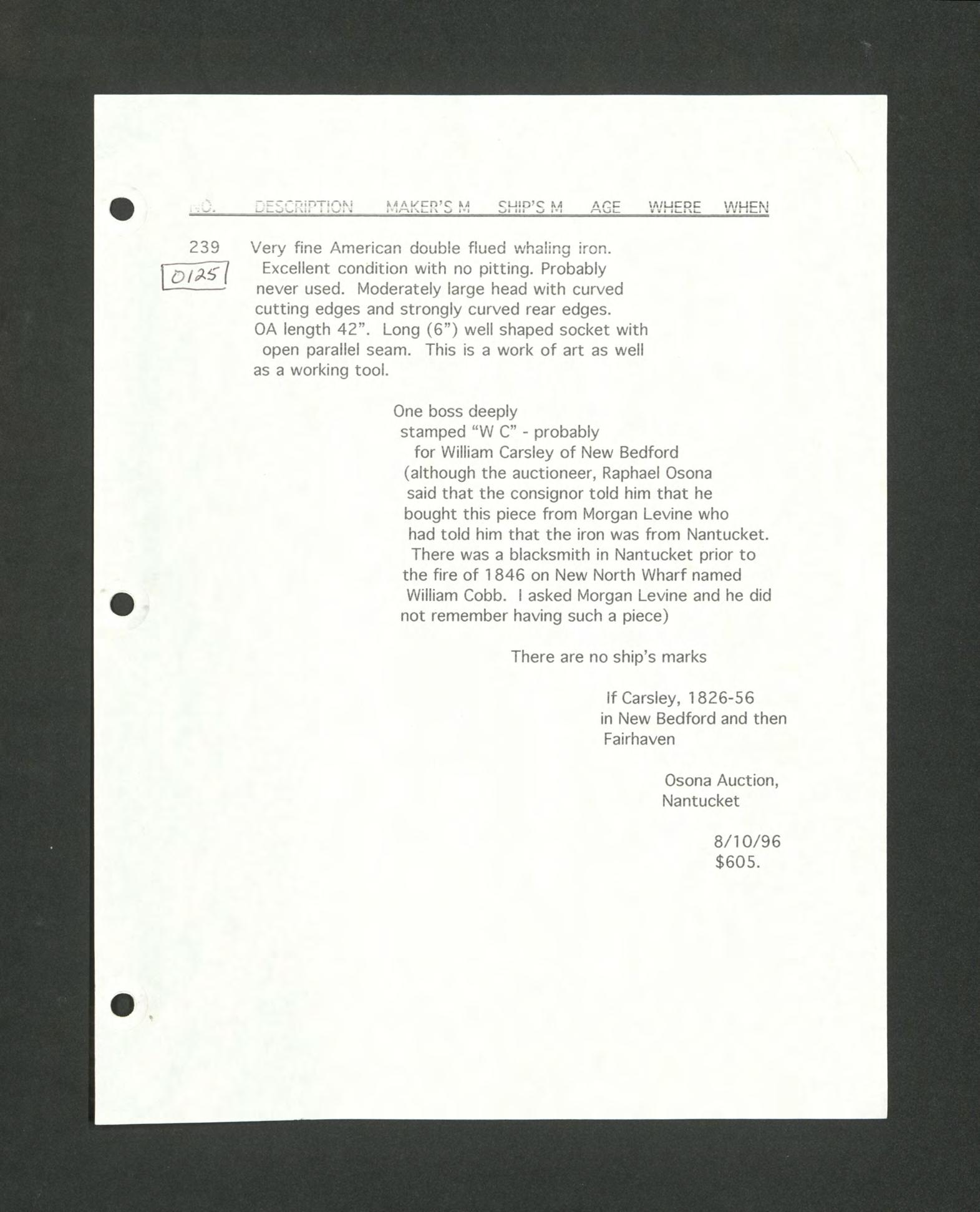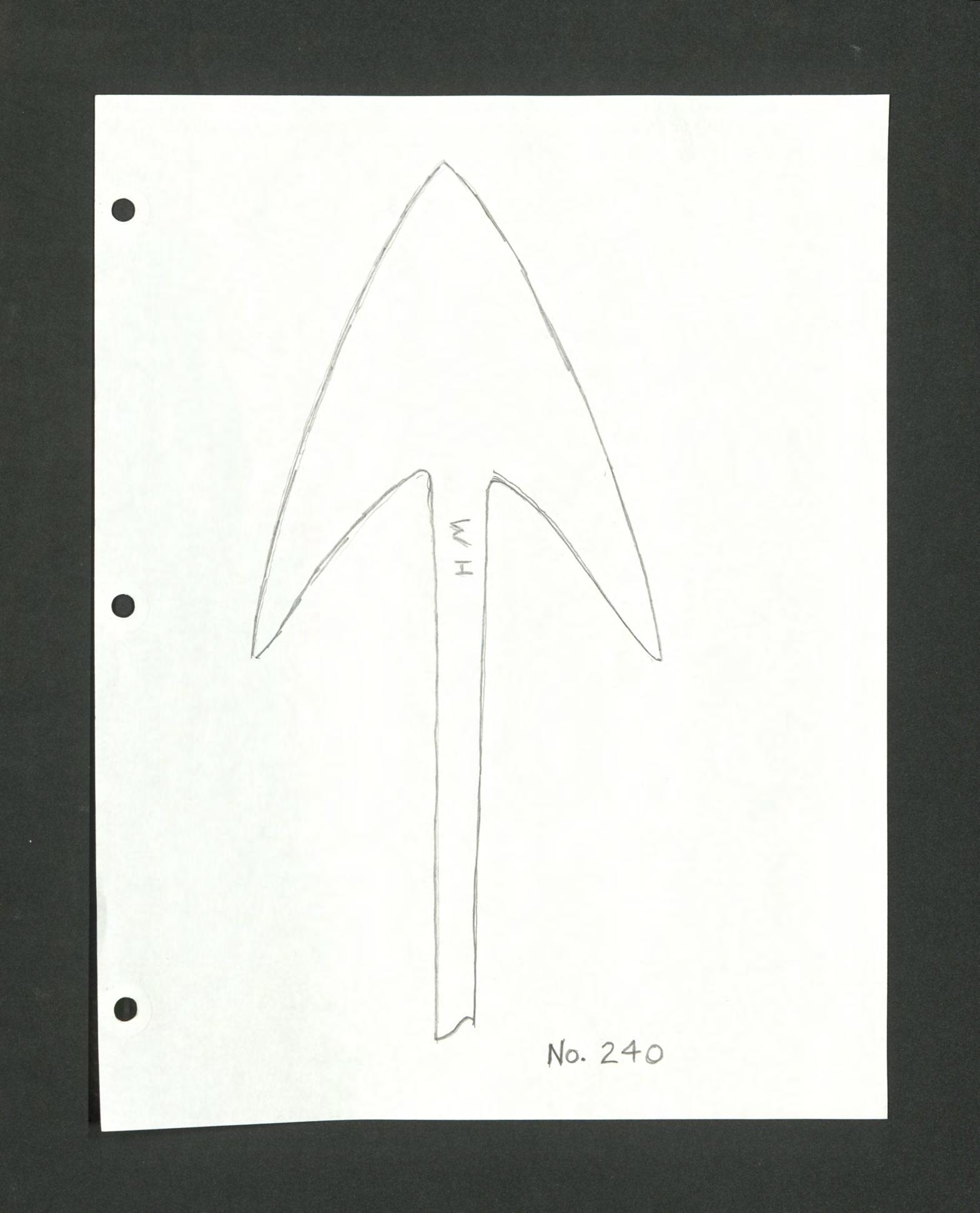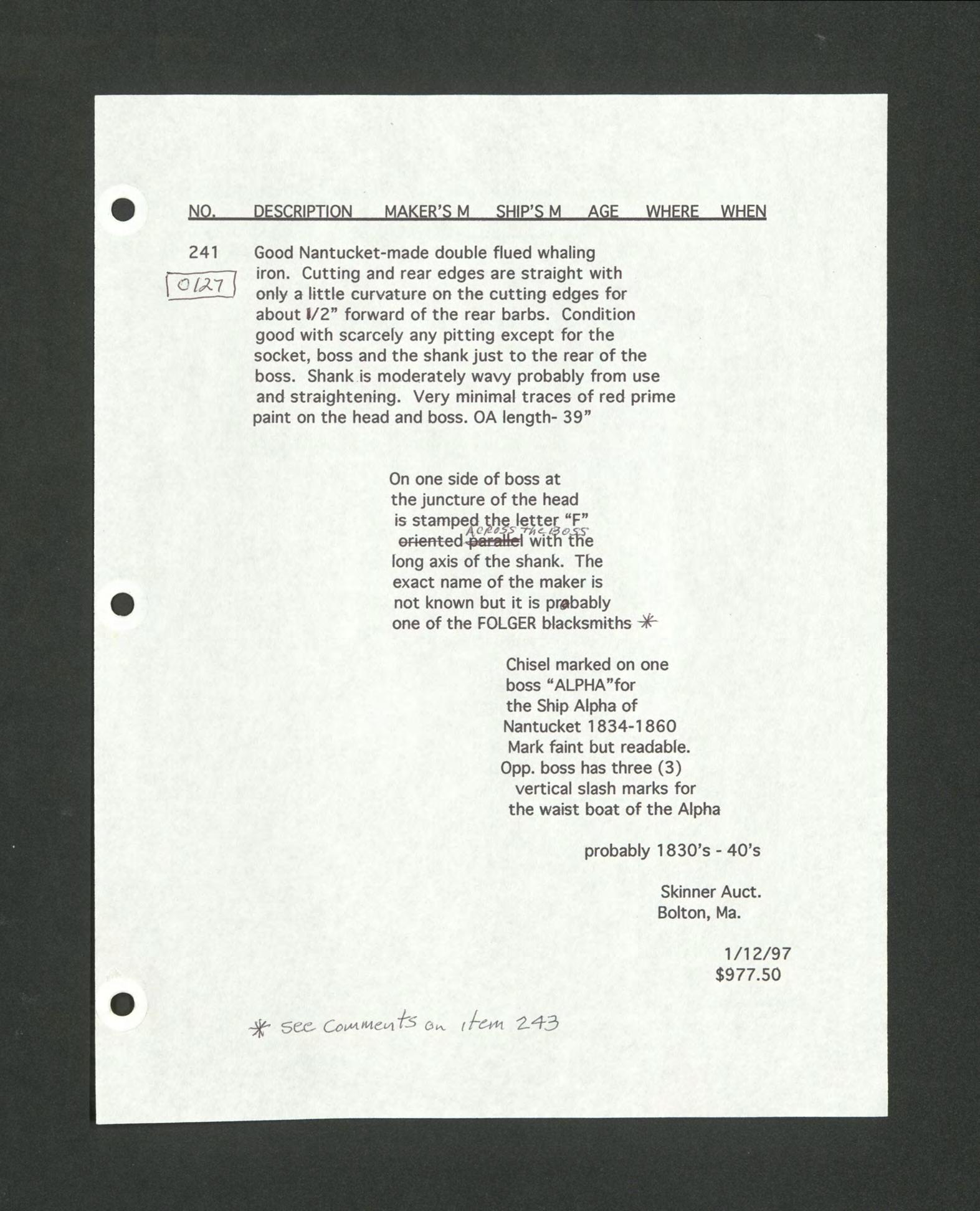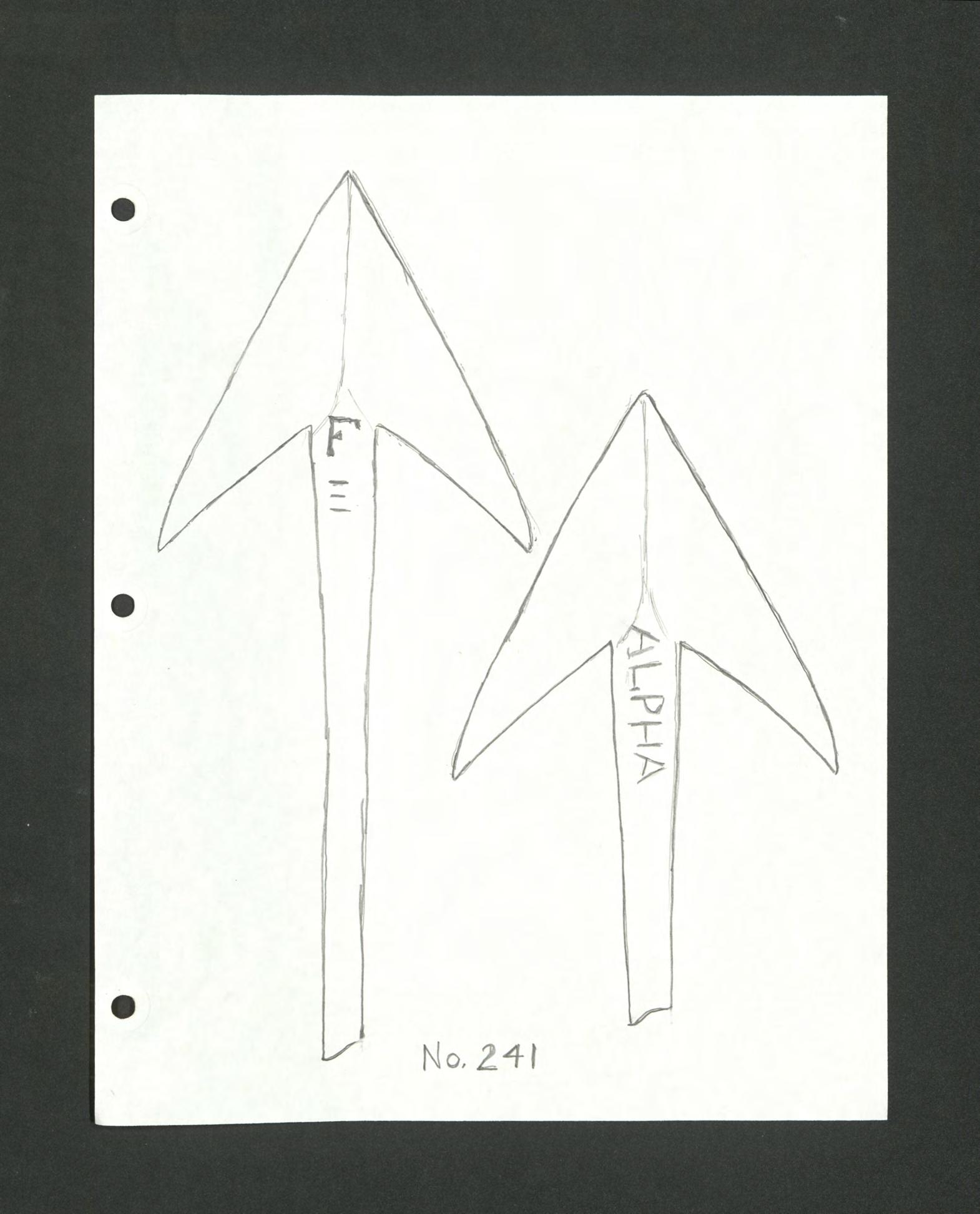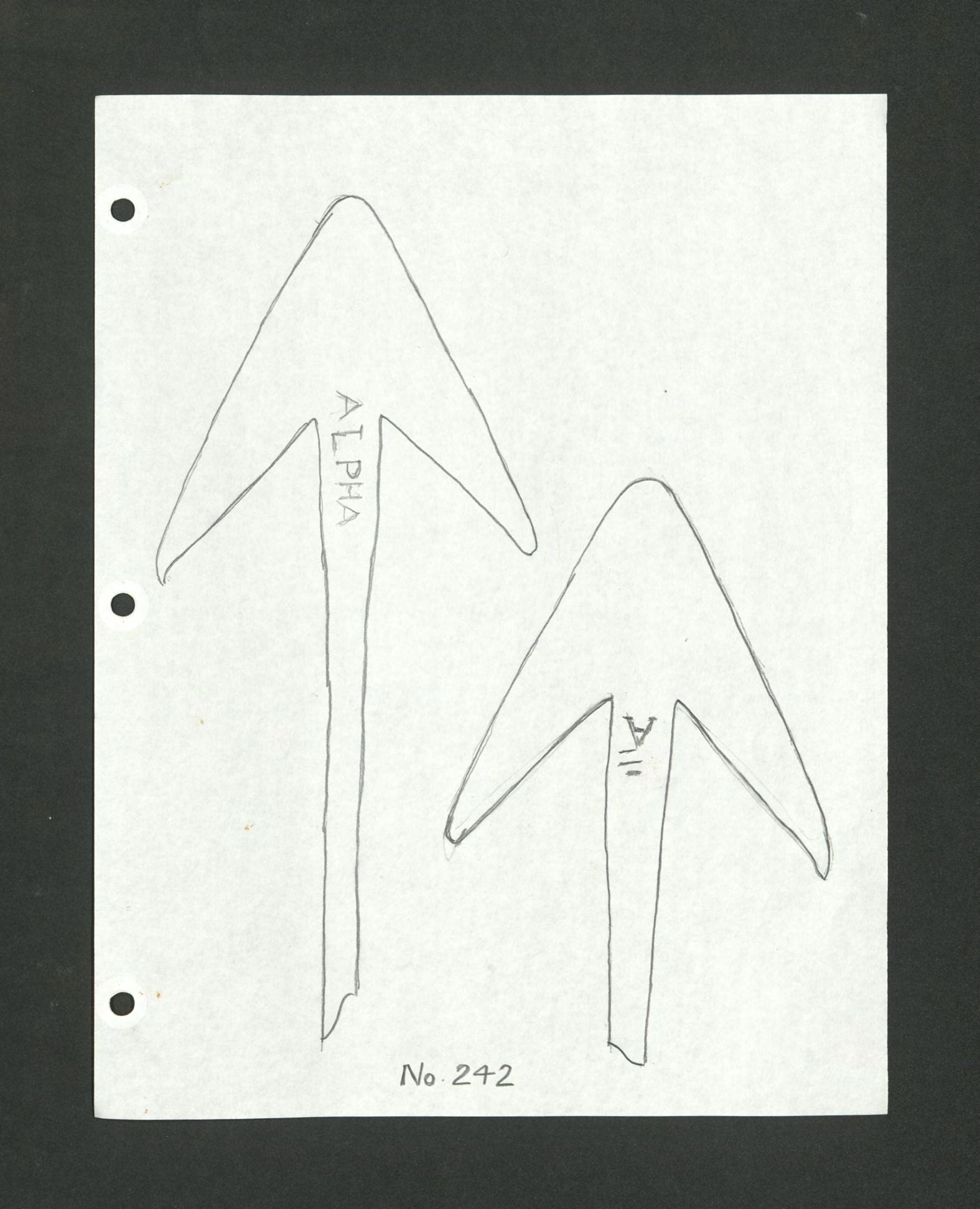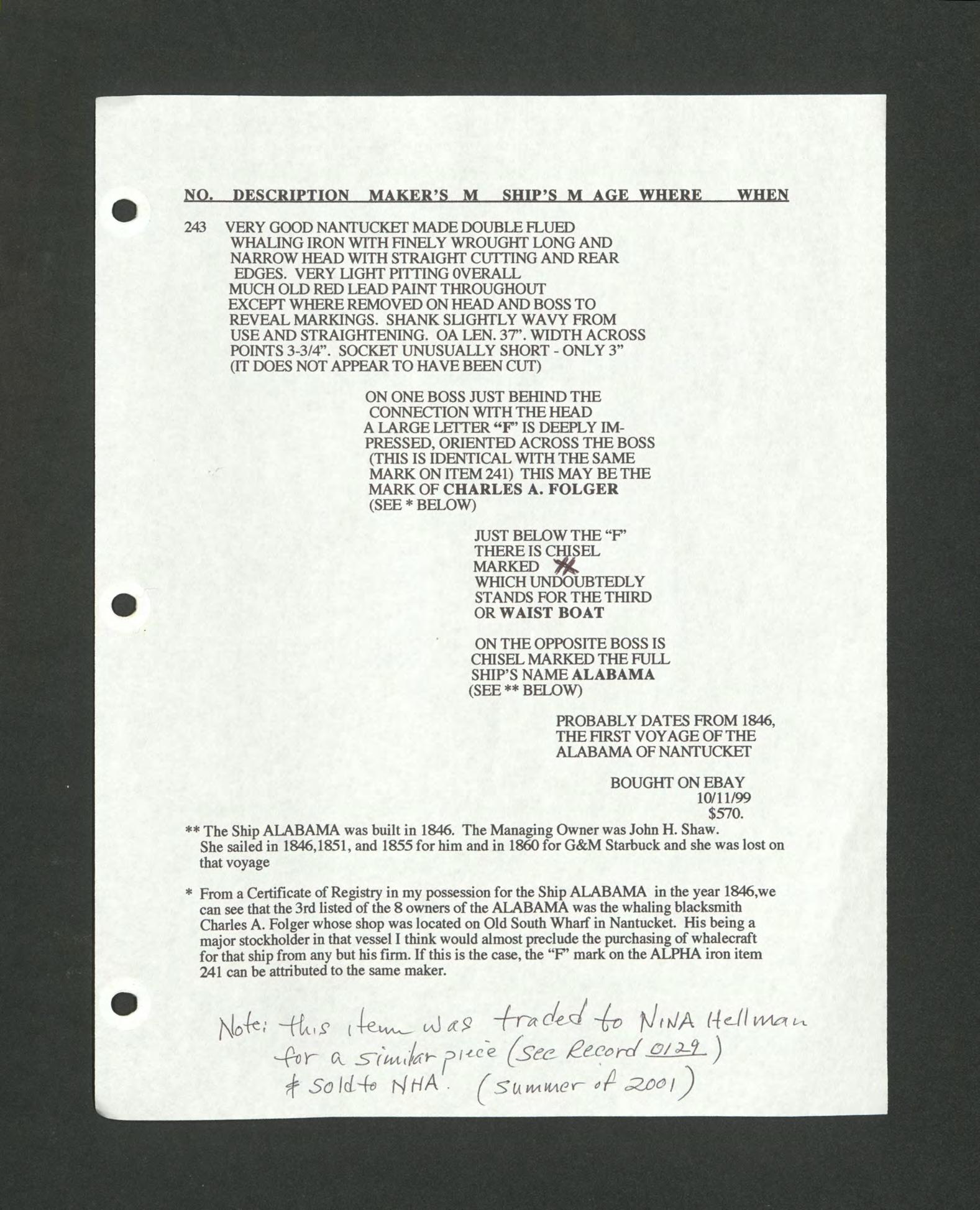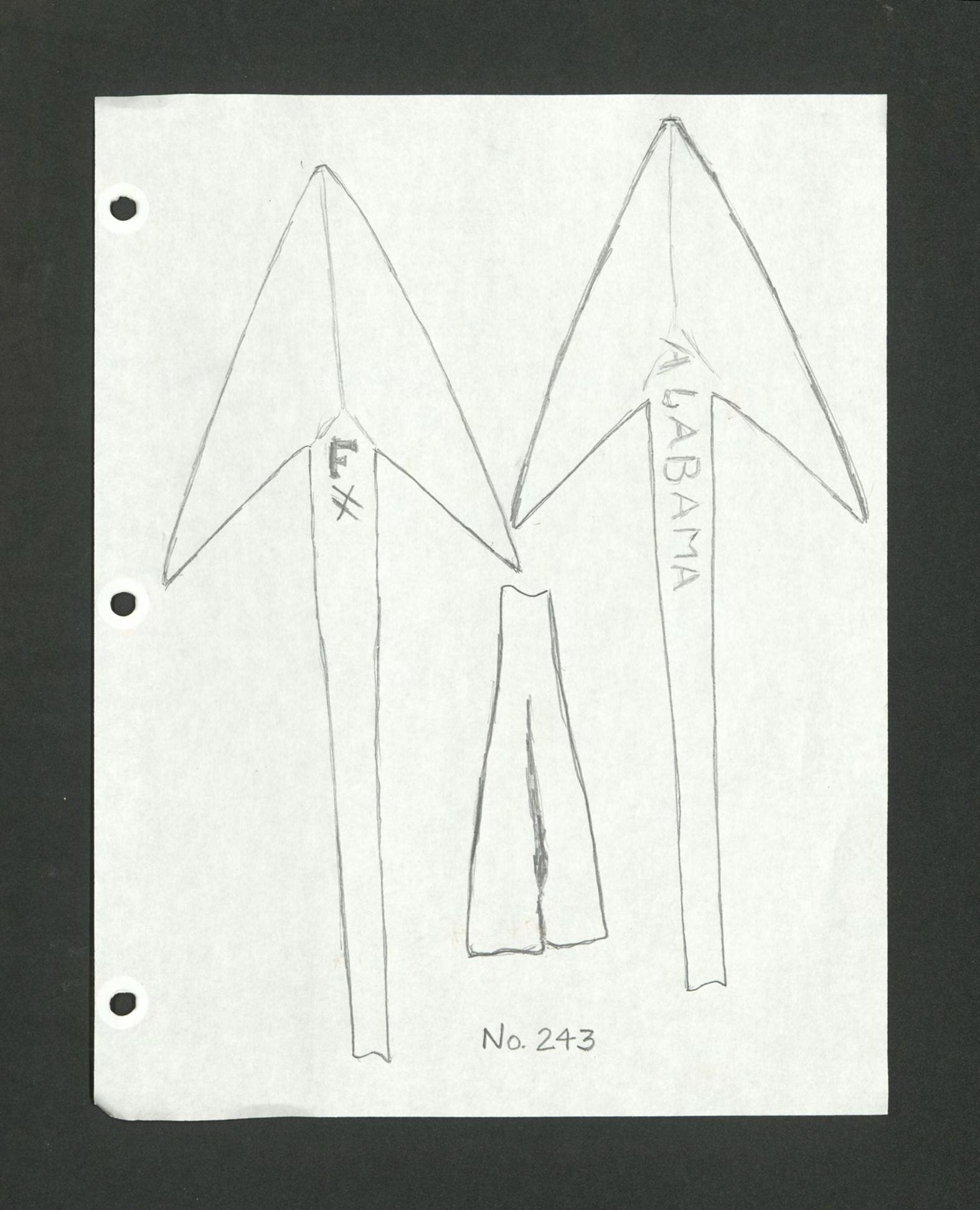Mo.174
MAKER'S SHIP'S APPROX. WHERE DATE OF DESCRIPTION MARKS MARKS AGE PURCH. PURCH.
Patented gun Harpoon by Robert Brown, New London, Conn., 2nd Model (patented Aug. 20, 1850)- see item 132. which might be described as the more advanced 3rd model. This iron has two moveable barbs, identical in form to the patent example of the Charles Randall handthrust harpoon. In advance of the barbed head is a very large lance-like blade. Flat shank to permit rope to enter gun barrel, ends in round button 1-5/16" OD.
(S8St1!^"o&°i?eS!f?)- Shank is
Cond. is very fine, clean to bare metal, with no pitting. OA len. - 37i"
No Maker's or ship's marks or traces
4)
Found in attic of Town Docks Museum, Kingston-on- Hull, England, and acquired from them in trade for Single Flued Harpoon No. Ill
DESCRIPTION MAKER*S SHIP'S APPROX. MARKS MARKS AGE
Modern style toggle iron, strongly deformed from conflict with a whale. Head and forward section of shank with much bright red paint over black, socket and after part of shank with much black paint. Condition good - illustrating conflict damages including a deep tearing of the metal at point where socket is welded to shank. OA len. - 30"(bent) Originally measured somewhat over 32".
T(H?)- perhaps for Thomas Hanlon,(N.B.) although this is just a wild guess
WHERE PURCH.
DATE OF PURCH.
center punched marks on head appear to readi V.K. - as yet unmeaningful to us on opp. side?
L,B, = Larboard Boat late 19th or early 20th Cent. Tom Prindall Auction (ex Lexi Krause coll.)
Oct., 1979
Patented swordfish harpoon, with spring loaded flukes.
Pat. NO. 1,3^.693 dated June 29, 1920 by Frank Gilbert Hinsdale. Made of brass. Removeable shank missing.
Tip of right fluke broken off. This is an interesting harpoon oddity since it represents what is probably the last patented harpoon (albeit, not whaling), and the inventor is the most famous collector of whaling harpoons. The Hinsdale Collection at the New Bedford Whaling Museum being the most comprehensive assemblage of whaling irons known, and includes most of the extant patented irons.
H.O. HILLMAN
PATENT APPLIED FOR1 1919-1920
NO.
177
DESCRIPTION
MAKER'S MARKS SHIP'S MARKS
Amer. Single-flued iron for Greener-type bow gun. Head rather small. Very heavy, square shank behind head. Oval sliding ring with rope "thimble". Typical split shank, but slot is at right angles to cutting edge of head (most Greener gun irons are slotted in the opposite directionat least most European irons are that way). Shank with plain end and butt dia. 1-3/16"...
OA len.- 45-3/8". Cond. is good with some verylight pitting.
marked on shank behind head:
APPROX. AGE WHERE PURCH.
DATE OF PURCH.
J.B.(D?) - possibly for James Barton, New Bedford*
None apparent mid 19th cent.(?)
R.A. Bourne
Auction June 24, 1981
*From appearance of maker's mark J.B. and design of head I am certain that this iron and single flued hand thrust harpoon, item No. 109 are the work of the same blacksmith
178 Head for modern 90 mm. Grenade Harpoon. Made of 0O&C cas,t iron, with very dark " green(?) paint over red lead primer. OA len.- 16-3/8"
Wt. - 22 LBS. .s marics
made by SPRING CITY FOUNDRY. Spring City, Pa. *
No ship's marks
* During World War II, after Germany invaded Norway, the Norwegian whaling fleet was still able to function, since it was at sea during the invasion. The Norwegian Gov't, in Exile, located in London enlisted the aid of America in finding suppliers for harpoons, etc. Spring City Foundry made many grenadeheads and had local machine shops make the shaft and toggle sections. This head was given to us as a gift in the 1970's.
1940*s gift of Sam Marcus, Spring City Foundry mid 1970's
No. 179 Siptblo.z
|SS/O/T/Vo./
MAKER'S SHIP'S APPROX. WHERE DATE OF NO. DESCRIPTION MARKS MARKS AGE PURCH. PURCH.
179 Scotch Double-flued
6£>6rf Greener gun iron, with two massive moveable barbs with stop-withers. Extremely long - OA 50f". shank dia. 1-5". Shank slotted at right angles to broad plane of head, Sliding wire loop roughly in form of figure-eight. Round thimble for whale line attached to smaller loop of fhe 8. Butt end of slot packed with soft metal, probably lead, which I believe is to act as a shock absorber. One fluke is keyed to main part of head by means of two center punched dots (two on fluke& two on head). Condition; good to excellant. Wt. 12 lbs.
Marked on shank behind head side Nol t G.F. PHD. •' (according to A. Credland of Hull Museum, this was a blacksmith in Peterhead) Side No. 2: ECLIPSE. 1881 (Eclipse was an aux. steam whaler of Peterhead, Scotland, and later of Dundee, Scotland)
1881
180 Amer. "improved"toggle head iron. Cond; fair, with oa light pitting, some slight traces of orange primer. Extreme tip of iron broken off (about l/8"). Orig. serving on forward 1/3 of socket. Rear of shank with orig. woven and interlocking ropework and eye loop. Oa. len. - 30^"+.
marked on toggle head
MACY (E.B.&F.•Macy, N.B.)
N.Flayderman, New Milford, Conn.
Oct., 1981
S.#l- BK, 0Y.(?)' (probably Bark Ospray, New Bedford) S.#2- B.B.(Bow boat) 1861-1880
MAKER'S SHIP'S APPROX. WHERE DATE OF NO. DESCRIPTION MARKS MARKS AGE PURCH. PURCH.
181 Amer. Single-flued
.oharpoon . Originally painted OA red with an overlay of black paint over 19" of the shank. It is hard to tell whether this paint was applied in this manner during its original use as a whaling iron. I think more likely that the paint was put on many years ago as a decoration. I have removed the paint from the head and about five inches of the shank behind the head (leaving paint in the maker's marks, to make them quite visible) This is a very fine iron in good condition. Edges of square part of shank immediately behind head are nicely chamfered. OA len.- 36-3/8"
CRP on shank behind head (this may be Charles Paddack, Commercial Wharf, Nantucket. Nantucket Museum has at least three irons with this markthe S.F. identical in size and shape to this one. Note attached tracings and P.Vardeman notes. See our item No. 182, Note also our item No. 105-A with possible Poughkeepsie origin)
NO SHIP'S MARKS 1840-1850
Sl$4eP?yp§£?,MA.
182 Amer."Temple-type" toggle Oct.,1981 Q iron. Came together with item 181 and was painted black and red in identical fashion. (Most likely an early decoration. There are signs on both this iron and item 181 that they may have been wired togfethcr - or rope tied together, as there are rope indentations in the black paint at the center point of the shanks of both irons.) I removed the red paint from the head and forward few inches of the shank to look for further markings. The Temple toggle head of this item is extremely similar to the shape of the early heads made by Lewis Temple himself. Also the hole for the wooden pin is oversized. (See our item No. 136). Cheeks of Clevis (see Lytle glossary)are unusually thin. I believe this to be an extremely early toggle iron. OA len.- 35s"(-)
CRP - crosswise on toggle head
No Ship's Marks 1848-1850 (?)
Paul DeCoste Oct,1981
Ho- !8B
NO. DESCRIPTION
183 oclO
MAKER'S MARKS SHIP'S MARKS APPROX. WHERE DATE 0? AGE PURCH. PURCH.
Very fine Amer. Doubleflued harpoon with long flowing cutting edges. Cond; excellant to good with some traces of old,well cleaned pitting. Thin black paint, possibly original. OA length- 32-5/8". This is a handsome, very well wrought harpoon.
marked on shank near head: GIFFORD S (suggestion of apostrophe between letter D and letter S)
This iron may have been made by Gustavus Gifford who worked on Commercial Wharf, Nantucket prior to the fire of 18*4-6. I have also once seen a lance which was "marked "Gifford, Charlestown" - Nothing known of him and this may be by that maker.
No Ship*s marks mid 19th cent.(?) Sotheby Auction
Sept., 1981
Excellent Amer. Improved toggle head harpoon with intermediate sized toggle head (head len. 6-3/8") Head size is about small enough to fit into that mysterious class of toggle iron known as the "Sag Harbor" type. This iron is very finely wrought. It is very clean with no pitting. Very dark patina, perhaps traces of original black paint. OA len. - 33-1/8".
Marked on side of toggle head: J. MACY (Josiah Macy, New Bedford)
No ship's Marks
1850-1857 (based on dates which the J. MACY mark would have been used. Temple supposedly invented his toggle in 18*4-8, and there are those who believe that the "Improved" design was developed by J. Macy sometime after that date, Sotheby Auction, 9/81
MAKER'S SHIP'S APPROX. WHERE DATE
NO. DESCRIPTION MARKS MARKS AGE
185 186 0071-
Four barbed "Lily" Iron with four long delicate petal shaped flues, moveable, and staggered two high and two low. Large, lance like blade ahead of barbs. Cond? fairly heavy pitting oa. although most loose scale has been removed. Socket seam is closed type after the manner of the British harpoons, although I am not convinced that this is not American made. Some very "ratty" traces of ropework on shank just ahead of socket.
OA length - 36J"
NONE 19th Cent,
Chuck DeLuca Auction (orig. prop, of Dan Fortin) Lincolnville, Maine July, 1981
Amer. "Improved" toggle head, obtuse type} head very finely cleaned, with no pitting. Cutting edge quite sharp. Edges have been sharpened back nearly to the 3/8" toggle pin, but this sharpening has completely removed the makers marks. Shank rather heavier than usual, with some very light pitting. Unusual extremely short "iron strap" (rope) with woven eye (total length of strap is only 12|"). OA length - 33-3A" -
Maker's mark, if there was any was completely obliterated by sharpening
s,#l - b|L SxR (probably Bark Sea Ranger, 1 New Bedford)
Very interesting chisel marking
S#2 - W^B (waist boat)
Paul DeCoste Newberryport, Ma, Nov., 1981
185A 0073
Very long four barbed "Lily" iron with lance shaped forward point. Much original black paint overall. Closed socket seam and an irregular roughly l"xl" piece missing from end of socket opposite the seam. Very nice braided or woven rope harness applied to distal part of shank and much of socket. Old canvas "underlay" beneath the ropework. Ropework culminates in a loop of 1/2" dia. line about 6 inces long. Condition of metal good with only light pitting. OA len. 42-1/2"
The closed socket makes me suspect that this^of British origin
No maker's or ship's marks are visible.
19th cent.(?)
Eldred Auct, Dennis, Ma. March 25 1994 $550
Ho. m
NO. DESCRIPTION
18?
007-1"
SHIP'S MARKS APPROX, AGE WHERE PURCH.
DATE OF PURCH.
Hand thrust explosive
Harpoon patented May 7» 1872 by Charles Freeman of Brewster, Mass. (Pat. # 126,388). This is replacement for item No. 130 which was traded off to T. Lytle. Explosive head is the same piece which had been mounted on item 130 and was transfered to this iron.'
The head is very heavily pitted and corroded (as it seems most of these are when found today)
The shaft and mechanism is in excellant external condition with no pitting. This Freeman iron has the usual two barbs on the shank on opposite sides, 12" apart (center to center) and each barb is approx. 12" from its nearest end of the harpoon (not counting head). This itemhas a pull-out safety device which was not present on item 130. The safety is so arranged that it will automatically disengage when darting the iron (it seems to be a very unsafe safety) This specimen is not marked with the patent date as was item 130. Socket is completely served with marlin (possibly, but not necessarily original). It is therefore not possible to see whether the socket seam is closed as it was on item 130. There is an lli"long fragment of a wood pole protruding from socket, which may be orig. There is a 36"long iron strap with eye, which is probably original. The wood pole section has a paper labfil from Barbara Johnson Collection. OA len. (with head and pole)= 51"
OA len. (head & iron)= 40-3/8"
OA len. (iron only)= 35-5/8"
NO MAKER'S MARKS NO SHIP'S MARKS 3rd quarter 19th Cent.
Barbara Johnson Collection
Part No, 1
Sotheby,N,Y. Gallery
Dec., 1981
No. 46,437.
S. BARKER.
BOMB LANCE FOE KILLING WHALES.
Patented Feb. 21, 1865.
k.
UNITED STATES PATENT OFFICE.
SILAS BARKER, OF HARTFORD, CONNECTICUT.
IMPROVEMENT IN BOM3-LANCES FOR KILLING WHALES.
Specification forming part c-f L-trters Patent No. 10.137. dated February 21, 1865.
To all whom it mat/ concern:
Be it known that I, SILAS BAEEER.of the city of Hartford, county of IIartfun:, and State of Connecticut, have invented new and useful Improvements in theModee:Corstrueting Ifarpoons: and I do hereby declare that the following is a correct description of the same, reference being had to the accompanying drawings, aiul to the letters of reference marked thereon.
The nature of my invention consists in the application and arrangement of a cylindrical shaft and attachments with an adjustable hollow and explosive lance-head to a" Iraq-eon.
To enable others skilled in the art to make and use my invention, I will proceed to describe the construction and operation.
Referring to the drawings, Figure 1 s a side view of the harpoon. Fig. 2is a longitudinal section, showing the cylinder, tabes. lancehead, &c., when prepared for operation - Fig. 3, a view of the hollow exploding lar.: t-head O and stem F and tube E as they ate tar before being placed in the cylinder A for ,.,:tioti.
Letter A is the hollow iron shaft of the harpoon ; B, part of the wooden handle: C, the hollow exploding or bomb-lance Lead: D, expanding flukes: E, exploding-tuLe: F. fusestein; G, the charge of powder: H. nipple and detonating-cap; I, trigger, catch, and apriug; K, detonating-hammer and mainspring; L, dischargiug-rod, and N ring.
I construct the shaft A of hollow rr.-ial in two lengths, screwed together about the middle, or where they form the breech and chamber for the charge of powderG. The ba:k part of the tube contains the hammer, spring, and other attachments necessary forerploLug the charge of powder G.
The tube E, Fig. 3, is a hollow metal cylinder of suitable size and length to fit in the barrel of the shaft A.as shown in Fig. 2. This cylinder E contains a charge of powder up to the division M. which will be ignited by the explosion of the charge of powder G. shooting the same forward into the body ef the whale with the lance-head G and fuse-stem r. The fuse in the stem ignites and burns up to the charge Fin the lauce-head, which, being tilled with powder ami sharp angularpiecesof steel, explodes and acts the same as abe:nl:. -adthe effect upon the interior of a whale may be imagined but not described. |
When the lance penetrates the whale the concussion caused by the resistance of the skin against the ring N and the end of the diseliarging-rod L operates upon the trigger K, causing the spring - hammer I to strike upon the detonating-cap II and ignite the charge of powder G, forcing the cylinder E and lance-head G and stem F forward into the body of the whale, where the fuse F burns and the lance-head explodes like a bomb, as before stated. At tlie same time the tlukesDof the shaft A expand and hold on to the whale, although the lance-head and attachments are gone from the shaft A.
The discliarging-rod Land ring and springs Nare made of thin metal and placed edgewise, so that in shooting forward and entering the water they will offer but a slight resistance, and not sufficient to act ou the trigger till the resistance is received from the solid check of the skin of the whale.
If the harpoon does not penetrate into the body of the whale a sufficient distance to operate on the ring N, a small cord is attached to the discliarging-rod L, so that it can be operated oil by the man that throws the lance.
A wire is attached to the hammer I and passes through a portion of tlie wooden handle of the shaft B at O. This is to be used by the hand to draw back the hammer K to cock and prepare the same for action.
A slot is made in the iron shaft or barrel near the breech to allow for placing on the detonating-cap, and the space will be covered by a rubber ring or other water-tight device.
The utility of this improved lance is in compactness and the powerful action as a handharpoon.
What Iclaim as my invention, and desire to secure by Letters Patent, is—
1. The arrangement of tlie mode of separation of tlie lauce-head C and fuse-tube Ffrom the shaft of the lance, substantially as described.
2. Tbe arrangement of the adjustable hollow exploding lance-head G, in the manner and for the purpose substantially as herein set forth and described.
SILAS BARKER.
Witnesses: WAI. VINE, GEORGE W. FRANCIS.
NO. DESCRIPTION
MAKER'S MARKS SHIP'S MARKS APPROX, AGE WHERE PURCH.
188 Patent Model of Silas'Barker•s (Hartford, Conn.) exploding head hand thrust harpoon which was patented Feb. 21, 1865, Pat. No. ^6,^37. Model has complete original patent office tag, together with smaller green receiving tag which reads 'Silas Barker Harpoon, Rec'd July 8, 1863" Model is missing one of the two moveable flukes. This is a fairly crudely built tole model which was painted a matallic blue color fairly recently by someone to make it more attractive (probably by an employee of Rundel Gilbert). The fluke moves in and out, but I cannot tell whether the model has any workable internal mechanism. Thrusting the actual harpoon into the whale would cause the circular ring to move backward, together with the attached bar. movement backward of the bar would trip the trigger and cause an internal spring loaded hammer to strike a percussion cap and fire the head deeper"into the whale. This would also ignite a fuse which would cause the head which was filled with black powder to later explode. The two moveable flukes would toggle outward to hold the whale. Actual examples of Barker's harpoon are known to exist (one at the New Bedford Museum), These examples, which have the name and patent number inscribed thereon are made ®fuite differently from the patent drawings and the model."
Note photo included on the following page.
Patent model has iron tag wired to it on which is stippled "Silas Barker, Hartford, Conn."
OA length of model = 9-5/8"
DATE OF PURCH.
Cliff Peterson, Jan,, 1982
IdutkiV A
lfc
Silas Barker Har* PATENT MODEL
NO. DESCRIPTION
MAKER'S MARKS SHIP'S MARKS APPROX. AGE DATE OF PURCH. WHERE PURCH.
Alternate version of Charles Randall's patented hand thrust whaling harpoon (pat. no. 4872., Dec. 3, 1846).
, which has been "married" to shank Oo7& J and socket from early swordfish •" harpoon. End of shank has been machined slightly to fit Randall head's "socket". Socket of shank has two holes for fastening to wood pole (which feature would, or could have been appropriate for a harpoon which was designed to disengage from the shank. OA length of head - 9~3/4" OA length of head and shank together - 34-1/8' Condition: light to moderate roughness and pitting (color and condition of shank and head are remarkably similar). Extreme tip of head has been broken off; extreme tip of one moveable fluke has been broken off and slightly bent.
No MAKERS OR SHIPS MARKS
ca. 1.85.0(?) March, 1982
Arnold Avery, Noank, Conn.
* There is an as yet unexplained.similarity between the head shapes of the two versions of Charles ; Randall's harpoons (see Ashley's "Yankee Whaler", and photos of Hinsdale collection at N.B.* Museum) 1|§ and two versions of Robert,Brown's gun harpoons (see our_items 132 and 174).' Actually, they are more tr.an similar, they are identical. with the exception of the Randall irons lacking the lanc'e-like point. My theory would_suggest that Brown probably purchased the Randall design and then expanded;on it. Actually the later design, as seen in itgms 132 (Brown) and item 189 above (Randall), I believe to be completely Brown's development. My theory, as yet pure speculation, is that Brown probably manufactured and sold both the detachable hand harpoons and the gun harpoons. His ads in the Whaleman's Shipping List describe only the gun irons. Very little is known about Brown, except that he was master of the New London whaler North Star in 1850. p. Nothing at all is known about Charles Randall. His 1846 patent iV|) ' states that he was from Palmyra, Ga. (Tom Lytle wrote to the Town offices of Palmyra, and learned nothing).There was a Commission merchant in New Bedford named Charles S. Randall, who advertised in the Shipping List various marine items in the early 1850's. Perhaps this is the same man as the harpoon fl inventor. Further research remains to be done.
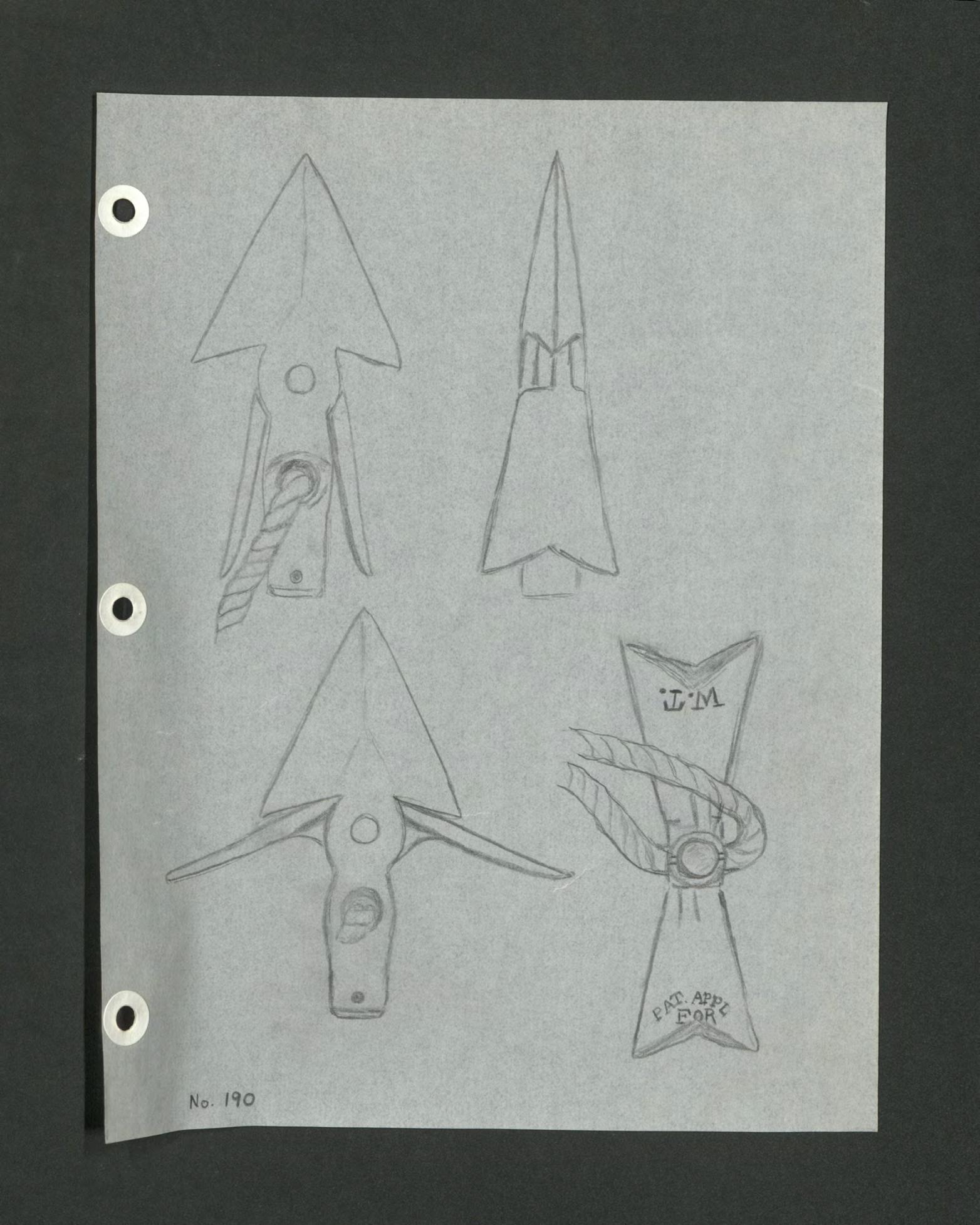
NO DESCRIPTION MAKER*S MARKS SHIP'S MARKS APPROX, AGE
190 Brass "Swordfish" type harpoon, with two moveable flukes; arrowhead point; line f00171 hole,with old 29-" long : ' doubled line, seized in three places. Head is detachable from shank in typical "lily iron'" fashion. Near end of 7/16" dia. socket are two 1/16;" holes 180 apart for pin to temporarily hold head to shank. Although this piece i came came with a typical 15'+ wood pole with attached steel shank, I did not feel that it was original to the head as the fit was very poor, so I separated the two pieces and fitted the pole/shank combo with a typical swordfish lily head which fit very well.
W.T. (William Taylor, Portland, Maine) *
PAT. APPL, FOR (both marks are stamped on undersides of flukesmakensfsmark one fluke, and patent info, on other)
1878(~*) Spring, 1982
DATE OF PURCH. WHERE PURCH.
Although this is undoubtedly a harpoon designed for swordfish and other large fish, it has been considered by students of harpoons as a possible whaling harpoon, as there is no indication in the patent documents of the size of the harpoon head. As far as can be determined there has never before been an example of this harpoon in any collections. It is expected that this very one will be illustrated in T. Lytle's forthcoming book on whalecraft, and while it now appears to me that this harpoon was probably never intended for whaling and probably never made in a large "whale size", it will most likely always be included among the numerous rare and unusual patented whaling harpoons. The patent number is 206,691 and was issued Aug. 6, I878 to William Taylor of Portland, Maine.
Fred Hatfield, Sheffield, Ma. (who bought it from a picker from Maine)
NO. DESCRIPTION MAKER'S SHIP'S APPROX. WHERE DATE OP MARKS MARKS AGE PURCH. PURCH.
191 Unusual, rather primitive toggle head harpoon of uncertain origin. Head has peculiar profile with no real "barb"- just a deep, nearly vertical step about midpoint. Head about 8|" long. Head made to sort of wrap around shank, the trough apparently made by crudely hacking out the metal from a solid block of iron or steel. The finished product does not have a crude feel, however, and has the patination of moderate age. The shank is fairly heavy and at the head end terminates in a sort of "needle's eye", which is offset. There is little doubt in my mind that, although very short, this iron was designed for major sized whale hunting, and the attachment pin is 3/8" dia.. Socket is irregular, "bumpy"& heavy with no visible seam. Diameter of socket is 1-5/8" at max. Most unusual of all - and as yet still unexplained is the existence of a heavy metal "plug" within the socket. This plug is just ever slightly less in dia. than the socket itself and Is permanently pinned into the socket 'from two sides (180°apart) by nearly invisible pins. Only li" of the socket is clear before the plug is encountered. How can one,attach a wood"pole to this iron?? That remains the question; and why the plug?? OA length - 2?-3/8". Cond. - good. Two "splits
No maker's or ship's marks -fit' !X '
on top of head. "
19th cent.(?)
Barbara Johnson Collection (label affixed to socket)
Although this iron is described in q&+h 338) at N. Y. the auction catalog as a Long Island ^otheby s Sept. 25, 1982 Toggle Harpoon used in shore whaling, it does not have an American look about it to me. The profile is strongly reminiscent of pictures of Japanese whaling irons - which perhaps it may be. Hopefully more info, may arise in the future regarding this piece (Notes made 4/2/83)
Ho. lct Z
192.
NO. DESCRIPTION
MAKER'S MARKS SHIP'S MARKS APPROX. AGE WHERE PURCH.
192 Very fine Amer. single flued iron with | fairly long recurved blade, very good cond. -—-y in general, although ;OOJ3j socket has a moderate amount of pitting and scale. Small remnant of original rope serving (l"tol|M) just forward of the socket. OA length - 35i". This iron is unusual, in having what is probably its original wood sheath It is made of two halves, nailed and served together with marling ; painted with original black paint. Sheath is ? 7/8" long and has unusual strongly concave rear edge. The sheath is secured to the iron by an oak pin, i" dia. with rect. head with chamfered corners. Pin was almost assuredly made from a whaleboat chockpin. Pin was originally secured to sheath by old rope which is no longer present. Interior of sheath reeks strongly of whale oil
D. GRAY(Darius Gray New Bedford I836-I852?) mark on head one side
Unusual again in having marks of two different vessels1)one side chiseled HEDKCM(N is reversed) Bark N.D. CHASE"- Beverly, Ma. ca 1851 same side has^(probably boat of other ship) 2) opp. side chisel marked B»M«A*(most likely for Bark MARY ANN - New Bedford (same period) That side also has111 for the waist boat of the N.D.CHASE.
Ca. I850 joggph parj_ Auction estate of Robert Newell (Whale House Studio) West Norwalk, Conn.
* It is very exciting to find an iron with 3/lV83 the marks of two vessels. At present (5/14/83) we have only one other in the collection (item 125). In that case there was a clear connection between the two ships - here we can find none. Examination of the placement of the marks leads me to believe that this iron was first on the Mary Ann and then for some reason was transferred to N.D. Chase.
DESCRIPTION
MAKER'S MARKS \ SHIP MARKS' APPRQX. WHERE PURCH.
Very fine Eng. Greener gun iron from "late" London &08O j South Seas Fishery. Doubleflued head of the smaller size typical of that fishery, but unusual in that it is minus the "stop-withers". I think it was probably made that way, but thr may also have been ground off very neatly. No pitting, but iron appears to have been cleaned "shiny bright" in the typical British manner. OA len. 44", width across the barbs, 4|"; dia. at butt, l-l/8"+{ sliding ring missing.
very faint markings, on bossesW. GREENER B (probably for Birmingham)
on opp. bosss (M) ARGARST LONDON RS 184-9 I suspect RS is the blacksmith who made the iron for Greener
Lloyd's Register for 1350 lists a whaler MARGARET from London, a Prize vessel, bound for the South Seas in 1849
DATE OF P;JRCH.
Rod Cardoza, San Diego, Ca. (this was one of a lot of 5 identical irons, which he obtained in one lot with a Greener gun at Butterfield's Auction Spring, 1986
Reproduction Temple toggle iron made at Mystic Seaport in a limited edition, ha«y forged by blacksmiths to commemorate the 100th ann. of the Driggs shipsmith shop (Merrill's wharf, 1885)- This is rather a, a poor copy of Louis Temple's original style harpoon, with oversized socket and and flat topped (V10 head, 7/l6" thick. OA len - 32" marked on side of head MYSTIC, opp. side 198b, and below head 013, indicating the 13th of the series to be made
Ordered Dec., 1985 t'c/<j -a£ e, ~h *~ea *"•c. pi\Zoi- 3
NO.
195
MAKER''S
DESCRIPTION MARKS
Good American darting gun iron with temple\type head. Some lite pitting in some areas. Much remains of original orange paint. OA len.- 38-3/8"."
Mc k M a d
d to
1'k)S iroA hi-" lotH /on ! a rod bU O^y, /
:z^.mbLU- ,*4
:SKIP'S MARKS APPROXv 'AGE WHERE PURCH. DATE OF PURCH.
MAC(Y) 'on head
crosswise
(E.B. & F. MACY, New Bedford)
No signs of ships marks - possibly never used as perfectly i860';
Arner. Greener gun iron with Temple-type head, rather large and heavy and with strong upward curve at tail. Light to mod. pitting. Oa^len 43-5/8". Butt dia- 1".
Sliding ring missing. Quite possibly this is from the Cal. Gray Whale fishery. Auction caption states it was originally found in California.
No legible maker's marks
Sotheby'si
Barbara Johnson sale #4 lot 124 Dec.„ 1983
SB chiseland center punched marked on both sides of head i860's (?)
Sotheby's
Rather short hand thrust iron w/ Temple-type head, good cond. mod. pitting only near start of socket. Oa len - 30i" clearly stamped on head
5. PARKER (Nantucket)
No signs of marks
Johnson Sale Lot #123 Dec. 1983 ship's 1850 s-1860's Bourne Auct. 1985
MAKER'S NO. DESCRIPTION MARKS SHIP'S MARKS.1 APPROX. AGE WHERE DATE OF PURCH. PURCH.
198 Amer. single flued iron X&rrpri in good cond. with light pitting on shank and socket.
OA len.- 37 5/8" Short rope warp, approx 10|"long. Socket opening 1 5/8" dia.
J. D.(on boss)
(James Durfee, N.B.)
Chisel marked: (on opp.boss) S. BAL (prob. for Ship Balaena, N.3. or. Ship Baltic, Fair-haven^,bent I also vert chisel slash-for Ww-berrt* *- on same boss 1830's-1840'sT?) as maker's mark
Dick Orcutt, Waldeboro, Me.
May,198^ $275-
199 Amer. improved toggle iron f-^77 in very good condition. Acute barb, very sharp? some slight traces of red paint, especially on the socket? Oa len.- 315-" some slight imperfections or pock marks on one side of head | casting.
A. J. (P) about 50^ lost by sharpening (A. J. Peters, N.B.)
BK PLA (Bark Platina) ^chisel marked one side of head s B (startoard boat) opp. side 1902-1908 (from^Peter's beginnings in his own shop, to the last voyage of the Platina)
R. A. Bourne Auct. Oct., 1985 $275.
DESCRIPTION
MAKER'S MARKS
SHIP'S MARKS
Portuguese style toggle iron from the Azores o^ Madeira; shows signs of age and use; head casting on left side has 3/8" long slot worn through - probably from imperfection in fitting and flattened fore end of shank cutting into the heads this is especially true since this iron does not open more than lV$ degrees (as is common with some Azorean irons) in and I believe brings great pressures to bear upon upper edge of the head when fast to a whale. Acute barb is somewhat rounded and worn. Socket applied around shank end, as was commonly done by the Azores blacksmiths. Cond. s good.
OA len. 32"(-) single centerpunched
APPROX. AGS WHERE PURCH. DATE OF PURCH.
in each end of indent
eej?J|Qnchad S B or S 8 - possibly the smith,
owner, or harpooner
20th cent. (?)
Osona Auct. Nantucket 6f?) 75"/
Oliver Allen's barb patented gun harpoon with shoulder and socket, but minus rear shank. The head and shank are virtually identical to item 131, with the exception that the length ~ I ? from tip to end of socket is 26"(in lieu of 29-1/8" on item 131 The ipterior of the socket is slightly tapered at the mouth, and I suspect that this iron is designed for a wooden rear shank, one of the three variations which Al fin made. The + shaped iron shank (as in NO. 131) and the iron tube, would be solidly welded or brazed into the socket, while the wooden shank would be merely slip-fitted, and would often turn up today minus the rear member. The two similar irons at N.B. Museum, Lytle No. 903 & are both about 26"long, as is the complete wooden shanked example in Lytle*s personal collection. Cond.- good; black paint overall, possibly a repaint.
No marks of any kind ca. 1850
Farmington Flea Market
June, $225 1986
NO. Description
202 ~r?1
Maker1s
Nice early grommet iron for porpoise or large fish? probably American} socket well formed in traditional Amer. blacksmith manner; open seam; good condition, with mod. pitting on socket, and except for bend in one "corner" of socket; end of shank formed into a flattened "eye" over which the head is very loosely fitted; pivot pin quite thin - perhapsf" smoothly cast head, with no barbs, gromet missing; OA len - 26?"
Head capable of toggling about 135 degrees
No marks of any kind
19th Cent. (?)
Bud Cobb May, 1985 $110.
203 Extremely unusual, possibly one of a kind, double-shafted swivel barbed, or "Lily" iron, for porpoises or large fish. Each shank has a double barbed head, and the head of one shank is set in a plane perpendicular to that of the second shank. The shanks are very heavy, approx. 5/8" in dia. and join to form a large U shaped configuration - with the arms of the U approx. 7" apart. There is a single heavy socket welded to the center point of the U. The socket is 5|" long and 2 in dia* at its opening. The seam is closed in the typical English manner. There are some minor remnants of old rope around the neck of the socket. OA Length - 29". Condition is fair with moderate pitting on heads and shanks and rather heavy rust flaking on socket. Weight approx 6 lbs. X find the design of this harpoon quite mind boggling, and can only suspect that it was made for some Goliath of a man who wanted to be certain that he didn't lose his fish.
lhere are no marks of any kind on this harpoon
JE, \J 1,9 8S Bcuw<L
Auctioneers tz. (4Av"poCjJ '•&) (Lon.yic skan/k. l i if.. _ UpujeOtr, -f/y
19th-20th cent. (??)
Auction in Middletown, Conn. 4 11iw kca di Iyjert Vic*" in ' jS I {Ms 0ZC3
Sept. 1986 $357P
NO. DESCRIPTION
MAKER'S MARK? SHIP'S MARKS
204 Improved toggle iron, acute NH 6536 barb, on old wood pole. Pole • is from sapling trunk, untooled; /J round cross-section; approx 5 feet long and 2§" in dia. de-barked, axe shaped only to fit into iron socket. Iron has original old rope 40" long with braided eye loop; seizings are gone; some remnants of marlin remain on socket of iron; Iron is 33" long, and has moderate amounts of pitting and rusting; barest remnants of orange paint on some areas of shank;(head is at present "frozen")
no noticeable maker's marks
APPROX. AGE WHERE PURCH.
DATE OF ,PURCH.
chisel marked on head SJ3 (one side) and CWM (Charles W. Morgan) on opp. side (these marks appear authentic)
At about midpoint, wood pole is ' carved out ZB (or SB with the 3 in reverse)
It is most unusual to find Biarpoon poles marked, but if authentic, which they appear to be, these marks could stand for the boat or the harpooner
late 19th or early 20th cent.(?)
Bud Cobb (through Ryan Cooper)
Jan. 1986
$385-
205 NH6868 Modern "acute" toggle iron in good cond.; shank shows considerable evidence of rippling, twisting and contorting from conflict with the whale. OA length - 30-7/8"; a few old defect pock marks on the rear of right side of the head
MACY (S.B. & F. Macy, N.B.)
chisel marked one side of headL_B (larboard boat); on opp sideBK SBM (Bark Sunbeam) prob. last quarter of 19th cent.
Sotheby's, N.Y.C.
Auction Dec. 1986 (one of lot of four harp. + iron Mace) 1700 the lot
20?
\ool
DESCRIPTION
MAKER'S MARKS SHI?*S MARKS APPROX WHERE' PORCH. DATS .OF PU.RCH•
Very rare British single w • ,y. shanked harpoon for Sreener type bow gun. Double flued head without stop withers. Possibly made for an American market or more likely for the later British South Seas fishery, which was most likely strongly influenced by the American whalers. (Note item No. 193 - British made 1349 less stop withers and for use in the southern fishery). Single shank is 3/8" to 1/2" thick and has sliding collar with substantial rope(5/8" O.D.) becket. Rope passing through eyes of collar is protected by by circular iron thimbles. nutt cylinder is rather small, being ohljllJ^/l6Min dia. x 1-3/8" long.
OA length of iron - 4-2". Condition is excellent.
3C0RRAR (on boss) LONDON (opp. boss)
(Wm. Scorrar, Fore St., Limehouse, London) see attached letter and map from Museum of London No ship's marks 184-0's-1850's(?)
Sotheby Auct. N.Y.C. Dec. 1986 (part of lot including item 205)
large American double flued harpoon with head 4—3/4" across the tips.
OA length - 40". Hand darted type. Fine condition.
J(?) M (on boss) (probably Josiah Macy, Nantucket or New Bedford)
l840's(?)
Notes Auct. catalog says iron had perhaps earlier tag saying that it was used by a Capt. Hillman, but tag was lost by auction house
R. A. Bourne Auct. Hyannis, Ma, Aug., 1986 3225.
2
Please reply toMuseum in Docklands Project, Units 39/41, Cannon Workshops, West India Dock, London E14 9SU Tel. 01 515 1162
Robert E. Hellman, 35 Harris Road, Katonah, N.Y. 10536
U.S.A.
24 February 1987
Dear Mr. Hellman,
Thank you for your letter of 24 December 1986. I am sorry not to have replied sooner. You certainly are discovering some important artefacts relating to London as a whaling centre.
I should have explained more clearly about the Lloyd's Register. Yes, you were right to think that Lon. S.Seas, refers to the Southern Whale Fishery. I am not sure that it is known for certain what might have been the "typical" Greener type gun irons for London South Sea Whalers at this period. The London trade had declined considerably by the 1850s.
Your new acguisition of another interesting harpoon with a London connection has required some additional research. I have scanned through the London trade directories as well as the parish rate books in search of the name Scorrar.
I discovered in the rate books for the parish of St.Anne's Limehouse in the year 1825 a Scorrar occupying a house in Fore Street in Limehouse. This riverside parish was made up a multitutide of tradesmen and manufacturers who provided the ships' with supplies and equipment. London's considerable South Sea Whaling fleet, estimated at over 100 ships in 1825, would have been Scorrar's main market. However, there issome evidence that he was exporting harpoons to Australia and possibly to America. One of the main docking areas for the fleet was along the City Canal just to the South of Limehouse. The first trade directory which has a heading for harpoon-makers dates from 1844and it lists him as "Scorrar Wm, 31 Narrow Street Limehouse" He seems to have lived and worked in Limehouse from 1825 to 1860,
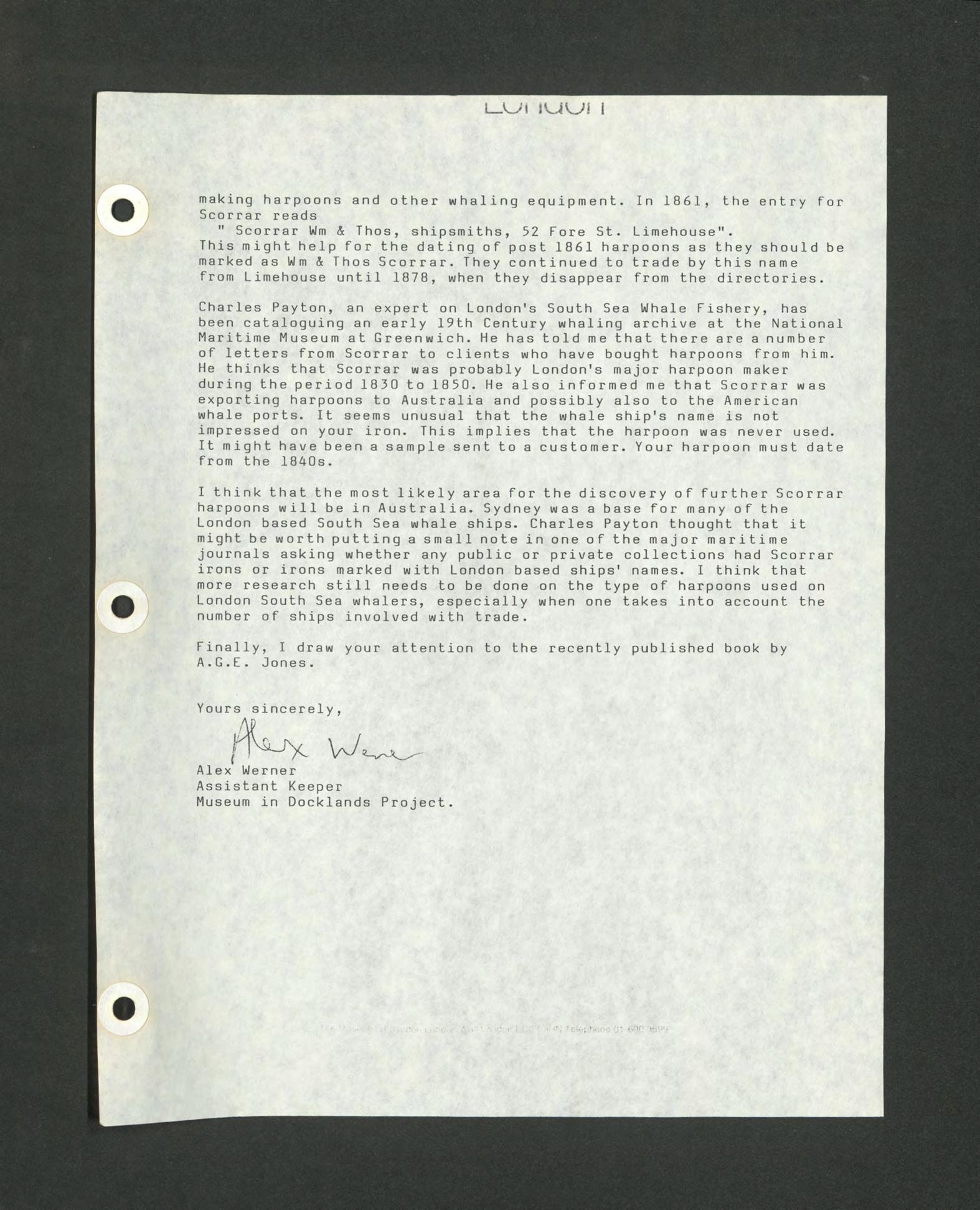
making harpoons and other whaling equipment. In 1861, the entry for Scorrar reads " Scorrar Wm & Thos, shipsmiths, 52 Fore St. Limehouse" This might help for the dating of post 1861 harpoons as they should be marked as Wm & Thos Scorrar. They continued to trade by this name from Limehouse until 1878, when they disappear from the directories.
Charles Payton, an expert on London's South Sea Whale Fishery, has been cataloguing an early 19th Century whaling archive at the National Maritime Museum at Greenwich. He has told me that there are a number of letters from Scorrar to clients who have bought harpoons from him. He thinks that Scorrar was probably London's major harpoon maker during the period 1830 to 1850. He also informed me that Scorrar was exporting harpoons to Australia and possibly also to the American whale ports. It seems unusual that the whale ship's name is not impressed on your iron. This implies that the harpoon was never used. It might have been a sample sent to a customer. Your harpoon must date from the 1840s.
I think that the most likely area for the discovery of further Scorrar harpoons will be in Australia. Sydney was a base for many of the London based South Sea whale ships. Charles Payton thought that it might be worth putting a small note in one of the major maritime journals asking whether any public or private collections had Scorrar irons or irons marked with London based ships' names. I think that more research still needs to be done on the type of harpoons used on London South Sea whalers, especially when one takes into account the number of ships involved with trade.
Finally, I draw your attention to the recently published book by A.G.E. Jones.
Yours sincerely,
Alex Werner Assistant Keeper Museum
in Docklands Project.
NO. DESCRIPTION
/yiA.RKS
208 Unusual Canadian harpoon |RS>jrfc|(C)r possibly»though unlikelyI . zJ some type of gaff).
Reverse barb somewhat similar to "stop wither". Heavy shank 9/16" od. Closed socket.
OA length - 224". Intricate braided rope attachment starting about midpoint and extending to rear for about 5"» then breaking away from shank to form a loop about 12" long of 1/2"+ dia rope. This rope and braiding is very brittle, quite old in appearance, and mostly intact at this time. There is a braided lighter rope "collar" about an li" long which appears to be of a later origin, and which has been applied just forward of the main braiding. The latter is is quite frayed at forward and especially rear edges. Condition of iron is fair with overall moderate pitting.
No maker's or ship's marks late 19th or early 20th cent. - though perhaps earlier
Robin Starr, at Farmington, Conn Flea Market June, 1987
209 Another iron very similar to the above from the same source. OA length- 26".
Condition somewhat worse than item 208, showing;the effects of moderate to heavy corrosion throughout. This iron is rope rigged in a similar manner to the above, although the braiding is more worn and the rope loop has broken away from the braid and is now attached with twist ties. The rope loop is made of just slightly lighter rope, somewhat under 1/2" diam. There is no forward rope "collar" as described above.
„ , No marks of any kind
NOTE: ditto
These irons were found by Mr. Starr in Lunenburg, Nova Scotia. T"showed pictures of the irons to Arthur Credland iXJjha Whaling Museum in Hull, England, and he thought they were either gaffs or shark harpoons. I showed the irons to Klaus Barthelmess os Cologne, unR. who thoughj-thep walrus lr irons.
MAKER'S SHIP'S APPRQX. WHERE DATE OF NO. DESCRIPTION MARKS' MARKS . AOS Purch. PURCH.
210 Small double-flued gun harpoon, British, with two moveable barbs. New condition} completely "blued" except for head and removeable segment 1-1/8" long at butt. Shank slotted with l/k" wide slot for most of its length (slot 19" long) Shank dia. - 11/16". rear end of slot has spring type "shock absorber" approx. 1" long. Sliding ring, roughly 4" long x approximately rectangular in shape, 1" near shank and 3/^" at distal end. Ring stock approx. 3/l6"dia. steel rod. Harpoon is 25-3/8" OA length. Butt end has slot to facilitate removal.
Deeply engraved on shank about 9" from butt ends
T. BLAND & SONS (for Thomas Bland kjO West Strand, LONDON Sons, London)
1880 s (?)
Maritime Auctions Eliot, Maine Oct., 1987 $130.
211
Scotch double-flued Greener gun harpoon extremely deformed and twisted by conflict with a whale. Very large head with stop withers. Tip broken off, probably by contact with a bone during conflict. Somewhat deformed slide ring made of two strands of 3/16" diam wire twisted into rope, remains, but thimble is missing. Butt dia. 1-3/L" (+). It is virtualy impossible to measure the original lengta of this iron but it was probably in excess of ^-8". Present length of deformed remnant is 31". Shank is slotted 90 degrees to broad plane of head, in typical Peterhead, Scot, fashion. Black painted overall (over red primer), probably original.
On one -boss- (?). R. MITCHELL& SON PHD (Peterhead, Scot.)
On opp. boss - ARCTIC l86l (Peterhead whaler)
* Supposedly acquired by Mr. Cole from Fairhaven family of Ambrose Bates, who sailed on Am. Provincetown, Ma< whaler V. DOANB in the 1860's of
Chris Cole, Pawcatuck, Ct. at No. Salem show April, 1988 $350.
NO. DESCRIPTION
MAKER'S SHIP'S. MBB MARKS MARKS
American toggle iron strongly att ibuted to Lewis Temple. Unusually long - possibly the longest toggle iron in present collections - OA len. - 42".
"Temple"style head with the rather distinctive sweeping outline peculiar to known examples of Lewis Temple's work and to very few other makers (see item No. 136 - a known Temple made iron). This iron shows the evidences of much age and use - the shank being quite "wavy". Condition is only fair having moderate pitting throughout. The head also shows some evidences of heat which had to be applied in order to free it from its frozen condition. The socket has has a two inch long indented scar near the forward end about 45 degrees from the typical "open" seamj this scar is probably a defect in its manufacture.
APPROX. ACS
WHERE PURCH
DATE OF PURCH.
Unfortunately the makers marks are only fragmentary and suggestive. There is a definite letter T located on the head just forward of the cheeks; and there is the faintest suggestion of the letter L in a different part of the same side of the headthe latter may only be a corroded depression and not a letter at all.
On cheek opposite to the side with the maker's marks are chiseled M J C (or 0) - If it is MJC, as I believe, the C has been rotated in error so that the opening faces upward - a possibility if the one marking the iron became distracted and struck the chisel inthe wrong area. In that case I believe it to be from the New Bedford whaler MAJESTIC. If the letter is an 0 which has never been comnletely closed - I anrat a loss to suggest a vessel to fit that combination.
On cheek opp. from ship's letters are three heavy vert, chisel slashes to indicate the 3rd or WAIST boat.
ca.1850
Bud Cobb, at Farmington Flea Mar. June, 1987 $125
MAKER'S SHIP'S APPROX. WHERE DATE OF NO. DESCRIPTION MARKS MARKS AGE PURCH. PURCH.
213 Nice American "Temple-type"
!75n?Tl to&§le iron, in good cond. L -~J-j Rather small head? elongated socket. Very little pitting. Painted overall with black , probably original (most of paint was removed from head as heat had to be applied to unfreeze head). OA len. - 31-7/8" Head length - 6-1/8"
J. T. & (CO.) stamped into tail end of toggle (for James and Thomas Durfee, New Bedford)
Very unusual, the ship's name is is impressed into the head just forward of the cheeks using a small stamp which reads S. OME(GA)- most probably for the Ship Omega of Fairhaven, Ma. (there was also a Ship Omega from Nantucketbut it is unlikely that it would have carried gear by a New Bedford blacksmith).
Along the lower edge of the left cheek are a series of four punched dots, thus: ....- these indicate the 4-th boat , or BOWBOAT. It is also unusual to indicate the boat by a single horizontal row of dots (usually there will be a series of vertical dots, if the center punched dot method is chosen)
NOTE: ALL marks, both maker,s and ship,s are on the left side of the iron (another unusual arrangement)
1850's
Farmington, Ct. Flea Mkt. June, 1987 $95.
Almost certainly the JT&CO mark was actually first used in 1857, since the OMEGA and the MARTHA sailed in Sept. and Nov. 1857, respectively. The most unusual maker stamped ship's marks may have been an "Opening Day Special" (it was common for the English blacksmiths to prestamp vessels marks)T or, less likely, this may have been by special request of the Owners or Agent.
c*% ; > ^
Shortly after cataloging item #213, we acquired this Temple-type toggle iron with a virtually identically sized and shaped head, also marked J. T. & CO on the tail end. (This iron is presently in the collection of P. Vardeman of Kansas City, Mo.).
J (James) T (Thomas) (Durfee) & CO. was of very short lived duration under that tradename - according to Lytle, Harpoons , it was formed in 1858 -M when_Thomas's son Zoheth joined the firm ?2tiitaWaSn^ss2lved when Thomas retired. This harpoon is stamped by the maker S.(Ship) Marth(a), item 213 is stamped S. Omega
Both vessels were managed by Nathan Church of Fairhaven and sailed in'^1857^
NO• DESCRIPTION
.214 JoToo]
215 [USD
MAKER' MARKSSHIP'S 'MARKS . APPROX, AGS' "
Very fine, extremely short Double-flued iron in excelltnt cond.
Amer. OA Len. - 26- 5/l6
Traces of black paint, espec. on socket, which is fully, but warnly, painted. It is unusual to see a whale iron, as this is, made in such a reduced length.
F(?) &(?) BARRITT
(these marks are very difficult to read with any certainty - I can find no BARRITT's in the New Bedford directories in my library. However there are several BABBITTS, although none listed as blacksmiths My inclination is to call it BABBITT although I can see noindication of the return on the lower loop of the letter B.)
chisel marked faintly on boss 3 A A across the maker's mark I feel this can only stand for SHIP ATKINS ADAMS of Fairhaven, or the famous SHIP ANN ALEXANDER of New Bedford. Two chiseled vert slashes on QBPAbosg„- prob. star. M boat
Extremely long, early Amer. double flued iron which might truly be called an "Arctic iron" owing to that great length. Hd. rather small with straight trailing edges. Moderate pitting overall. Socket rather short. Shank shows evidence of many straighteningsvery wavy. Traces of black paint overall. OA len. 46|"(+)
?§$(5s-?§50s R.A. Bourne Auction Nov. 1938 S200.
Deep rectangular depression on head (approx 1/2" x 5/16") within which are sty .lized raise^ letters which appear to readfjf"aJ - probably fcr TIMOTHY AKIN, U a New Bedford blacksmith of the 1840's
.to- Ship's marks hu.i 1840*s ec -i > C Morgan Sep t. Levine^ 1988 (from his personal collection)
^rOO
DESCRIPTION
I 216
MAKER'S MARKS
Unusual extremely long double flued "Arctic iron" very similar in most respects to item 215* Head is somewhat small with straight trailing edges and unfortunately has been recently resharpened and perhaps also somewhat reshaped. OA len. is K6i" almost identical to item 215- Condition is very good with scarcely any pitting. Old black paint generally overall. Long nicely formed socket.
No maker's marks
chisel marked lightly on head OP » which might represent the bark OSPREY of New 3edford ???
1850's(?)
l.o d ^ 0# 1
R.A. Bourne Auction Aug. 1986 •3375.
Robert Brown 1st Model gun harpoon with fixed double-flued head Lance point has been lost and has been replaced by a simulated point of flat steel which has been painted black to differentiate it from the original antique harpoon. Iron is considerable pitted and corroded Faint traces of red paint thruout together with remnants of black paint. There is an old paper lable pasted to center of shank, much of which is torn away, upon which is pencilled GRAM-PUS. (This is a mystery as there was no whaleship by that name.')
Length of antique iron 3V. OA len. including reproduction lance point (which I made) is 36 3/3 Shank wavy. Flat of head stamped on both sides PATENT
NOTE: see items 132, 132a, and 1?K for later & "improved" models of Brown's gun iron
traces of what appear to be center pundfed ship's marks which are completely unreadable
1850 (date of R. Brown' original patent )
-Ati5nurne uc Aug. 1989 3220.
No. 216
# NO. DESCRIPTION
MAKER'S
216A Very long American double flued whaling iron with an unusually short socket - only 3" long(perhaps it was shortened). OA len. 44-7/8"
Straight lines to barbs - both cutting and rear edges. Good condition with only very light pitting
one boss with deeply impressed rectangle 7/16" long x 13/32" high with raised block letters which appear to read "PH" - so far unidentifiable qh I OR R/J j
opp. boss faintly chisel marked "S(.) S ???". There appear to be markings after the 2nd S but they are too faint to read
1830's -1850's (?)
Willis Henry Auc 2/15/97
NO.
218
DESCRIPTION
MAKER'S< MARKS SHIP 1 S MARKS APPROX. ACE WHERE PURCH.
Very fine Araer. single-flued rry—2]iron from Nantucket. Iron is jylPVif in excellent "used" condition with no pitting. Shank is wavy from use and probable repeated straightenings• Socket is completely served with old marlin. Just the faintest traces of old black paint overall. OA length - 36 3/4".
deeply stamped on one boss: E PARKER **
*** It is very rare, almost unheard of, to find the Port of Call indicated on a harpoon.
DATS OF PURCH.
clear, deep chisel marks opp boss from maker's mark: ABBIS. 3.D. (for schooner A3BIE BRADFORD) *** NIT ( for NANTUCKET)
on same boss as maker's mark are the following chiseled characters.: 4• B. M X (Parker's mark between the M and the X) this is a mystery: the bottom of the L is curved, so it might be a reverse J. If it is an L than it could stand for LARBOARD BOAT MIDSHIP - if that is a term to describe the WAIST BOAT on a schooner? If it is a J, reversed in error, then it might be for JOSEPH B. MACY, the owner (or JOHN ? MURRAY, the master). I have no ideas about the X following PARKER, unless it signifies the boat.
*A3BI3 BRADFORD, a two masted schooner 114 tons, built in i860 in Scituate, Ma. first appears as a whaler for J.3. Macy out of Nantucket on two short Atlantic voyages 1867-1868, and 1869(5 months) She was sold to Jonathon Bourne of New Bedford and sailed for him on 9 voyages from 1872 to 1888 when she was condemned in Brazil. In 1869 she was one of the three whalers which sailed from Nantucket - the last whalers to sail irom that port. (See item 125 for another fbABBIE BRADFORD iron)
** some notes on 3. PARKER:
1867-1869* Auction in N.J. Jan. 1989 p350. (?)
2LI3HA PARKER begah as a blacksmith on Nantucket in the 1840 s and is listed as one of the smiths reopening a shoo within 7 weeks of the devestating fire of 1846. It was on CROSS WHARF (later called STILL DOCK ?) and he remained at i4at job to become the last whaling blacksmith in Nantucket (I869) and until he; was crippled by a stroke in 1880.. He died in 1884. The Parker shop continued under his son Clinton Parker who sold the business in the early 20th Century to Aquila Connie, who became the last oldtime Nantucket blacksmith in his shop on Straight Wharf - now the Four Winds Gift Shop, (see items 103 and 197 for other Parker irons)
:,o IP23GRTPTION i-iA,^'S ,.mis mn *3 •MarxsJ
!19
APPROX. AJ.3 WHERE FUROH« DAM PUR OF H,
_Long,^two bladed "Lily" (porpoise or large,fish) iron'with r elatively large . sized triangular head followed by two very long leaf shaped swivel oarbs, rotating around a single i"(+) oiameter pin. Iron.^ is very heavily pitted and corroded" throughout. Socket appears to be a replacement, but is also Heavily pitted. One swivel barb has sizable piece missing near distal end. Painted overall W/5h fairlW recent gloss .black. Socket with 1/8" hole for pinning to wood pole.
OA length - 30J" length -
Hone None 19th/20th cent.
Bud Cobb at Farmington Flea Market (He bought it at Auction at Whites Rest., Si. of Fall River, Ma. about aweek earlier) Sept., 1989 3200.
220
Unusual iron for large fish or porpoise with conventional whaling obtuse toggle head. Head mtd. with whaling sized (3/8" dia.) pivot pin but has never been drilled out for wooden shear pin. Butt end of conventional harpoon shanx has been threaded into a small short (2-5/8") socket which seems to be constructed by welding onto a |"(?) dia. hexagonal nut (shank of harpoon is threaded into that nut). Butt end of socket has two 1/8" holes 180 degrees apart for stewing to wooden pole. General light to moderate pitting overall. Some very slight traces of red paint (just a fleck here and there)
OA length 32-3/4" A MOST PERPLEXING PIiSCE NONi HONS Late 19th Cent.(?)
RobertEldred Auction E. Dennis Ma. OCT. 1989 377-
m
]0tO6]
DESCRIPTION
219-A Two bladed "swivel barb" iron or "Lily" iron for use in capturing porpoises or large fish. Two 5" long x 1-1/8" wide leaflike blades which rotate around a 1/4" diameter pivot pin. Just forward of the barbs is a small triangular shaped fixed head. Moderate to heavy pitting and rusting especially on the socket. Socket has an open seam somewhat unusual in that there is a rather large teardrop shaped opening at the forward end of the seam. Shank somewhat wavy showing signs of heavy use. OA length - 34". This item is in many ways very similar to item 219 which it is replaces.
No maker's marks
No ship's marks 19th cent. (?)
Robert Skinner Auct. Galleries Bolton, Ma.
8/18/97
$250. (?)
MAKER'S SHIP'S APPRO*. WHERE DATE OF NO. DESCRIPTION MARKS PIARKS ASS FURCH. PURCH.
Double flued Sreener gun
iron with rather long narrow head, with stop withers. Almost certainly made for the late British South Seas fishery - much less common than the huge headed Arctic Sreener gun irons freque My seen. Cond. good to fair with overall brown coloration and light to moderate pitting. OA len.- ^5^"* Dia. at butt end - I,:". Slot is at right angles to the broad axis of the head. Slide ring missing.
Stamped on boss; W SREENER 1353
Also stamped, on the same side immediately ahead of jj the forward end of' slot is the numeral 3 (meaning of which is unknown to me - perhaps it represents the bore of the, gun No legible ship's marks 1853. S. Lang Fort Washington, N.Y. 19b9 ($&.
p/ofi
223 rate, most unusual single fluec har; oo i, x hand thrust, with a second, moveable barb, positioned between clevis located about 2" to the rear of the main barb, but on the opp. side of the shank. Seamless socket about 5" long and if" in dia. Small loop welded to the side of the socket near the distal end. Shank is made from k" dia- commercial steel rod. Welding is substantial in quality and ground smooth, but outlines are crude and definitely not the work of a 19th cent, blacksmith. OA. len. - 30-3/8".
The purpose or origin of this harpoon is unknown to me - but I feel certain that it was made for some type of fishing and that it is not a repro. No maker's marks No ship's marks 20th Cent, dealer Yonkers, N.Y.
Notes there were two of these pieces - nearly identical. 1939 <i>50» I bought only one. I have seen these two irons a number of times over several years. They were offered to me orig. by Jack Jacobsen of Staten Isl. but I declined. He sold them to Ellie Zellen who offered them to Nina, and later put them in auction in Bedford, N.Y. We were not at the auction. Some time later the Yonkers dealer showed them to me and I bought one - I suppose feeling destined to have at least one of these strange irons.
NO. DESCRIPTION
224 Extremely long, prob. very early double flued fT\(JO ' iron; prob. American OA len. 50-5/8" - the longest whaling iron I have ever seen. mod. to heavy pitting all over very short socket(3\")perhaps shortened. little trace of seam which is completely closed. Rear edges of head are strongly CONVEX (most DF heads have coneave or straight rear edges) Short square boss abruptly changing to round shank without any tap2KlNQ: This is a most unusual harpoon. Much late black paint.
no readable marks No marks
Large headed "Improved" toggle iron - probably a Humpback Iron Shank 7/16" dia. OA len. 30-5/8"
Socket opening 1-3/4"+ socket welded closed. I believe this to be an English iron although with no stop wither. Metal with nice patinaNo pitting. Signs of early polishing such as is frequently seen on British irons. Was acquired from the Maritime Museum in Savanah,Ga. along with four other English irons Toggle head "obtuse" type. OK
No marks of any kind
19th c. Jane List formerly in her father's collection (Morgan Levine,Sr.)
1992 $300?
19th cent.
Paul Vardeman who bought it from the Mus. in Savannah Dec iqqi
NO
DESCRIPTION
MAKER MARKS SHIP'S MARKS APPROX. AGE WHERE PURCH. DATE OF PURCH.
226 Extremely large Amer. Humpback iron toggle head only. OA len. 12-1/4" Obtuse design. Undrilled. Small indent at location of holding peg on right side of head. I suspect that this indent was made by a device built into the mold. Casting has been smoothoff and even sharpened. I would think that this is probably most unusual. I suspect that sharpening would be done after the head is pinned to the shank. Condition is quite good. Weight - 2 lbs. 6 oz
No markings of any nature
19th cent. R.A. Bourne Auct. Hyannis, Ma. (Bourne's final Marine Sale) Feb. 13, 1993
$66.
227
SSjII
New Zealand ftarpoon for some type of large fish. 2-3/4" long flat toggle head morticed into square sided sharply pointed head. Swivels on 1/4" dia. pin. Square sided "head" about 6V long followed by round shank about 20" long terminating in square sided spike about 3" long. Shank dia. 5/8". OA len. 29". 2-3/4" dia ring of 5/16" stock placed in hole in shank 6" from butt end Spike retains 1-1/4" fully threaded nipple 1-1/8" long which originally capped the wooden pole. Wood pole gone Condition good with moderate pitting.
No markings 20th cent.(?)
Antique dealer in Auckland, New Zealand who said it was of local origin Jan. 1993
$75 (US)
MAKER'S SHIP'S APPROX. WHERE DATE NO. DESCRIPTION MARKS MARKS AGE PURCH. OF PUR.
228 Fine Long Island "Temple ——~l type" toggle iron in unLLJLI used condition. Metal fairly smooth all over with only slight pitting on socket.
OA len. 35-1/8" Shank dia. 3/8"+
Rear end of barb and extreme rear end of head slightly deformed from being struck. Cheeks unusually short (2-1/4") Original (?) black paint .
J. CONKLIN deeply impressed in shank immediately forward of socket. This is most unusual. I have never before seen this on a whaling iron. There are no marks of any type on the head or cheeks
JEDEDIAH CONKLIN was a Sag Harbor, L.I. blacksmith ca. 1820's to 1850's(?)
1850(?) Major Marine Auction (Rod Cardoza) at New London, Ct.
April 28 1991 $660.
\Sli£l
229 Zeno Kelley's patented gun harpoon (Dec. 3, 1867) Point of head bent over Rubber cushion at butt missing. 7/8" long projection behind barrel centering cylinder has longitudinal split through center Cylinder is for 7/8" bore. Shock absorbing spring is missing. Typical two hole collar slide - rope becket missing, but remains of rope fills one of the holes. Obtuse toggle head - improved style. Wood shear pin remains. }/8"d.shank. OA len. 26-3/4" Condition good with some pitting at butt end and traces of orig. black paint
There were two projections at rear of collar slide for centering - one is bent at 45
R. Osona Auction Nantucket, Ma. (from Barbara Johnson coll.)
Aug. 14, 1993 ($440.) and the other is missing.
Z.KELLEY'S PAT(faintly) & DEC. 1867 stmpd. right side of head chiselB. GLA (Barx GLACIER,N.B.) 4. mkd. II £$arboar<f boat) 1868-1873 nsrht ^ide of Kead side of head
NO- DESCRIPTION
MAKER'S MARKS SHIP'S MARKS APPROX. WHERE AGE
DATE PURCH.OF PURC
230 Large headed British Arctic Double-flued iron with stop QJ1£X withers. When I purch. this iron in 1993 it was in two pieces, havbeen broken about at the midpoint. The two halves could be fitted perfectly together but the shank sections were bent strongly from the blow which caused the shank to break. I had the sections straightened and electrically welded by Jared Silbershur of Pound Ridge. N.Y. Cond. good with moderate pitting. The repair is visible but not objectionable. OA len. 32". Socket seam closed. Shank OD 15/32"
W.HURST 1832 stamped on one boss also WH. 1832 stmpd. crosswise near mouth of socket (this latter mark location is often seen on British irons)
PHOENIX.stamped on opp. boss. This was a Whitby whaleship active 1816 to 1837
1832 as so marked R. Osona Auct. Nantucket, MA. (from Barbara Johnson coll.)
Aug. 14, 1993
$200 incl repairs
231
HEX)
Small grommet iron for fishing, grommet missing. Slot through head to accommodate end of shank. Socket open with much corrosion. OA len. 25"+ Condition poor with muchpitting on shank,head and socket and probable considerable loss of diameter of shank which is presently just over 1/4" in dia.
NO markings of any kind
19th. Cent.(?)
Wolfe's Auct. Cleveland, Ohio came together with Darting gun ca.1989
NO
DESCRIPTION
MAKER'S MARKS SHIP'S MARKS APPROX. AGE WHERE PURCH.
232 Amer. moderately long double flued iron. Fair to good condition with traces of original black paint. OA len. 36-5/16".
Shank 3/8" dia. Tip of head strongly blunted. One cutting edge noticeably "chewed up" for about one inch about midway from point. Shank noticeably "wavy" probably from use.
A G SNELL stamped on boss.
(Alden G. Snell was a New Bedford blacksmith working alone bet. 1836 and mid 1840's. From then until about 1856 the firm became Snell&Dean when he teamed up with Henry N. Dean
No apparent ship's marks
DATE OF PURCH.
233 [mxi
Very unusual DF harpoon with head applied to shank mechanically and attachedto same by two 5/16"-3/8" dia. pins. Rather short OA len.- 30-3/4" Both rear points of head "rounded off" in most atypical manner. Socket well made. Boss square in cross section and nicely chamfered. Considerable amounts of original black paint. Shank 3/8" dia. and very straight. Iron appears to be in unused condition.*
I have agonized over this piece wondering if it is a reproduction. I am still unsure. Have seen one other virtually identical iron, in similar unused cond., about one year or so ago*at a Skinner Auction in Bolton. It was sold in a lot with other items and is definitely not the same piece. This iron was offered by Barbara Johnson at Sothebys Sale No ' Dec, 16, 1983 - Lot 128. It was est at $900 to $1200 and was bought in.
NO MARKS OF ANY KIND
7?77
mid 1830's to mid 401s(?) CD/A/ Richmond-Auct.Gal. New Jersey Jan 17, 1989
* (?)
Among the most perplexing questionsWhy are both these irons, virtually in pristine condition, UNMARKED by the maker??
R. Osona Auct. Nantucket "Barbara Johnson Coll." Aug. 14, 1993 $550.
DESCRIPTION
234 \o
MAKER'S SHIP'S APPROX. WHERE DATE MARKS MARKS AGE PURCH. PURCH.
Most unusual four barbed "LILY" iron from Maine and used for large fish. Extremely long OA len. 42" Shank OD 3/8". Small socketCOD 1-5/16" at opening. No visible seam on socket even from within. Iron has 3-5/8" long pyramid shaped very sharp penetrating point. Behind the heavy point are four 3- to 3-1/2" long petal shaped barbs, unusual if not unique in that they all are pinned at the same level rather than being staggered in pairs as is the case with all other Lily irons that I have seen. That means that each barb swivels on its own 1/8" dia. pin - making I would think a not very strong assembly. Cond. good with brown patina and light to moderate pitting throughout
NO MARKS OF ANY TYPE
19th Cent.(?) from a Maine dealer at a Brimfield Mkt. May, 1993 $110.
235 oTXT
Double flued Amer. whaling iron on original wooden pole cut from oak or hickory sapling with original serving and manilla rope "iron strap". OA len. 94" OA len. iron only - 33-3/4". Socket covered with canvas (most of which remains) which was served with tarred marlin. Hindmost 50% of serving is missing. Iron strap about 47" long and is in good shape with two points of marlin lashings to wood pole. Iron itself is in fair to good condition except for the rear end of the socket which has corrosion and metal loss especially near the open margins of the "seam". The canvas covering was probably mostly responsible for this condition as it acted as a wick to soak up and retain water if the harpoon was stored in a wet environment.
P E. MERRIHEW NO Ship's marks (stamped on boss) 1840's-50's(?)
PHINEAS E. MERRIHEW is listed in the 1855 census of Fairhaven, Ma. as a 37 year old blacksmith. The New Bedford Whaling Mus. has a Templetype toggle iron and a "Cast Steel" thick boat spade stamped P.E. MERRIHEW. We have a cast steel Sliver spade by him. Ryan Cooper, Yarmouthport who bo. from John Newton, Wiscasset, Me. May, 1993 $900
/>%iUtdfa ortgnw1 isJooden po^call /i»e$ J sc"»3S
NO. DESCRIPTION
Oizz,
MAKER'S SHIP'S APPROX. WHERE DATE OF MARKS MARKS AGE PURCH PURCH
236 Very fine large ScotchGQREENER iGUN style whaling harpoon. Large head with stop withers 6-1/8" across the points and 8" long. OA len 49-1/2". Dia. of shank at butt 1-3/8"+. Slot through shank runs parallel to broad plane of head. Original wire bridle attached to 2-3/16"OD round thimble to which is applied about 40inches of 5/8" dia. line ending in a knot. At butt end of shank slot is a 1" long shock absorber made of cork - an obviously expendable appurtenance. Cond. excellent with dark patina and no pitting.
W. CUMMING . KINNEIL (stamped on boss)
It would appear that KINNEIL is the town in which this iron was made but have been unable to locate on any map so far
JANE BO. NESS 1858 (stamped on opp. boss) This was the sailing whaler JANE of BO'NESS, Scotland. Bo'Ness is located on the Firth of Forth about 25 miles west of Edinburgh. According to Lubbock's ARCTIC WHALERS the JANE was lost in 1858
1858 as so marked purch. from the the maritime museum in Savannah, Ga. 1991
ihiNJziLI5<x|/0f"ysmall
VillageAta* 'NIss
- ih/Fo (Aitlearned Some. ScedcLP-ecpic wU 'n In e.~t m (Aad< J an.
35'o(ir)
MAKER'S SHIP'S APPROX. WHERE DATE NO. DESCRIPTION MARKS MARKS AGE PURCH. PURCH.
237 Amer. single-flued harpoon of typical mid 19th cent, design. light to moderate pitting overall, particularly on head and adjacent few inches of the shank, cutting edge quite sharp but some nicking and slight waviness due to the corrosion. Typical open socket but socket is quite short (only 3-1/2") I believe this was the original length and that it was not shortened. OA len. 34-9/16" No chamfering on boss.
A SMITH is stamped into right boss (partly obliterated)
We believe this is the mark of Allen Smith a Nantucket blacksmith who was active in the 1840's (and possibly in the 1830's) Allen Smith was originally from W. Barnstable on Cape Cod
There were ship's marks but they are completely obliterated 1830's-1840's
Shute Auctions
Ma. March, 1994 *7SO-
MAKER'S SHIP'S APPROX. WHERE DATE WO- DESCRIPTION MARKS MARKS AGE PURCH. PURCH.
238 American(?) toggle head "Greener gun" iron believed to be indigenous to California and used in the shore whaling fishery during the last quarter of the 19th century. Very large unusually shaped "improved" toggle head 9-1/8" long with strongly upturned rear. UmiBbhal in having a strongly curved (convex) upper cutting edge with a vertical return (in lieu of the "obtuse" or "acute" angled barb). OA len. 49-1/8". OD of shank 1-3/16". Slot of shank is at right angles to the broad axis of the head. There is adense wad of old fabric (?) at the rear end of the shank slot. It is about 1-1/8" in length and was most likely a shock absorber. Shank very wavy and slightly deformed from use in whaling. There is no sliding ring in shank.
lower right edge of head just forward of pivot pin appears to have lettering - ?AX? (could it have read BAXT(ER)??)
No ship's mark's and none would be expected on a shore whaling iron
1870's - early 20th cent.
West Sea Co. San Diego, Ca. (who purch. from local dealer who bought it out of a San Diego home)
April, 1994
$400.
23S Very fine American double fined whaiing iron. Exceiient condition with no pitting. Probabiy — never used. Moderately large head with curved cutting edges and strongiy curved rear edges. OA iengtn 42". Long (6") weii shaped socket with open paraiiei seam. This is a work of art as weil as a working tool.
One boss aeepiy stamped "W C" - probabiy for Wiliiam Carsiey of New Bedford (although the auctioneer, Raphael Osona said that the consignor toid him that he bought this piece from Morgan Levine who had toid him that the iron was from Nantucket. There was a blacksmith in Nantucket prior to the fire of 1846 on New North Wharf named Wiiiiam Cobb, i asked Morgan Levine and he did not remember having such a piece)
There are no ship's marks if Carsiey, 1826-56 in New Bedford and then Fairhaven
Osona Auction, Nantucket
8/10/96 $605.
• Ml
DESCRIPTION
MAKER'SM SHIP'SM AGE
WHERE WHEN
nicely shaped large headed American double flued whaling iron with convex curved cutting edges and concave rear edges. Condition fair with moderate to heavy pitting overall. Socket with some minor metal losses at opening of socket and in vicinity of seam. Considerable glossy black paint of dubious age. OA length - 34".*
* I believe this iron is of Nantucket origin as it came from the collection of Charles F.Sayle, Sr. who livedon Nantucket since the1920's and who I believe once told me that he acquired this iron on the island. Mr.Sayle died in 1 j^j^at theage of 86
There are hard to read maker's marks stamped into theboss. I feel the inscription reads "W H (?)" which I think is for William Hart, whose shopwas on Old South Wharf inthe 1840's
There aredefinitely ship's markings on the opposite boss but they are much toofaint to read
Isuspect this iron dates from the 1840'sor earlier
RaphaelOsona Auct. Nantucket, Ma. 8/13/94
$605.
# M2. DESCRIPTION
MAKER'S M SHIP'S M AGE
241 Good Nantucket-made double flued whaling ——7 iron. Cutting and rear edges are straight with only a little curvature on the cutting edges for about 1/2" forward of the rear barbs. Condition good with scarcely any pitting except for the socket, boss and the shank just to the rear of the boss. Shank is moderately wavy probably from use and straightening. Very minimal traces of red prime paint on the head and boss. OA length- 39"
On one side of boss at the juncture of the head is stamped the letter "F" oriented-fjafaHel with tlie fong axis of the shank. The exact name of the maker is not known but it is probably one of the FOLGER blacksmiths
Chisel marked on one boss "ALPHA"for the Ship Alpha of Nantucket 1834-1860 Mark faint but readabfe. Opp. boss has three (3) vertical slash marks for the waist boat of the Alpha probably 1830's - 40's
Skinner Auct. Bolton, Ma.
1/12/97 $977.50
• Mi
242 Double flued iron Nantucket-made very similar to item 241 except in poorer condition. Head with virtually straight edges which I call the early "Nantucket Type". Some slight deformities at the rear barbs and the point is well rounded off. Condition is fair with moderate pitting overall. Open end of socket has been turned in due to pounding - quite possibly it was hammered upon. OA length - 37-3/8"
The letter "A" is deeply stamped into one boss immediately behind the juncture of the head with the boss. It is done with the top of the "A" pointing toward the socketotherwise same design as item 241. Maker is not known for sure but I suggest it might be Nathaniel Atwood
The full name of the Nantucket whaleship ALPHA is chiseled into opp. boss from the maker's mark. It is very faint but readable. Alpha whaled from Nant. 1834-60 Opp. boss has three (3) slash marks for waist boat - same as item 241 probably 1830's - 40's
Osona Auction Nantucket, Ma. 8/16/97
$550.00
243 VERY GOOD NANTUCKET MADEDOUBLE FLUED WHALING IRON WITHFINELY WROUGHT LONG AND NARROW HEADWITH STRAIGHT CUTTINGAND REAR EDGES. VERY LIGHT PITTING OVERALL MUCH OLD REDLEAD PAINTTHROUGHOUT EXCEPT WHEREREMOVED ONHEAD ANDBOSSTO REVEAL MARKINGS. SHANK SLIGHTLY WAVY FROM USE ANDSTRAIGHTENING. OA LEN. 37'.WIDTH ACROSS POINTS 3-3/4". SOCKET UNUSUALLY SHORT - ONLY 3" (IT DOES NOT APPEARTO HAVEBEEN CUT)
ON ONE BOSS JUST BEHINDTHE CONNECTION WITHTHEHEAD A LARGE LETTER «F'IS DEEPLY IMPRESSED, ORIENTEDACROSS THEBOSS (THIS IS IDENTICALWITH THESAME MARK ON ITEM 241) THIS MAY BETHE MARK OF CHARLES A. FOLGER (SEE*BELOW)
JUST BELOWTHE"F' THERE ISCHISEL MARKED WHICH UNDOUBTEDLY STANDS FOR THETHIRD OR WAIST BOAT
ON THEOPPOSITE BOSS IS CHISEL MARKEDTHE FULL SHIP'S NAME ALABAMA (SEE** BELOW)
PROBABLY DATES FROM 1846, THE FIRSTVOYAGE OFTHE ALABAMA OFNANTUCKET
BOUGHT ON EBAY 10/11/99 $570.
**The ShipALABAMA was built in 1846. The Managing Owner wasJohn H. Shaw. She sailed in 1846,1851, and 1855for him and in 1863for G&MStarbuck and she waslost on that voyage
* From a Certificate of Registry in my possession for the ShipALABAMA in the year 1846,we can see that the3rd listed of the 8owners of theALABAMA was the whaling blacksmith Charles A. Folger whoseshop was locatedon Old SouthWharf in Nantucket. His being a major stockholderin that vessel I think would almost preclude the purchasing of whalecraft for that shipfrom any but his firm. If this isthe case, the"F' mark on the ALPHA iron item 241 can be attributed tothe same maker.
